
How Long Does It Take To Drive Across Texas?
No matter how you come at it, Texas is one big-ass state.
With their motto “Everything is bigger in Texas,” they seem to take immense pride in the fact.
And they have every right.
No state, save Alaska, matches the Lone Star State in terms of sheer girth.
At over 800 miles at its widest, Texas is a pit stop, double fill-up, overnight kind of place.
(Or a heck of a long drive if you want to get through its widest part in a single day.)
But at its narrowest, Texas is one of the skinniest states to drive across, only beaten by the diminutive New England states, Upper Idaho, and beach-body-ready Florida.
If you’re wondering how long it takes to drive across Texas, we assume you mean the traditional meaning of “across,” from east to west or west to east.
And how long it takes to drive across the state greatly depends on whether you’re in the north, the south, or somewhere in between.
How Long Does It Take To Drive Across Texas on I-10?
I-10 is one of the two interstates that goes all the way across Texas.
It’s also the southernmost east-west interstate.
It enters Texas in Orange (near Beaumont) in the east and in Anthony (near El Paso) in the west.
Along the way, it passes through Houston, San Antonio, and El Paso.
The distance across Texas on I-10 is roughly 870 miles (to get to its westernmost point) and takes 12 ½ hours to drive.

How Long Does It Take To Drive Across Texas on I-20/I-10?
I-20 is an interstate that goes through most of Texas, before meeting up with I-10 in the far west of the state.
It enters Texas in Waskom (just west of Shreveport, Louisiana) in the east and merges with I-10 in Scroggins Draw in the west.
Along the way, it passes through Dallas, Fort Worth, and Midland.
This combined path of interstates cuts most directly across the middle of the state and is the closest you’ll get to driving straight across Texas.
The distance across Texas on I-20, meeting up with I-10, is roughly 815 miles and takes just over 11 ½ hours to drive.
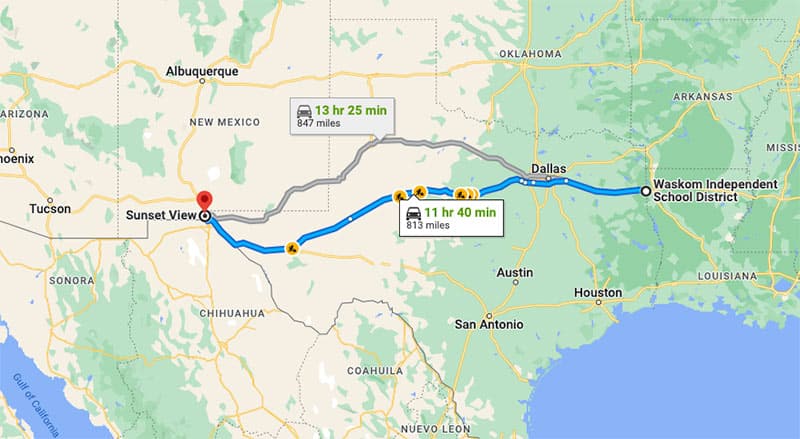
How Long Does It Take To Drive Across Texas on I-30/I-20/I-10?
I-30 is a short interstate that connects only two states – Texas and Arkansas.
It enters Texas in Texarkana in the east and merges with I-20 west of Fort Worth.
Along the way, it passes through Dallas and Fort Worth.
The I-30/I-20/I-10 path cuts similarly to the I-20/I-10 path across the center of the state and is the second closest you’ll get to driving straight across Texas.
The distance across Texas on I-30 to I-20 to I-10 is roughly 825 miles and takes around 12 hours to drive.

How Long Does It Take To Drive Across Texas on I-40?
Now that we’ve talked about how long a drive across Texas can be, it’s time to talk about just how short a drive across Texas can be.
If you drive across Texas on I-40 (the other interstate that goes all the way across the state), you drive through the panhandle, a trip that feels like a relative blip compared to the other major routes.
I-40 enters Texas in Shamrock in the east and near Glenrio in the west.
Along the way, it passes through Amarillo.
The distance across Texas on I-40 (the northernmost interstate in the state) is just over 175 miles and takes about 2 ½ hours to drive.

Of course, it’s debatable whether driving through the panhandle counts as “driving across Texas.”
Texas Interstate Drive Times
And there it is, the 4-1-1 on driving across Texas.
To sum up, here’s a handy chart on how long it takes to drive across Texas on every east-west interstate.
Plus, you know, the extra time you’ll need for all those barbecue stops.

UponArriving
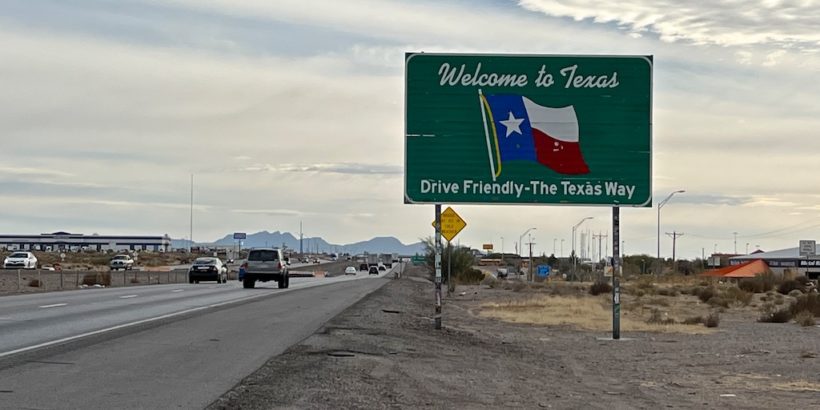
How Long Does It Take to Drive Across Texas? (Essential Tips)
Texas is a vast and diverse state and one of the most interesting states to drive through. While you can pass through a handful of states in several hours when traveling through certain parts of the country, Texas will often take you an entire day to get across.
In this article, I’ll explain to you how long it takes to drive across Texas when going through five different routes. I’ll also give you some tips and recommendations that you want to keep in mind when making your legendary journey across the Lone Star State.
Table of Contents
How long does it take to drive across Texas?
With minimal stops, the longest routes from east to west or north to south across Texas will typically take you between 12 and 14 hours but if you hit traffic driving through major metropolitan areas or take long breaks, the drive could be closer to 15 hours.
Even if you take short breaks and push the speed limit, driving across Texas is usually a full-day event.
Tip: Use the free app WalletFlo to help you travel the world for free by finding the best travel credit cards and promotions!
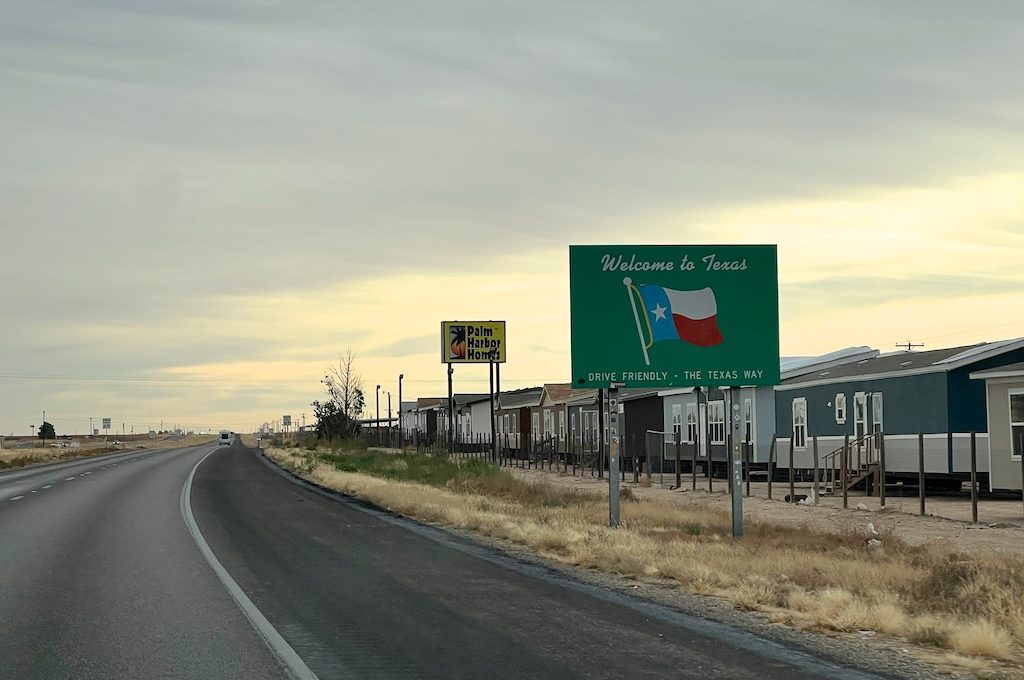
Tips for driving across Texas
Be ready for high speed limits.
On a lot of interstates in Texas you can expect the speed limit to range from 70 to 75 mph. On some highway sections , like on I-10 between Kerrville and El Paso, the speed limit is 80 mph!
You can usually get away with going 5 to 10 miles per hour over the speed limit but some patrol officers may decide to enforce the speed limits more strictly on the higher end of that range and beyond.
The best way to stay out of trouble with highway patrol is to utilize the app, Waze .
It will show you where the police have been reported and in my experience, after using it on dozens of road trips covering thousands of miles , it works amazingly well to give you notice about the po-pos.
Also, what works really well is finding a “George.”
A George is a vehicle that you follow as they speed ahead and become a sacrificial lamb of sorts for traffic stops.
Watch out for speedsters
Speaking of speed limits, you will undoubtedly come across a lot of vehicles driving very fast on these interstate highways.
It’s not uncommon to be driving 90 mph and still just be more or less going along with the flow of traffic.
If you stay out of the fast lane the speedsters should not be a problem for you in the vast majority of cases.
If anyone is ever flashing their lights behind you, that is a sign that you are in the way and your best course of action would be to promptly change lanes and allow the vehicle to pass you.
Avoid traffic in the major cities
When crossing through Texas, most routes will take you through the major cities and in those cities you can generally expect to have some pretty terrible traffic during rush hour.
This includes cities like Dallas, Houston, Austin, and San Antonio.
Rush hour can vary based on where exactly in the state/city you are but generally you can expect it to occur on weekdays at 5 PM and 8 AM ( plus or minus 1 hour ).
Driving right through the heart of the cities is nice because you get to view the impressive skylines and get a sense of what the city looks like but in some cases you can save a lot of time and headache by routing through the outskirts of the city.
Once again, utilizing Waze is a great way to efficiently move through congested areas.
You’ll also find express lanes through the cities and if you have two or more passengers you can usually take advantage of these.
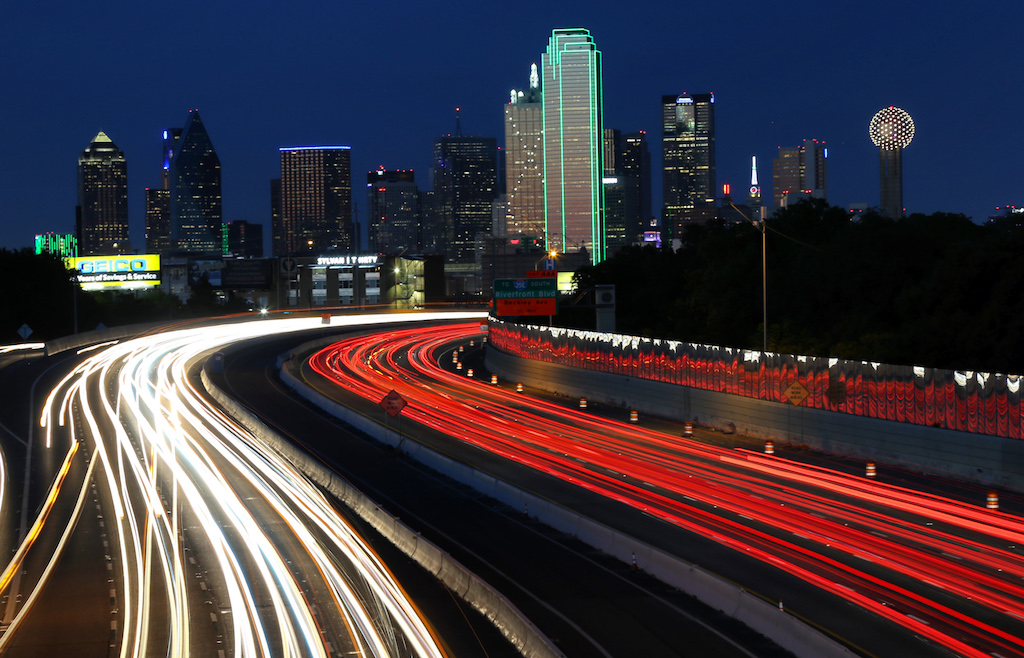
Make a stop at Buc-ees
If you’re looking for a gold-standard gas station to stop at that has a vast selection of foods and snacks along with super clean bathrooms then you definitely want to stop at Buc-ees .
Open 24 hours a day, for a lot of Texans no road trip is complete without a stop at Buc-ees.
If you are heading along I-10 near Houston, the city of Katy has a Buc-ees with the world’s longest car wash.
And if you are heading through the Hill Country in New Braunfels, you’ll find the largest Buc-ees which is also the largest convenience store in the world !
Related: Buc-ee’s Ultimate Guide
Respect the fast lane & learn how to say thanks in Texan
When traveling on the interstate or any multi-lane highway, you only should stay in the fast lane (the far left lane) if you are passing or if you are going at least as fast as every car around you.
If you are traveling on one of the smaller highways with only one lane, you’ll likely find a lot of Texas drivers to be quite courteous.
When drivers can sense you are needing to pass them they often steer closer to the shoulder to make it easier for you to pass.
If this happens to you a common way to say “thanks” is to flash your hazard lights a couple of times after you pass the car.
After you pass, look to your rear view mirror and you might see the car flash their headlights which is their way of saying “you’re welcome.”
Plan your gas stops in West Texas
Once you get past Austin and San Antonio, also known as the I-35 corridor, you’ll start to notice that gas stations are not as common to find.
And as you start to enter the desert terrain of West Texas, gas stations can be located pretty far apart. My rule of thumb is to always fill up if I am passing a gas station and my vehicle is around half a tank.
I’ve definitely had some pretty close calls in the past and running out of gas in the middle of nowhere Texas is not necessarily something I’m wanting to experience, especially when the summers can be sweltering.
Related: 56 Most Beautiful Places in the USA
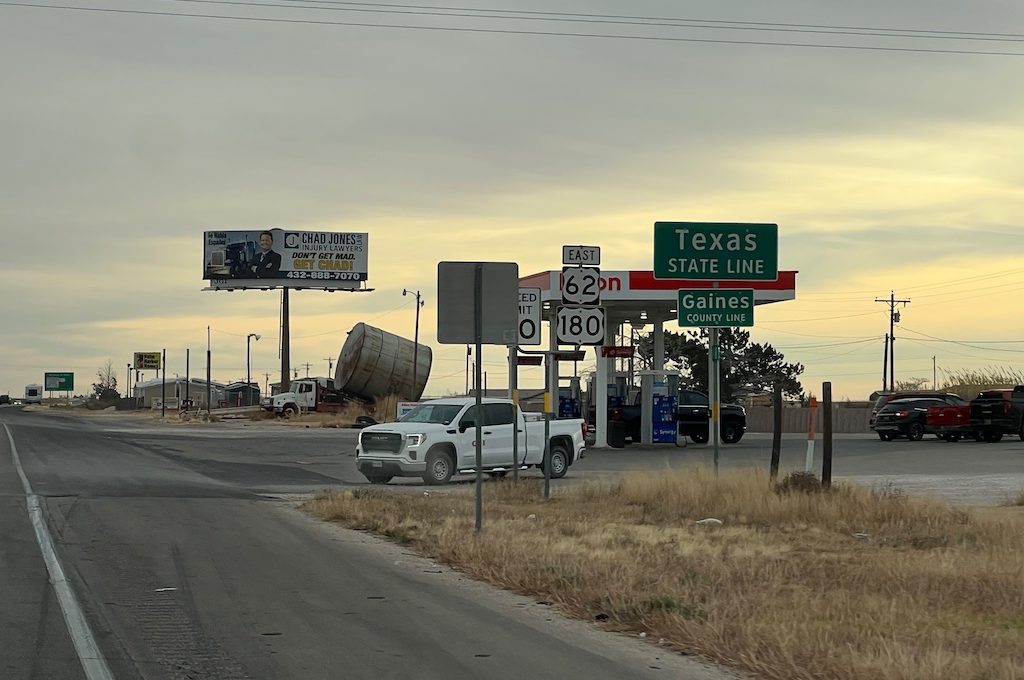
Texas interstate map
Below you can see all of the major interstates that run through Texas. Most of the routes I discuss below are on the interstates but some do go through smaller highways.
When people talk about traveling through or across Texas, they generally are talking about traveling on I-10 and I-20, which run east and west across the widest part of the state.
Less common, some people might take a north and south approach which would involve interstates like I-35, I-27, and even I-45.
Of course, you can also take any of the hundreds of different highways to get through the state.
Something that is pretty fascinating is that Texas has way more lane miles than any other state. So there is no shortage of roads in Texas.
Routes across Texas
I-10 (orange to el paso).
- 13 hours, 12 minutes; 874 miles
This route will take you all the way across Texas by just staying on one highway: Interstate 10. This is probably my favorite route to take across Texas.
You’ll get a tiny taste of the piney woods in the east and head through the bayous and marshes surrounding the sprawling metropolis of Houston, where you can check out attractions like the San Jacinto Battleground State Historic Site .
A few hours from Houston, you’ll pass through San Antonio and then head through the beautiful rolling green landscape of the Texas Hill Country.
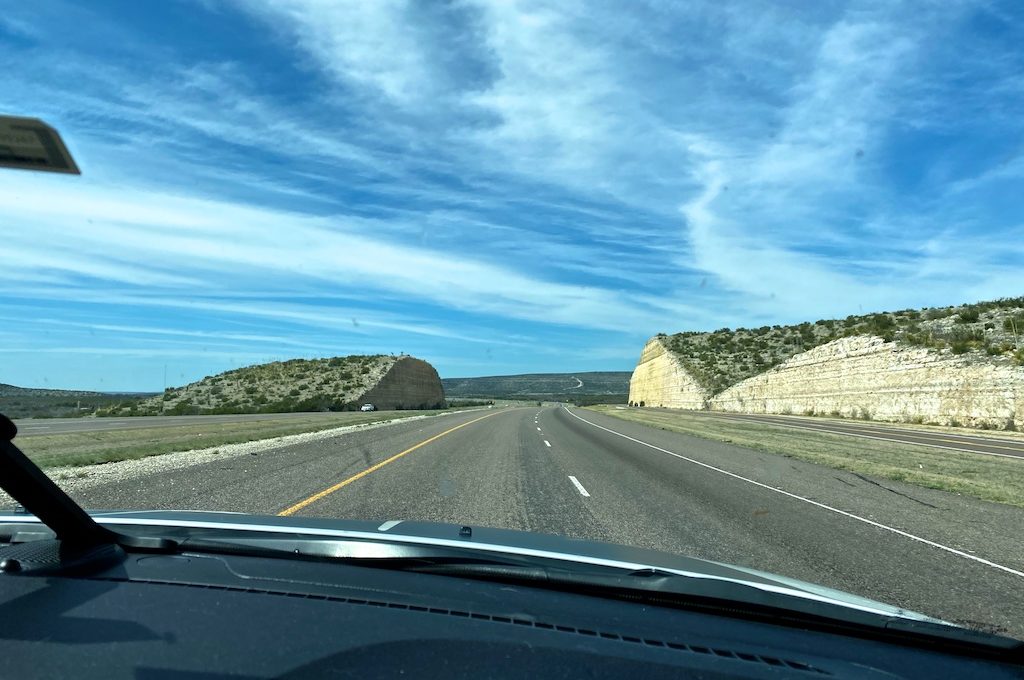
When the bluebonnets are blooming in spring, this can be an extremely scenic drive and you might even consider hopping off the interstate to explore smaller highways with tons of vivid bluebonnets.
After you pass through the Texas Hill Country, you’ll start to hit more mountainous terrain in West Texas as you make your way through 80 mph speed limits and small towns like Fort Stockton and Van Horn which are often used as pitstops along the way.
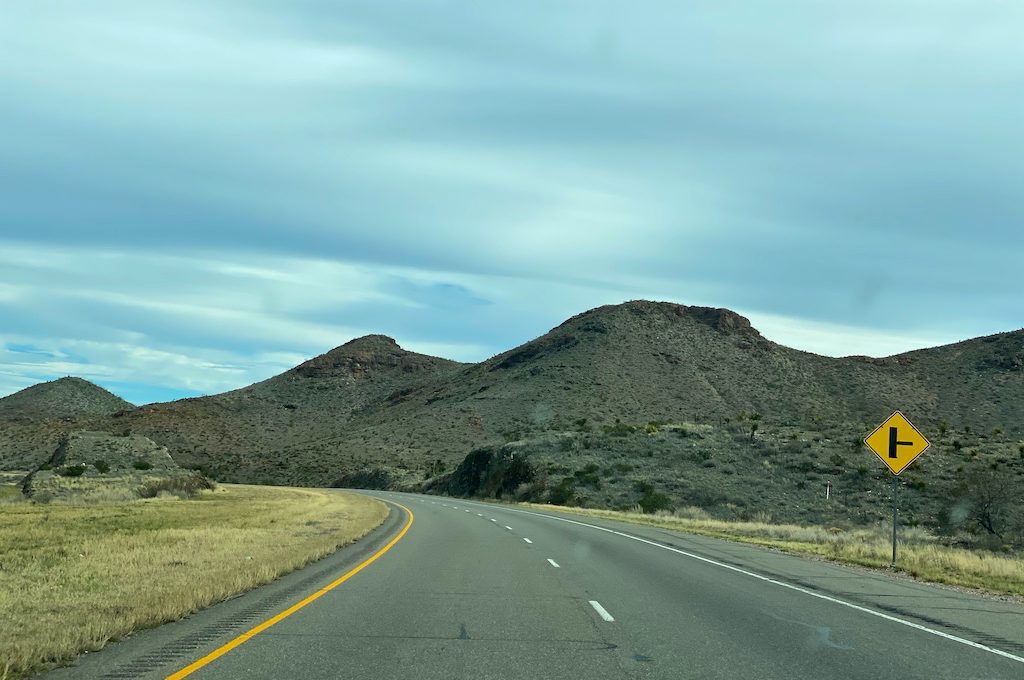
Tip: Quality hotels in these smaller cities can sell out surprisingly quickly so if you are intending on making a pitstop you may want to book a little bit in advance.
Eventually, you’ll wind up in El Paso, Texas and you’ll be adjacent to both New Mexico and the international border of the US and Mexico. In this region, you’ll find a lot of mountainous terrain that many people never associate with Texas.
This is my favorite route because I-10 cuts through just about every type of geographic region and terrain that Texas has to offer.
You don’t quite get to experience the high plains and rolling plains of North Texas but some of the scenery in West Texas is pretty similar to that so in my book this is the ultimate route to get across Texas on.
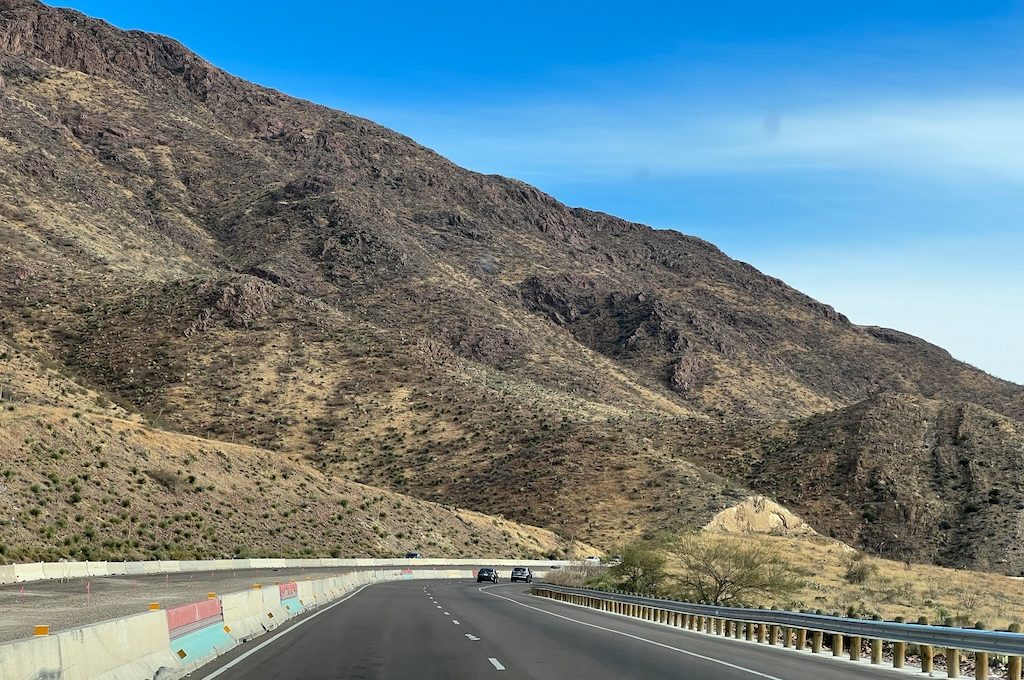
I-20 and I-30 (Texarkana to El Paso)
- Estimated time: 12 hours, 18 minutes; 832 miles
If you are starting or ending in Arkansas then this is the likely route you will take to get across Texas.
After starting out from Texarkana, you’ll venture through the beautiful prairies and lakes region of North Texas and then get to experience both Dallas and Fort Worth. Try to avoid the DFW area during rush hour because that could easily add on a lot to your time.
Once you get out towards Abilene, a huge stretch of this road is going to be through rolling plains and wide open spaces. You’ll see a lot of oil fields, wind turbines, and cotton fields when you get out in the open. Phone service may be very spotty.
One interesting pitstop along the way is on I-20 in West Texas where you can find Monahans Sandhills State Park — one of the only places with sand dunes in Texas.
Did you know? Texarkana is closer to Chicago than it is to El Paso, Texas.
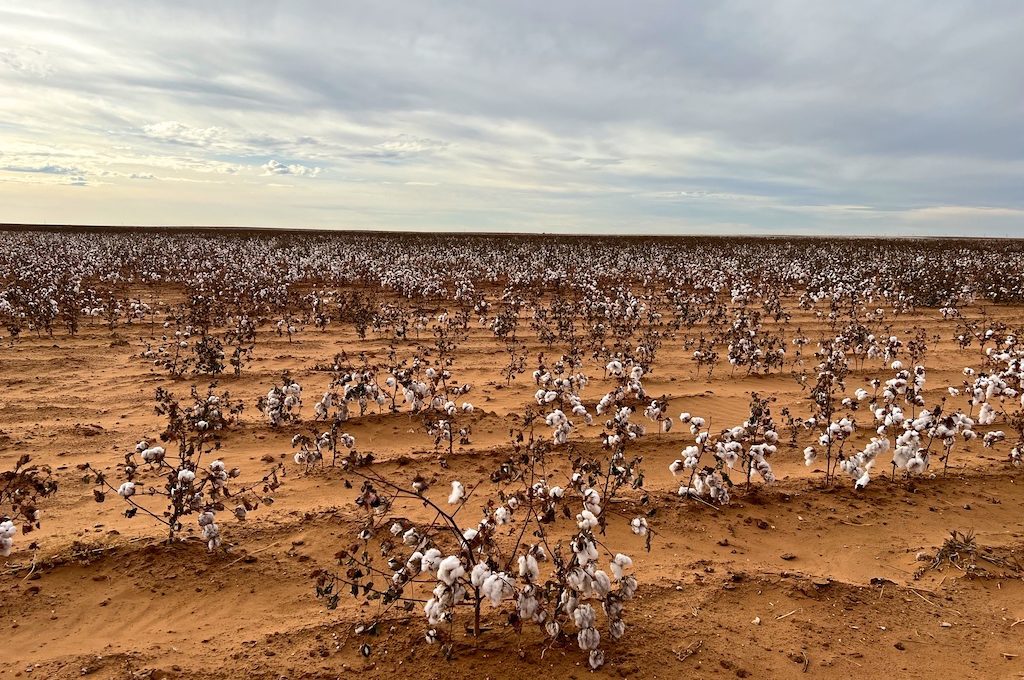
I-27 and I-37 (Texhoma to Brownsville)
- Estimated time: 13 hours, 26 minutes; 886 miles
If you want to take the absolute longest stretch of road through Texas then you can go from north to south or vice versa.
Right on the border of Texas and Oklahoma you’ll find Texhoma, with a population of around 1,000 people.
You’re not gonna find much up in the Panhandle of Texas but along the way you’ll be able to hit up cities like Amarillo, Lubbock, and San Antonio, eventually making your way through the South Texas Plains and brush country.
Coming from the north, your ultimate destination will be Brownsville, Texas. The city gets a bad rap but it has a ton of history to check out if you are ever in the area.
Doing this route is cool because it’s not as popular as the typical east to west routes most people travel on.
Compared to all of the people who have driven across the state between New Mexico and Oklahoma, it’s probably a much smaller group of people who have made the drive between Texhoma and Brownsville.
Did you know? In Texas , “the longest straight-line distance in a general north-south direction is 801 miles from the northwest corner of the Panhandle to the extreme southern tip of Texas on the Rio Grande below Brownsville.”
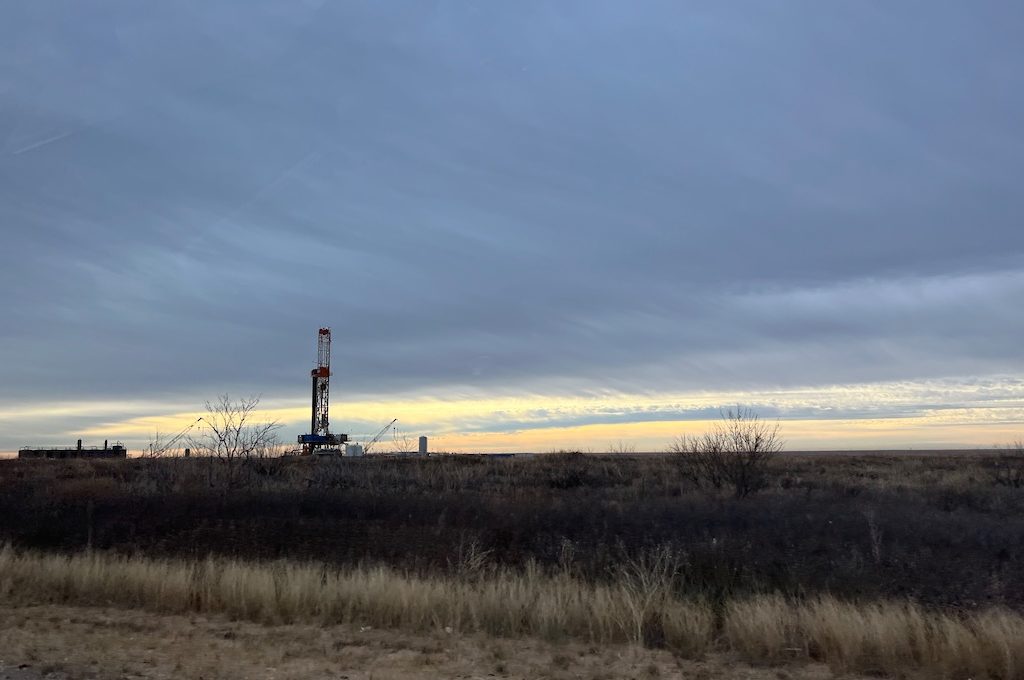
I-35, I-37, US-77 (Gainesville to Brownsville)
- Estimated time: 9 hours, 10 minutes; 612 miles
If you don’t want to take on the monster route from the very northern tip of the Panhandle of Texas, a more tame north-south route would be going from the more southern border of Oklahoma and Texas down to the tip of Texas.
This is a pretty interesting route because you can head through the prairies of the Dallas-Fort Worth area and then explore some other interesting cities in Texas like Waco, Austin, San Antonio, and even Corpus Christi.
This route will also take you through New Braunfels via I-35 which means you can stop at the largest convenience store in the world (Buc-ees) which is over 68,000 square feet!
Compared to the routes above, you’ll be heading through much more civilization but that also means you might be dealing with a lot more traffic so be prepared.
I-40 (Benonine to Hereford)
- Estimated time: 2.5 hours; 178 miles
Just like I-10, you can get across Texas with one single highway: I-40.
Traveling laterally across the Texas panhandle is kind of cheating in my opinion but this is still technically one way to get across Texas via the interstate system.
On this route, which comes with minimal bragging rights, you’ll have the privilege of traveling through the high plains and the famous city of Amarillo, Texas.
This will give you a chance to check out things like the Cadillac Ranch, US Route 66, and the Panhandle Plains Historical Museum.
Traveling across Texas is sort of a personal achievement because of how vast the state is. For the most part, driving across the state is going to be an all day event even for people who take little to no breaks on the drive.
Whether you were traveling north to south or east to west, you’ll be surprised at how diverse the landscape is and how truly open and beautiful the state is.

Daniel Gillaspia is the Founder of UponArriving.com and the credit card app, WalletFlo . He is a former attorney turned travel expert covering destinations along with TSA, airline, and hotel policies. Since 2014, his content has been featured in publications such as National Geographic, Smithsonian Magazine, and CNBC. Read my bio .
One comment
Takes considerably longer if you’re waltzing. 😀
Leave a Reply Cancel reply
Your email address will not be published. Required fields are marked *
Privacy Overview
Road Trippin’ USA: Heading West Across Texas
Explore the rural highways of the Austin-to-San Angelo route with us.
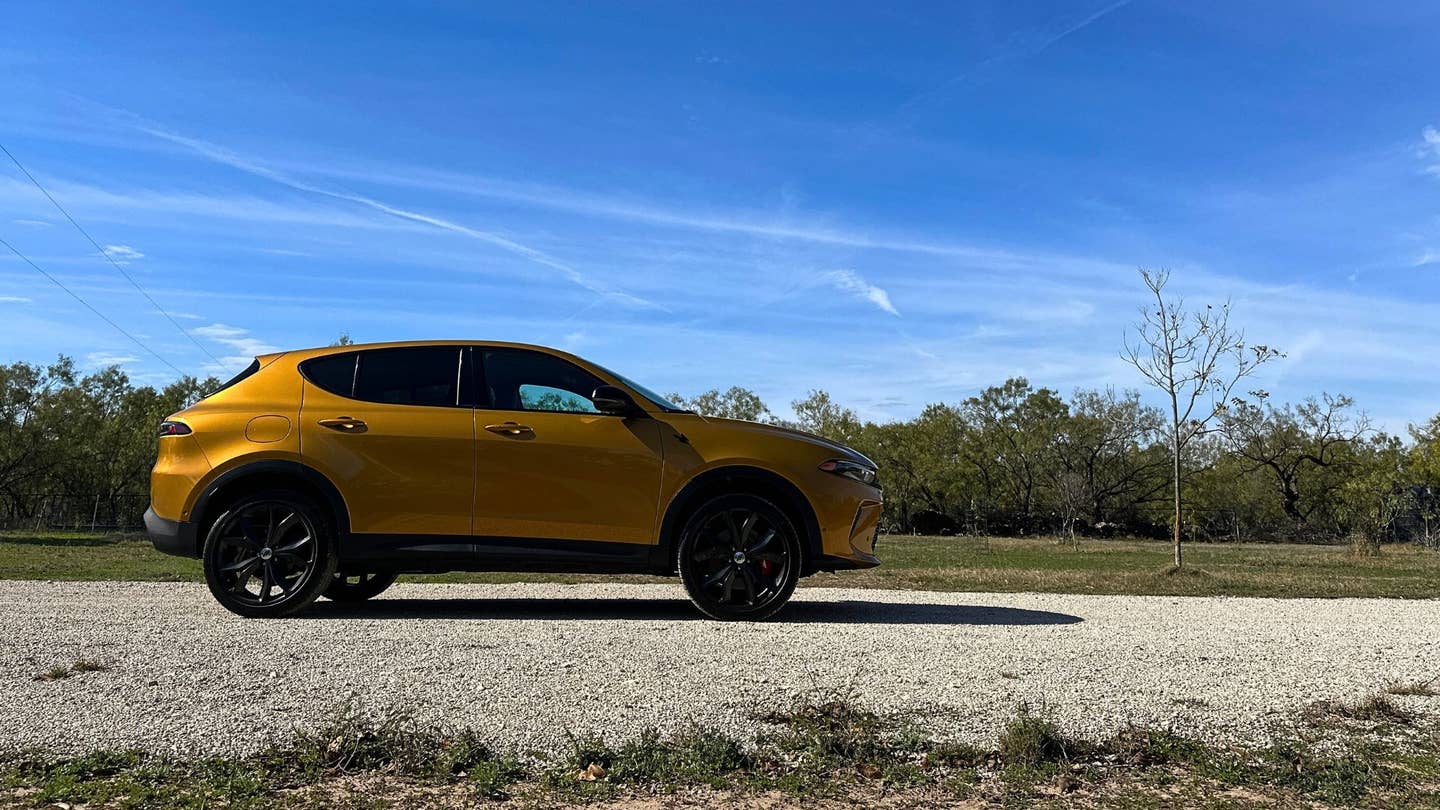
KristinVShaw
America is a vast country with tons of highways, roads, streets, avenues, and dirt paths crisscrossing every which way. If you like to drive, exploring as many segments of that web of pathways becomes a passion, and seeing new places through the windshield a must. I don't want a car that drives me, I want to drive the car; a road trip is the best way to enjoy the ride.
Thinking about navigating a new course? I'm starting a series to ignite your road-trip daydreams. Here’s my first recommendation, starting from my home city: Austin to San Angelo, Texas.
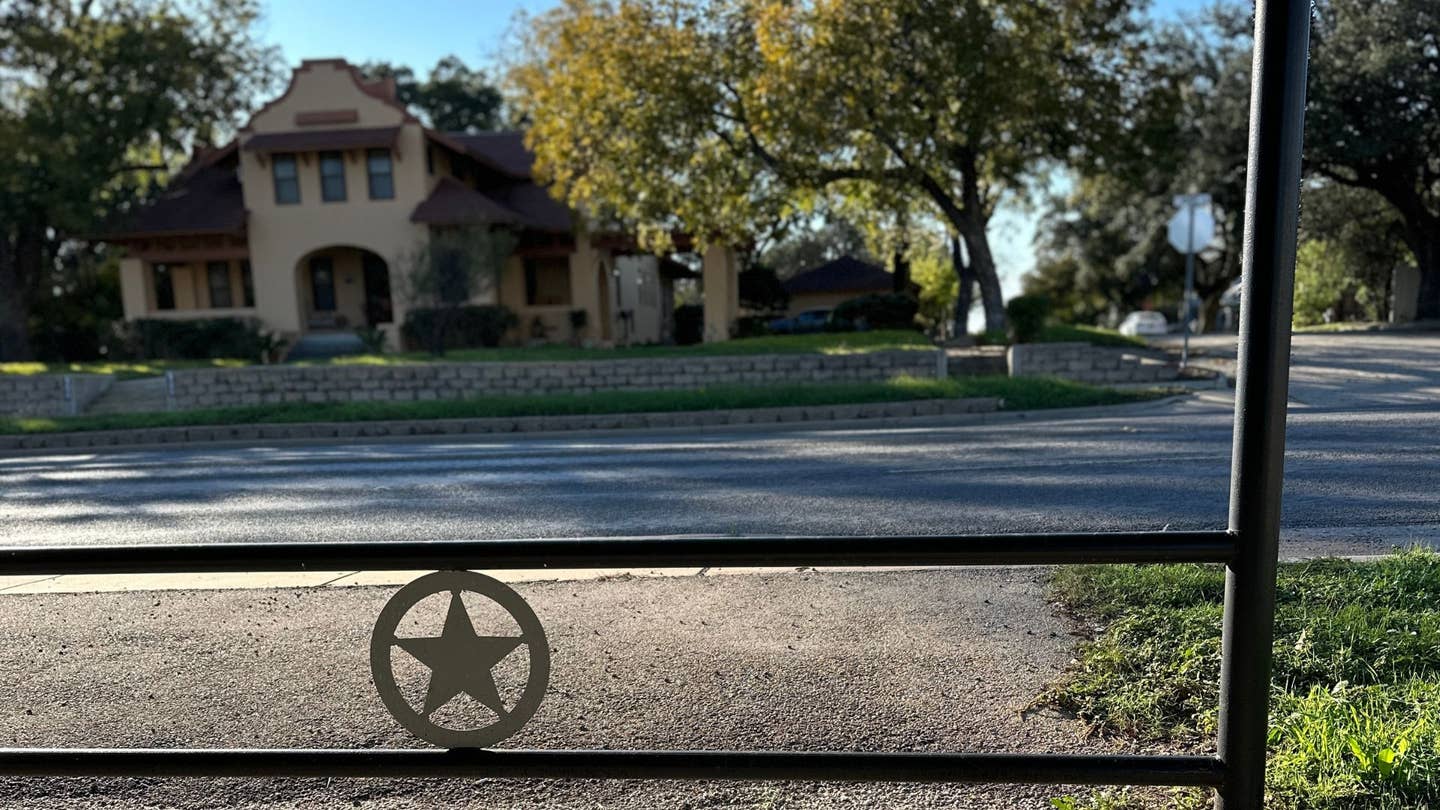
Fast Highways
I met and married a native Texan and moved to Austin in 2008, and we love it. Even after 15 years here, there is still so much of the state we haven’t seen. It's massive: spanning more than 260,000 square miles, Texas is the largest state in the continental U.S. and contains the most roadway.
My husband’s parents are from west Texas, and Will grew up in Midland. The first time I visited Midland, I was struck by the sheer flatness; one could gaze into the distance and view goes on and on forever. And that’s saying something, since I grew up amidst steady, parallel rows of corn in Indiana .
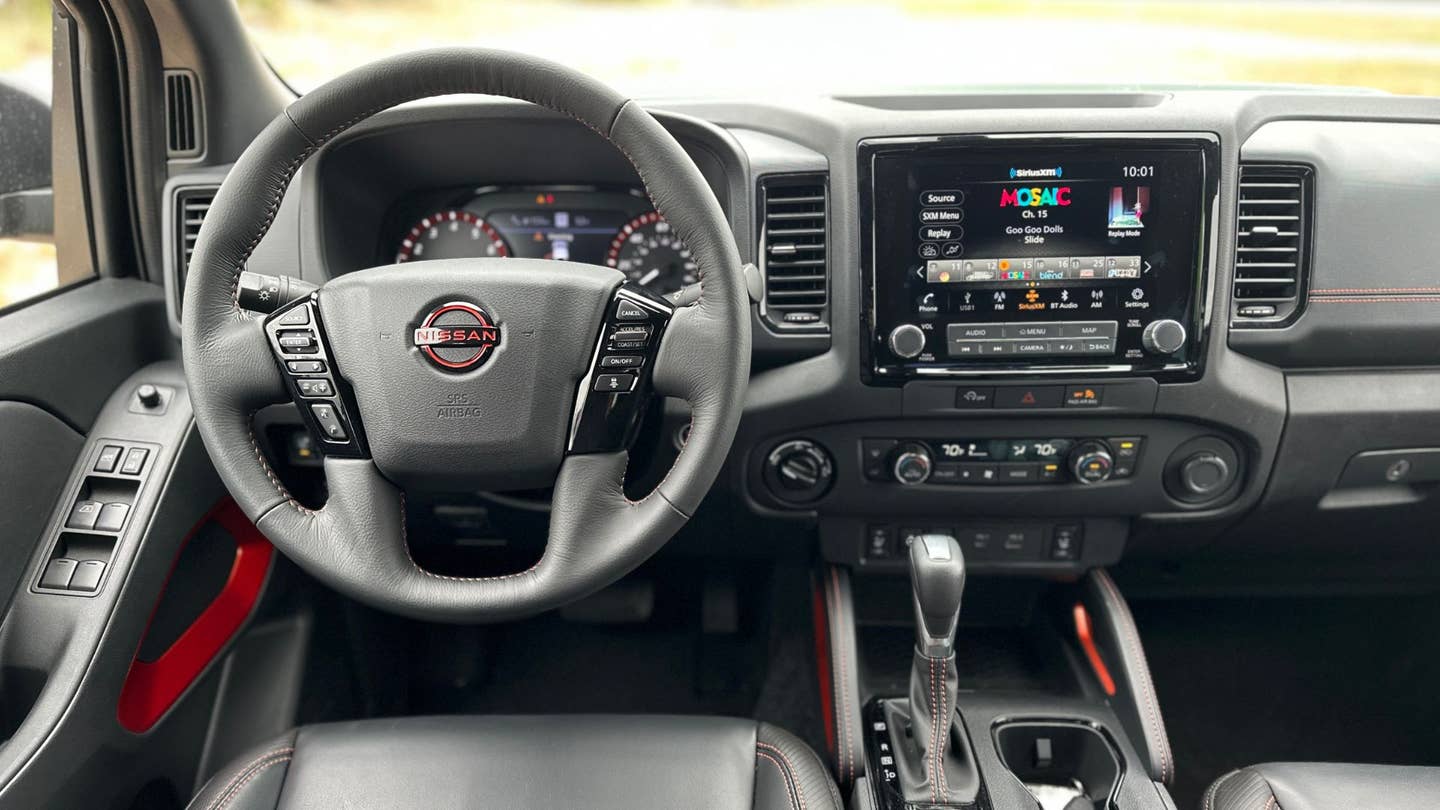
One of the most striking things about traveling through Texas is the speed. Just outside of Austin, Highway 130 has a posted speed limit of 85 mph, which is the highest in the country. Aptly, America’s fastest road leads to the Circuit of the Americas, where F1 drivers burn rubber in the fall . The very first time I drove this tollway was in a sleek Ferrari F430 , owned by an exotics rental company. I’d talked my way into reviewing it for local coverage early in my career and couldn’t believe they were letting me behind the wheel.
The owner of the company sat in the passenger seat and as we approached the brand-new on-ramp to Highway 130, he urged me to floor it.
“Floor it?” I repeated, dazed.
“Yes,” he insisted.
I kissed three digits and then slowed back down to the speed limit just as quickly; a speeding ticket would have ruined my day and a crash at high speed is stupid. It was thrilling all the same, the sensation of flying down a flat, perfectly smooth ribbon of asphalt. Large swaths of Texas are even more wide open, with stretches of road dotted by just a few other cars as you pass by cows, sheep, goats, deer, and oil-producing pumpjacks.
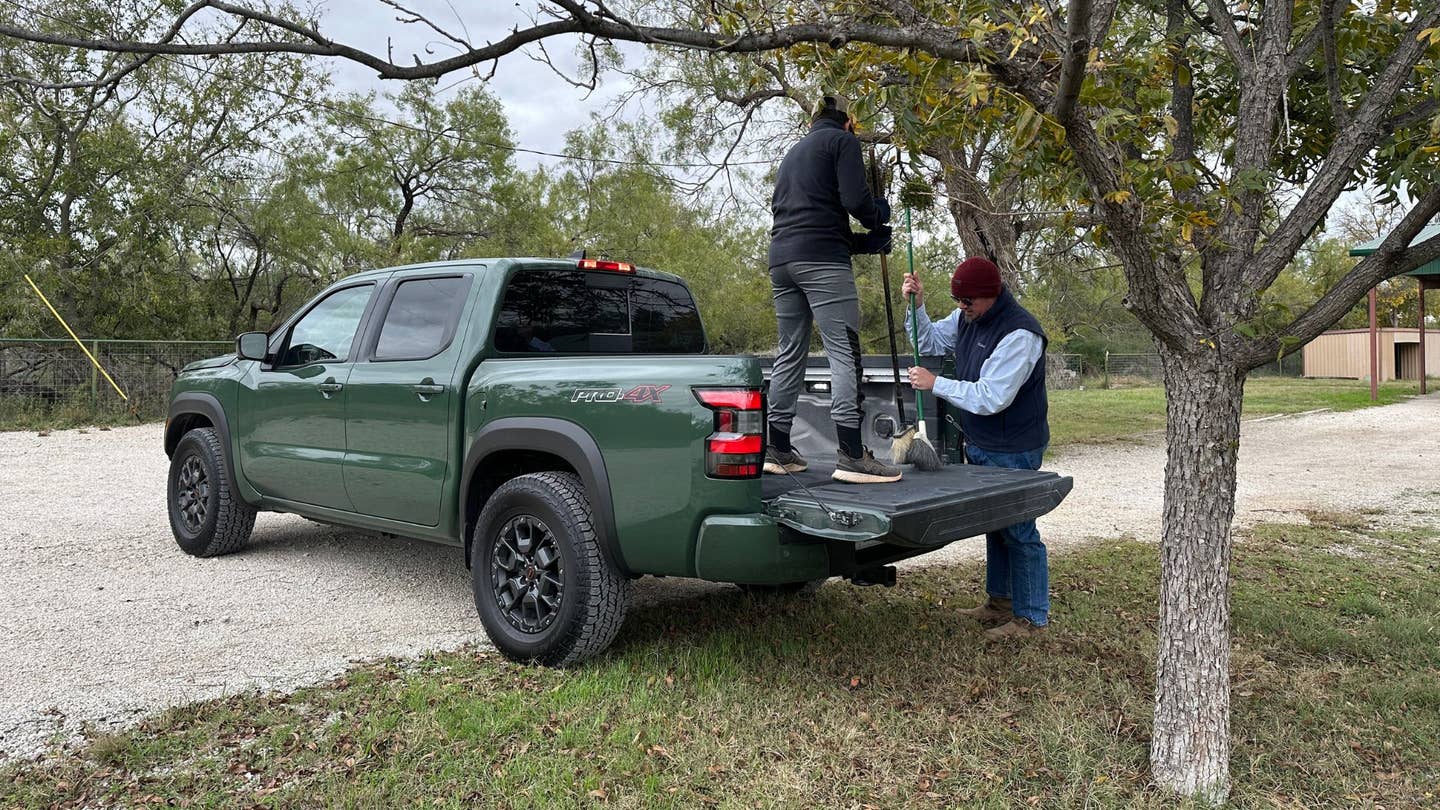
Over Thanksgiving, my family and I piloted a new Nissan Frontier Pro-4X . Equipped with a 310-hp 3.8-liter V6 and Bilstein off-road shocks, this truck is ideal for ranch work, and we piled in loads of wood and moved supplies from the house to the barn. But even on the highway, I really appreciated the Zero Gravity seats that make even a long drive comfortable from start to finish. I parked it right next to my father-in-law's first-gen Nissan Titan, which is still running fine after nearly two decades.
Exploring the Rural Parts of Hill Country
Heading west across Highway 71 toward Llano, the Hill Country is a part of the Lone Star State that visitors can’t seem to comprehend. A fair part of Texas is flat, especially west Texas, but the section between Austin’s Travis County and northwest to Menard County is varied. Vistas sweep through Horseshoe Bay, where Ford hosts a Bronco Off-Roadeo site, through the town of Llano.
When arriving in Llano, park the car at Cooper’s for some of the best barbecue in the world . There, I said it. Kansas City, Memphis, Atlanta, you’ve got nothing on Cooper’s brisket. Cross over the Roy Inks bridge after passing the courthouse and then you have a decision to make: go northwest toward Brady or choose the Mason-to-Menard route nearly straight west. Brady has a few fantastic antique stores and an excellent mechanic shop (as I discovered when my HHR SS overheated along the way). Mason has Nacho’s Café, Rico Café, and the beautiful and historic Seaquist House .
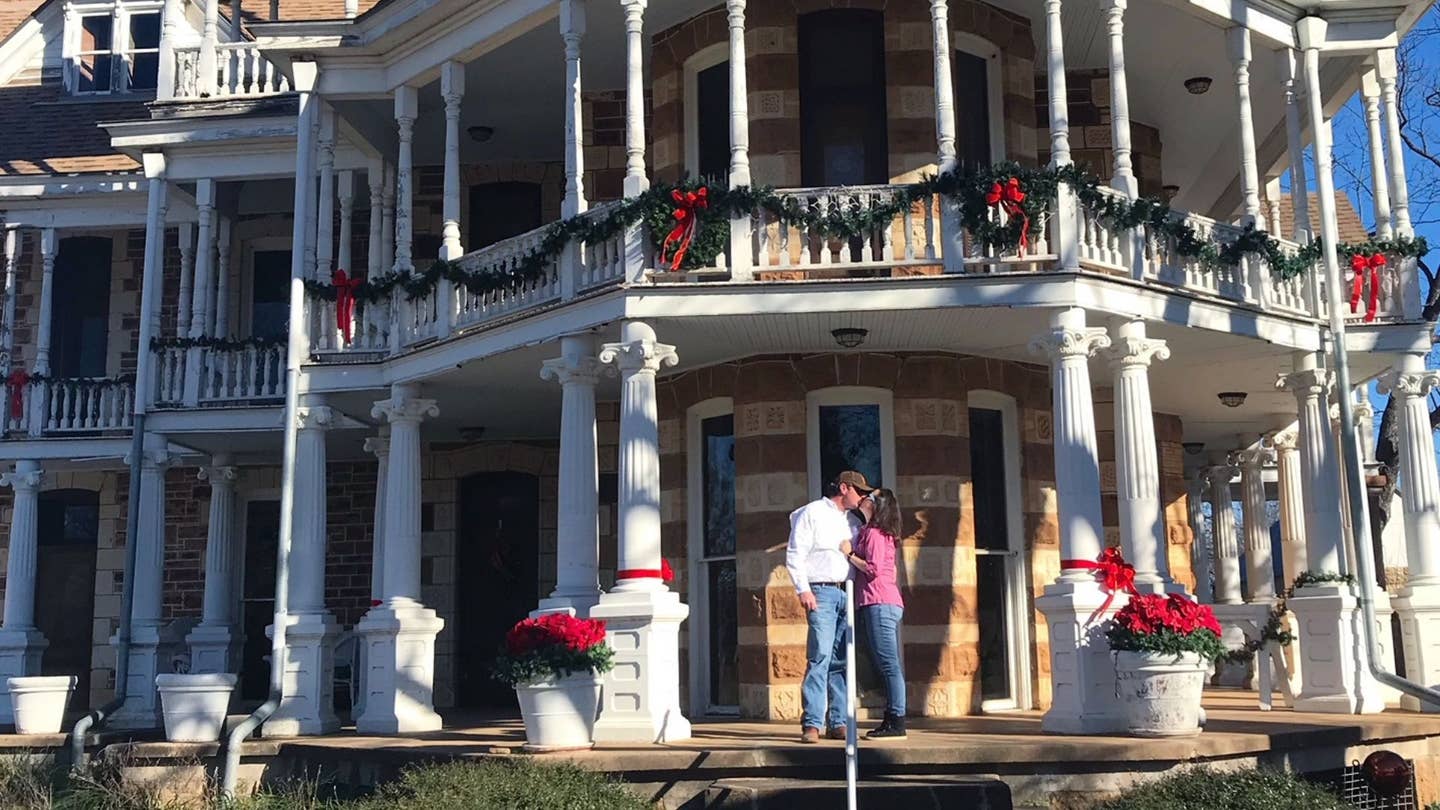
Either way, the road passes through Eden (which has a quirky, eternally optimistic Garden of Eden Park) and on to San Angelo. One of the largest cities in the United States without an interstate running through it, San Angelo is a small town at heart even with over 100,000 residents. The university has a big presence, as does the Goodfellow Air Force base.
Surrounding the city and heading toward Mertzon, where my father-in-law’s family settled five generations ago, livestock roams across thousands of acres of ranch land. The roads are well kept in Texas and the highway system cleverly laid out; it took me some time to get used to the feeder roads and tangles of overpasses when I first moved here, but once I did it became clear how the cities avoid total gridlock.
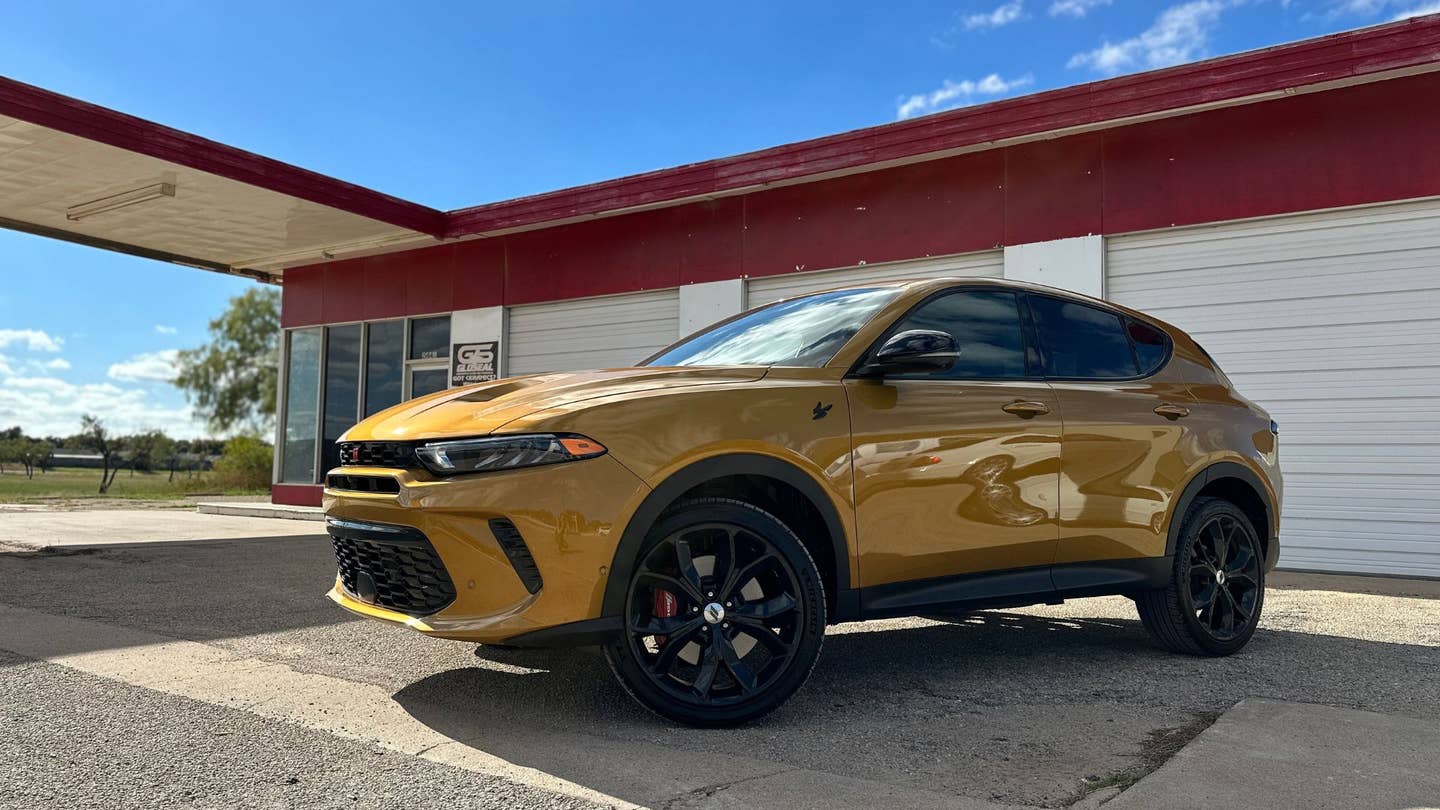
Wide Open Spaces
On the way back to Austin, take Toe Nail Trail through Christoval to pass by the tiniest functioning post office I’ve ever seen and a 40-year-old vineyard growing riesling, tempranillo, petite sirah, vermentino, and Mourvèdre grapes. Once again, between cities the roads are wide open and smooth, and having a vehicle made for speed helps make the drive feel shorter.
This time, I was testing a Dodge Hornet GT clad in an Acapulco Gold finish. It feels like a compact missile, much like its Alfa Romeo Tonale counterpart, zipping from zero to 60 mph in 6.5 seconds. Powered by a turbocharged 2.0-liter four-cylinder engine generating 268 horsepower and 295 lb-ft of torque, the Hornet GT offered a lively ride on undulating roads that felt like kiddie roller coaster, but much better.
Of course, we had to leave the Yeti behind and couldn't stock up on firewood because of the smaller cabin, but that's okay. We'll be back.
Got tips? Send them to [email protected].


Ultimate West Texas Road Trip Itinerary
If you’re in the mood for adventure and a subtle whiff of vast, pristine plains, then a West Texas road trip is right up your alley.
There are so many interesting sites to explore and charming towns with their own unique character in this part of Texas.
Also Read: 25 Best Things to do in West Texas

Start with Del Rio, the backdoor to Big Sky Country.. and explore the natural attractions at Lake Amistad.
From there make your way west to visit the ghost town of Langtry where Wild West legend Judge Roy Bean once held court.
Stop by Marfa to witness the stunning desert landscape and way out-of-this-world art installations before heading north to glamp under the stars in Big Bend National Park.

This would be a great place to pause for some outdoor activities like hiking or river rafting down the Rio Grande.
Be sure to see the fossils in Big Bend and imagine this area being a hunting grounds for beasts like the T-Rex and Deinosuchus!

Return to civilization throughout your journey for delicious regional eats like enchiladas, flavorful salsas, and some desert sotol.
Soak in the history and culture. Learn about oil industry at Midland . Dance to some good ol’ country tunes while taking in all that West Texas has to offer!
Here is an ultimate guide to planning a West Texas road trip.

West Texas Road Trip: Essential stops
Taking a road trip through West Texas is an adventure for anyone seeking some outdoor fun.
From the rugged deserts of El Paso to the unique beauty of Big Bend National Park, the area offers a variety of attractions.

Throughout the trip, travelers can explore diverse ecosystems and wide-open spaces with opportunities for activities such as camping, fishing, and horseback riding.
There are many charming towns that provide various cultural experiences while providing access to nature trails and lakes.
Here are the best places to stop on a West Texas road trip.

Del Rio is located on the northern banks of the Rio Grande in southwestern Texas.
It is the county seat of Val Verde County.
The city was founded in 1850s, and named after the nearby Rio Grande.
It is one of the most underrated places to visit West Texas.

Today, Del Rio is known for its scenic beauty, bustling economy, and rich cultural heritage.
Visitors to Del Rio can enjoy a variety of activities, including shopping, dining, and exploring the city’s many parks and museums.
Some of the popular attractions in Del Rio include the Val Verde Winery, murals in Del Rio near Casa de la Cultura, and the Whitehead Memorial Museum.

The Laughlin Heritage Foundation Museum is also a great trip for aviation and military enthusiasts.
Read our post on Best Things to do in Del Rio, Texas for more information.
Lake Amistad National Recreation Area
Situated on the borders of Texas and Mexico, Lake Amistad National Recreation Area is a popular spot for fishing, boating, and swimming.
The lake itself is fed by the Rio Grande river and is known for its clear blue waters and scenic views.

Visitors to the area can enjoy hiking, camping, and picnicking in addition to water activities.
The recreation area also offers a variety of educational programs about the local ecosystem and wildlife.
One of our favorite trails in the area include the Diablo East Trails System.

Here you will find a couple of easy nature trails that offer great views of the lake, picnic tables, boat ramp, as well as a scenic drive.
Seminole Canyon State Historical Park
Located in southwest Texas, Seminole Canyon State Historical Park is home to a wealth of history and culture.

The canyon itself was formed by the Pecos River and is surrounded by steep cliffs.
This unique landscape has served as a home for humans for over 10,000 years.
Early inhabitants of the canyon include the Hunter-Gatherers, who left behind evidence of their lives in the form of rock art.

Visitors can take a guided tour of the Fate Bell Shelter to see the ancient rock art.
The park has many other trails and historic sites and is an excellent stop on your West Texas road trip.

Pecos River High Bridge Scenic Overlook
The Pecos High Bridge Scenic Overlook is one of the most popular attractions in Comstock, Texas.

The overlook provides breathtaking views of the Pecos River, steep canyon, and the Southern Pacific Railroad Bridge.
The overlook is open daily from sunrise to sunset and is accessible via a short paved trail.
Parking as well as picnic tables are available at the overlook.

The small town of Langtry is made famous by an iconic West Texas figure: Judge Roy Bean!
Judge Roy Bean named the town after the British actress Lillie Langtry, after being enamored with her.

Today, visitors can tour the Judge Roy Bean Visitor Center, which tells the story of the town’s legendary former resident.
On a visit, you can see his artifacts as well as historical buildings including the saloon where he dispensed justice.

The Visitor Center contains many important items used by him on a daily basis as well as preserves his house in a good condition.
There is also a large cactus garden and botanical garden at the Visitor Centre with several hiking trails and native plants.

If you have the time, make a pitstop in Sanderson, Texas on Highway 90.
Charming town of Sanderson is known as the Cactus Capital of Texas.

You can take a stroll along the Cactus trail where you can see a variety of different cacti that grow in this region.
It is the perfect place to enjoy peace and quiet of West Texas desert landscape.

Marathon , Texas is a small town located in the heart of the Big Bend region.
It is known as the eastern gateway to Big Bend National Park and is perfect for staying while you explore the park.

The town is surrounded by the beautiful mountains, pristine desert landscape, and the occasional springs.
Marathon is also home to the Gage Hotel, which is one of the most iconic hotels in West Texas.
Other attractions in Marathon, Texas include Gage Gardens, art galleries, and the history museum.

Big Bend National Park
For most visitors, Big Bend is #1 of West Texas attractions!
Big Bend National Park is one of the most beautiful national parks in America.
Located in West Texas, the park is home to a variety of landscapes, including mountains, deserts, and canyons.

Visitors can explore the park by hiking, camping, and birdwatching.
The park also contains a number of historical sites, such as pioneer farmsteads and adobe ruins.
In addition to its natural beauty, the park is also known for its dark skies.
On clear nights, stargazers can see thousands of stars, as well as the Milky Way galaxy.

Big Bend Fossil Exhibit
Start your trip to the national park from Marathon by visiting the Persimmon Gap Visitor Center.
From there, head to one of Big Bend’s highlights: Fossil Discovery Exhibit.

The Big Bend Fossil Discovery Exhibit is a unique display of the area’s rich paleontological history.
The exhibit features a wide variety of fossils, including some that are over 500 million years old as well as touchable casts of fossils.

Visitors can see fossils of ancient fish, amphibians, reptiles, and even early dinosaurs that once lived here.
In addition, the exhibit provides information about the park’s geology and how the fossils were formed.

Rio Grande Village
Rio Grande Village Unit of Big Bend is located in the far east side of the park.
The road here is very scenic and even has a famous tunnel.

The area is home to a number of hiking trails including the family friendly Rio Grande Nature Trail.
This trail takes you right up to the river.

It is fascinating to see the border of USA and Mexico up close.
You can even stand in the river water as you see Mexican lands across the banks.

Boquillas Canyon trail take you deep into the canyon while you can make a day trip to Mexico at the Boquillas crossing.
The popular Hot Springs Trail is also great for families: see historic ruins and soak in the hot springs.

Chisos Mountains
The Chisos Mountains are a mountain range located in the Big Bend National Park in Texas.
The range is home to the tallest mountain in Texas, Emory Peak, which stands at an elevation of 7,825 feet.

The Chisos Mountains are a popular destination for hikers and campers, as they offer stunning views of the surrounding desert landscape.
The mountains are also home to a variety of wildlife, including black bears, deer, and cougars.

You will find several popular trails here including the strenuous Window Trail and Lost Mine Trail.
Little legs can easily do the paved, about a mile long roundtrip Window View Trail to enjoy amazing views.
Ross Maxwell Scenic Drive
The Ross Maxwell Scenic Drive is one of the most popular attractions in Big Bend National Park.
The road winds through canyons, mountains and desert landscapes, providing stunning views of the park’s unique geology.

Along the way, visitors can stop at overlooks to enjoy panoramic vistas or take short hikes to explore narrower canyons and arroyos.
The drive takes about three hours to complete, and provides an unforgettable experience.

Santa Elena Canyon Trail
For many visitors to Big Bend region and West Texas, Santa Elena Canyon trail is the highlight of their visit.
The trailhead is located at the end of the Ross Maxwell Scenic Drive, and the trail follows the Rio Grande for approximately one mile before ending at a beautiful overlook of Santa Elena Canyon.

The canyon, with its sheer walls and the river flowing through, is a sight to behold.
The trail is relatively flat and easy to hike, making it a great choice for families with young children or for those looking for a leisurely stroll.
However, the heat can be intense during the summer months, so be sure to bring plenty of water and start hiking early in the day.

During flooding, the creek crossings on the trail can be too deep and you’ll be in for a hearty scramble up the mountainside.
Ghost town of Terlingua
Terlingua was once a thriving mining town, and its abandoned buildings now stand as a testament to its early prosperity.
In the early 1900s, Terlingua was a bustling hub of activity, with two mines producing cinnabar, the ore used to produce mercury.

However, by the 1940s, both mines had been closed and Terlingua had become a ghost town.
Today, Terlingua is a popular destination for tourists visiting the Big Bend region.
Visitors can explore the abandoned mines and buildings, wander through the cemetery, and even camp out into the desert.

Many glamping options such as yurts and tikis are located in Terlingua, making it another great base to explore Big Bend National Park.
If you’re looking for a remote and scenic stop on your West Texas road trip, Lajitas, Texas is the perfect destination.
Situated on the edge of Big Bend National Park, Lajitas offers stunning views of the Chihuahuan Desert.

The area is home to a variety of wildlife, including javelina, deer, and quail.
Visitors to Lajitas can enjoy hiking, camping, and horseback riding in the nearby Big Bend National Park.
They can also relax in the luxurious Lajitas Resort, which offers a golf course, spa, and restaurants.

Big Bend Ranch State Park
Located in far west Texas, Big Bend Ranch State Park is a true hidden gem.
It is the largest state park in Texas.
The park is home to a diverse array of plants and animals, as well as stunning geological features.

Visitors can camp, hike, bike, and horseback ride through the park.
Popular attractions in Big Bend Ranch State Park include Sauceda Historic District, Fort Leaton, and the scenic River Road.

Big Bend Ranch State Park River Road
Big Bend Ranch State Park’s River Road is the best kept secret in far West Texas!
The road follows the course of the Rio Grande, offering stunning views of the river and the surrounding mountains.

Along the way, there are several turnouts and pull-offs where visitors can stop to enjoy the view or take a short hike.
Hike the Closed Canyon Trail for an adventure through a narrow slot canyon while you keep watch for mountain lions!

Enjoy a picnic at the Contrabando movie set and see the beautiful hoodoos.
The around 115 miles long road connects Lajitas and Terlingua with Presidio and takes about half a day to see at a leisurely pace.

Fort Leaton State Historic Site
Fort Leaton State Historic Site is located in West Texas, near the Mexico border.
The fort was built by Ben Leaton, a trader who operated a store and trading post at the site.
The fort served as a base for Leaton’s trading operations and was also used as a refuge from hostile Indians.

Today, it is a state historic site that includes a museum with artifacts from the fort’s past.
Visitors can also explore the buildings and grounds of the fort on a self guided tour, which provide a glimpse into what life was like for the settlers who once called it home.

Presidio is a sleepy border town located on the Rio Grande, across the river from Mexico.
It is a gateway community for Big Bend Ranch State Park and the surrounding area.
While there is not a lot to do in Presidio, it is worth a quick stop to see the murals and the beautiful Santa Teresa Church.

Shafter is a ghost town on the way from Alpine to Presidio.
The town was named after General William Shafter, who led American troops during the Spanish-American War.

Visitors can explore the abandoned buildings, mines in Shafter Historic District, and take a stroll down Cibolo Creek.
Alpine, located in the Chihuahuan Desert, is known for its beautiful hiking trails and scenic views.

In addition to its natural beauty, Alpine is also home to a number of historical landmarks, such as the Sul Ross State University and the Museum of the Big Bend.
The town has a lively cultural scene and you will find plenty of art galleries, street art, and shopping on Main Street.

Marfa is a small town in the high desert of West Texas.
It’s home to art galleries, artists’ studios, and a vibrant arts scene spearheaded by minimalist artist Donald Judd and his Chinati foundation in the 1970s.

It’s also home to the mysterious Marfa Lights, strange flickering lights that have been seen in the night sky for centuries.
Some say the lights are a natural phenomenon, while others believe they’re ghosts or aliens.

No one knows for sure, but the mystery of the Marfa Lights adds to the town’s allure.
Marfa is also a popular destination for stargazing.
The clear night skies and lack of light pollution make it an ideal spot for watching the stars.

Located in the Davis Mountains of West Texas, Fort Davis is a small town with a rich history.
Founded in 1854, the town was named after then-Secretary of War Jefferson Davis.
It served as an important outpost during the Indian Wars, and later became a stop on the Butterfield Overland Mail route.

Today, Fort Davis is home to a number of historical landmarks, including the Fort Davis National Historic Site.
The fort has been beautifully preserved, and its buildings and grounds provide a fascinating glimpse into life on the Texas Frontier.
The town is also known for its picturesque setting, nestled among the majestic peaks of the Davis Mountains.

Davis Mountains State Park
Davis Mountains State Park is a unique and beautiful spot.
With its elevation, the park offers cooler temperatures than much of the surrounding area, making it a popular spot for camping, hiking, and picnicking.

The highlight of the park, however, is its scenic drive.
Winding through mountains and canyons, the drive offers stunning views of the landscape.
Along the way, there are several overlooks where visitors can pull off and enjoy the view.

McDonald Observatory
McDonald Observatory is one of the best places to learn more about the incredible West Texas sky.
The Observatory is operated by the University of Texas at Austin and has several prominent telescopes: the Hobby-Eberly Telescope, the Otto Struve Telescope, and the Harlan J. Smith Telescope.

The Observatory is also home to a variety of research programs, including the Dark Energy Survey and exoplanet studies.
In addition to its research programs, the Observatory offers public tours and educational programs for all ages.
Visitors can take part in stargazing nights, learn about the history of astronomy, and even see firsthand how researchers use the telescopes to study the universe.

Guadalupe Mountains National Park
Guadalupe Mountains National Park is located in West Texas and is home to the Guadalupe Peak, the highest point in Texas.
The landscape of the park is diverse, with canyons, desert plains, woodlands, and even gypsum dunes.

There are also a variety of animals that call the park home, including deer, coyotes, and snakes.
Guadalupe Mountains National Park is a popular destination for hikers.
The popular Guadalupe Peak trail is one of the best hiking trails in Texas .
The park also offers opportunities for camping, horseback riding, and bird watching.

El Paso , located on the border with Mexico, has a rich history and culture.
The city is known for its beautiful scenery, with mountains, desert landscapes, and the Rio Grande river.
El Paso is also home to a thriving arts scene, with numerous galleries, museums, and performance venues.

Fort Stockton
Fort Stockton is the county seat of Pecos County and a sleepy little town.
Despite its size, there are plenty of things to do in Fort Stockton.

One popular attraction is the Annie Riggs Memorial Museum, which is devoted to the history of the town and the surrounding area.
Another must: See the historic Fort Stockton, established to protect the San Antonio El Paso mail route.
The Fort Stockton Visitor Center is also worth a stop to learn about the history of the Comanche Springs.

Best Time to Visit West Texas
The best time of year for a visit to West Texas has to be springtime.
During this season, the landscape is lush and blooming with wildflowers that cover the hillsides and create a unique display of vibrant colors.
The temperature is also no longer scorching as it sometimes gets during summer months.

Also, many animals come out of hibernation or migrate during this time so you are likely to catch glimpses of amazing wildlife throughout your journey.
Late fall through mid winter is another great time to visit.
The average temperatures in November reach highs of around 78 degrees Fahrenheit and lows below 53, providing a pleasant ambiance as you explore.

Not only should you pack sunscreen and a hat for your trip for when you spend time outdoors, but don’t forget to bring layers so that you can bundle up at night.
Summers in West Texas are extremely hot and dry and we would not recommend planning a trip then.

A West Texas road trip is an unforgettable experience.
From the dramatic views of the Davis Mountains to the desolate beauty of Big Bend National Park, you will find adventure, solitude, and memorable moments on this drive.
Make sure to include stops at iconic locations like Marfa and Marathon for a few nights of camping under starlit skies.

Along the way, explore forgotten ghost towns in sprawling deserts and hike canyons flush with cacti.
What are your favorite places to visit in West Texas? When are you planning a West Texas road trip? Let us know below.
Love this post? Share it!
Leave a Comment Cancel reply
You must be logged in to post a comment.

- Arts, History & Culture
- Attractions & Family Fun
- Texas Beaches
- Food & Drink
- Music & Film
- Outdoor Adventure
- Texas Road Trips
- The Western Experience
- Texas Cities
- Big Bend Country
- Hill Country
- Panhandle Plains
- Piney Woods
- Prairies & Lakes
- South Texas Plains
- Texas Travel Guide
- Hotels, Resorts and B&Bs
- Campgrounds
- Guest Ranches
- The Great Texas Eclipse
- Where to Stay in the Prairies & Lakes
- Getting Outdoors in the Prairies & Lakes
- Online Travel Guide
West Texas Wonders
West Texas is a great getaway to find a blend of charming towns, a look into history, and the great outdoors. Whether you’re looking to get away as a couple, or bring the whole family along, there are lots of places where you can explore safely and responsibly even amidst the current pandemic.
We were fortunate enough to get a taste of West Texas last year and have already made a list of more spots we want to check out next time we’re there. To help you plan your trip, we’ve put together a list of five spots you should visit.
Recommended Length of Stay: 3 – 5 Days
During our visit, we started and ended our trip here, but it can easily be a stop on your West Texas road trip. El Paso , known as Sun City, is one of the sunniest cities in the world with approximately 300 sunny days a year. That gives you plenty of options, whether you’re into outdoor activities or you’d rather stay inside.
Start off your day at Franklin Mountains State Park . It is one of the largest urban parks in the U.S., and you can hike one of its many trails or do a guided hiking tour of old mines. It’s also the perfect place to bring a picnic lunch to take a break before getting out to explore more.
After a long day enjoying the beautiful outdoors, head back to get washed up at your hotel. We stayed at the Stanton House , which is a brand new, chic hotel. If you’re like us, after a day out, we like to pamper ourselves a bit. So get dressed up and enjoy an upscale dinner at Taft & Diaz downstairs.
The next day, start your morning off by checking out the amazing street art in El Paso. There are beautiful murals and sculptures within walking distance of your hotel. After grabbing lunch, head to the El Paso Museum of Art to escape the heat. They have an amazing collection and feature artists from both El Paso and Juarez. In the evening, grab some food at L&J Cafe , which has been around since 1927 and popular among tourists and locals.
Hueco Tanks State Park
Recommended length of stay: 1 – 2 days.
Before you leave El Paso, head over to Hueco Tanks State Park for a day. Hueco Tanks is widely popular amongst rock climbers and boulderers, but even if you don’t climb, the crazy rock structures and beautiful landscape is a great place to get outside. There are plenty of hikes to explore, and you’ll definitely want to scramble up some of the boulders yourself.
We only had time to stop by for an afternoon and loved exploring the area. Unfortunately, we didn’t have our climbing gear with us, but we’re definitely coming back to climb in the future.
Recommended Length of Stay: 2 – 3 Days
After spending time in the El Paso area, make your way over to Fort Davis . This is a great spot to escape the heat because of its high elevation. As you approach the Davis Mountains , you’ll see why it’s referred to as a sky island. The isolated mountain range is surrounded by an ocean of desert.
Starting in town, check out the Fort Davis Drug Store & Hotel , where you can get food and small supplies. From here, you should walk around town and check out some of the boutiques and architecture. Once you’re done, head over to the Fort Davis National Historic Site . It’s one of the best surviving examples of a frontier military post from the Indian War. Then, if you need to cool off, stop by the Herbert’s Caboose Ice Cream Shop , which is just across the street. Before leaving town, grab some food and supplies to pack a lunch for the next day. We recommend staying at the Indian Lodge , which is a beautiful spot to stay tucked into the mountains.
The next day, explore Davis Mountains State Park. A great place to start is at the Headquarters/Visitor Center, where you can get more information on hikes and points of interest. After exploring some hikes and picnicking for lunch, be sure you don’t miss the Skyline Drive. It’s the perfect spot for sunset and you can even see the Indian Lodge from up there.
If you’re into astronomy, stop by McDonald Observatory to look towards the night skies. They have daily tours and you’ll be amazed at what you can see from one of the darker skies in the US.
No West Texas trip would be complete without a stop in Marfa . The artsy community is full of galleries, exhibits, unique restaurants, and beautiful architecture, not to mention, plenty of photo ops.
Start our out Ballroom Marfa to check out some modern art. You’ll also want to check out Prada Marfa, which is about 30 minutes outside of town, which is extremely popular on Instagram.
After getting your fill of art, grab some food in town. We had lunch at Pizza Foundation , which was delicious and had an outdoor seating area. They do get extremely busy, so it’s recommended to call your order in before you arrive.
In the afternoon, you can check into your hotel. We stayed at Hotel Paisano , which is centrally located and has a ton of history. If you’re a movie buff, check out their Giant memorabilia. After dropping off your stuff, walk around town to see the murals, and don’t miss the Presidio County Courthouse and Central Fire Station. These beautiful buildings are worth checking out and great places to snap a few photos. We especially loved the pink fire station.
Before it gets dark, head out to catch the Marfa Lights. We don’t want to spoil the surprise, but ask the locals what their theories are about what these mysterious lights are.
The next day, head over to the Chinati Foundation , where you’ll find amazing contemporary art pieces big and small. In the afternoon, you can walk through the unique boutiques and artisan shops. When you’re ready to relax, head over to Planet Marfa for a drink, where you’ll find a huge teepee and school bus on the property. It’s a great spot to mingle with locals.
Find more things to do in Marfa from the Local Adventurer.
Big Bend was the highlight of our trip. We love exploring National Parks and the Big Bend area is not only home to Big Bend National Park , but you can also check out the small communities in the area, like Lajitas, Terlingua Ghost Town, and Study Butte. We visited as many spots as we could during our short visit, but Big Bend covers a large area, so give yourself plenty of time to explore.
Start off in the park at the Panther Junction Visitor Center to get information and maps. Then head over to Terlingua or Lajitas to use as your home base. Terlingua Ghost Town is a great spot that’s popular with locals. Not only can you explore a historic church and beautiful cemetery, but you can also get a drink and some food at the local watering hole, Starlight Theatre , or check out the other small eateries in town.
For something a bit more upscale, head to Lajitas Golf Resort. You can spend the afternoon on the 18-hole golf course, or if you’re looking for something more exciting, they have zip line tours and Stand Up Paddle Boarding guides (SUP).
During your time in the park, explore each area on separate days so that you don’t get too tired from just driving around. To the southwest, drive along Ross Maxwell Drive for beautiful scenery. Stop in the Castolon Historic Compound to get a glimpse into the history of the area, and take in the views at the Santa Elena Canyon. For a great hike, check out the Window Trail.
The eastern area, which is the farthest, is home to the Langford Hot Springs , where you can go for a soak. Hike the Boquillas Canyon Trail and explore the Rio Grande Village. Before heading home, stop by the Balanced Rock hike.
On the last day, explore the west area close to home. Whether you just want to relax in town, play a round of golf, or SUP on the Rio Grande, there is plenty to do before you end your trip.
Note: More than ever, it’s important to travel safely and responsibly. Please keep these travel tips in mind when planning your trip:
- Wear a mask. Regardless if you have symptoms, masks protect you and the people around you. When wearing one properly, it should cover your nose and mouth.
- Wash your hands regularly. It also helps to have hand sanitizer or wipes with you when you are out so you can wipe down high-contact areas.
- Keep your distance. Whether you are indoors or outdoors, it is still safest to keep at least six feet apart.
- Avoid crowded areas. If you stop somewhere and it’s crowded, move on and come back later.
- Check current hours. Although a lot of places are open, most places are open at a limited capacity or limited hours. It’s best to call ahead or check online to see what their current policies are.
- Outdoor spots aren’t necessarily open either. If they are, not all their facilities will be up and running.
- If you show any signs of COVID-19, including a fever, cough, shortness of breath or difficulty breathing, chills, muscle pain, headache, sore throat, loss of taste or smell, or diarrhea, do not travel.
- If you’ve been in close contact with someone who has COVID-19, do not travel.
- The situation is fluid and constantly changing. Check the travel safely across Texas page for the most up-to-date information on state regulations. You can also find links to Texas cities to check their local rules and regulations.
- In addition, you can read what protocols are in place at hotels, restaurants, and parks during this time.
- Be respectful to other travelers as well as the employees working to keep places open by following these guidelines.

Esther & Jacob
Esther and Jacob are the founders of Local Adventurer , which is one of the top 5 travel blogs in the US. They believe that adventure can be found both near and far and hope to inspire others to explore locally. They explore a new city in depth every year and currently base themselves in Las Vegas. Follow them on Instagram here: Esther + Jacob .
We use cookies to improve your experience and to analyze the use of our website. By continuing to use our site, you agree to our Privacy Policy .
- Travel & Meeting Pros
- Accessibility
- Privacy Policy & Terms Of Use

All Material © 2024 Office of the Governor, Economic Development and Tourism. All Rights Reserved. Reproduction in whole or in part is prohibited without the written permission of the publisher. Office of the Governor, Economic Development & Tourism 1100 San Jacinto, Austin, Texas 78701, (512) 463-2000

How long does it take to drive across Texas?
Being the second largest state in the United States, Texas has a lot to offer travelers. It shares a border with four other states as well as Mexico. Journeying from one side to the other is only a few days' traveling time whatever your route, meaning there are no long commitments when it comes to this road trip.
You can expect to be driving for up to 12 hours from the border of Louisiana to the edge of New Mexico, but to avoid feeling any pressure and to make sure you can see the many delights Texas has to offer, we recommend you allow yourself a minimum of a few days.
Read on to discover the different routes for traveling across the state. You'll find everything you need to book your next adventure in the Lone Star State.

Unlike squarer states, Texas is a complicated shape meaning that there's no easy answer to this question. There are five different options to consider, each varying in the number of miles and time required to complete the journey.
The benefit of this is that there are different options that can cater to your specific needs and requirements. The most popular routes are I-10 in the south or I-40 in the north - but which route you choose from the table below is up to you.
There are several ways to drive across Texas
As outlined in the above table, there are five different routes across Texas. The most common route, but also the busiest, is the route from Shreveport in Louisiana to El Paso at the edge of the Mexican border. This route clocks in at around 11 hours, and that's not factoring in stop times for gas, food, and water.
Don't let the 11-hour timeframe worry you. You can simply swap drivers throughout the day or stop somewhere overnight to rest up before hitting the road again the next day.
You may instead opt to take one of the less popular northern routes. The Erick to San Jon journey is the shortest of them all at 2 hours 30 minutes, while Texarkana to San Jon will take over 8 hours to complete.
You can drive across Texas from the Mexican border
There are 29 border crossings into Texas from Mexico. Which you use depends on where in the United States you're trying to get to. Most people will enter the state via the Pharr-Reynosa International Bridge or Laredo.

Once in Texas, you'll need to establish where to leave the state. The most popular exit points are into Arkansas or Louisiana. Entry into Arkansas is achieved on I-30, while entry into Louisiana would be easiest via I-10.
From Laredo to the border of Louisiana takes 6 hours 30 minutes, shaving two hours off the travel time when compared to those entering the state of Arkansas.
Don't forget to factor in the time it'll take to cross borders. This can vary from day-to-day, but being prepared for any eventuality will reduce stress on the day.
You can drive through the Texas Panhandle across Northern Texas
If you are looking to drive across Northern Texas, there are a few straightforward ways to do so. The three common entrance points are located through Texarkana from Arkansas, along I-20 from Shreveport in Louisiana and on I-40 from Oklahoma.
You will find the common exit points from Texas into the state of New Mexico on I-40 from Amarillo or on I-10 from El Paso.
How to drive across Texas as fast as possible
If you're worried about the journey, here are our top tips for how to travel across Texas as quickly as possible.
Ease the stress of the trip by having two drivers who can swap at intervals. This will reduce the amount of time you need to pull over and delay your journey.
You should also avoid driving at night, when Texas law enforces lower speed limits. Sundays are best due to there being significantly less traffic on the road.
Use a fuel-efficient car if you can to avoid needing to pull over too often for gas. Regularly stopping at the gas station will slow you down and take time away from enjoying the majestic Texas scenery.

Things to keep in mind while driving across Texas
When planning your journey, try to factor in how often you'll need to stop along the way. Fuel-efficient cars, for example, will need to stop less often for gas. With most routes being at least 8 hours, you're going to want to take a few rest stops too.
The traffic in Texas can be especially busy if you're taking one of the more popular routes, like the southern route across the state. This is because it is used by lorries to transport goods across the United States. The best practice is to avoid rush hours and take quieter detours where necessary.
It's a good idea to prepare yourself for I-10 road we mentioned earlier. With 26 lanes, it can get incredibly busy. To avoid getting stuck in traffic, travel outside of peak times. You should also pay special attention to speed limits as these change across different parts of the state.
The route from the Louisiana border to the New Mexico border takes up to 12 hours in total, assuming you don't face any delays or take more than a few quick rest stops.
Coming up against issues en route may cause anxiety unless you factor in this potential disruption beforehand and complete the trip over a 2-3 days.
By adding an overnight stop, you'll have the opportunity to explore local eateries and bars, and properly rest ahead of the following day's drive.
- Events and Activities
- Museums and Art
- Parks and Recreation
- Texas Education
- Texas Gulf Coast
- Texas Industries
- Texas Regions
- Texas Sports
- Moving to Texas
- Dallas Fort Worth
- San Antonio
- Being Texan
- Famous People
- Texas History
- Texas Music
- Texas Guides

Ready to hit the road and experience the best of Texas? If you want a Texas road trip where you travel across the Lone Star State, traveling from the east to the far west – we’ve got you! There can be many different ways to drive across the state, but this guide offers a scenic route with stops at some of the must-see cultural and tourist spots in Texas, from the quaint town of Jefferson to the sprawling deserts of El Paso.
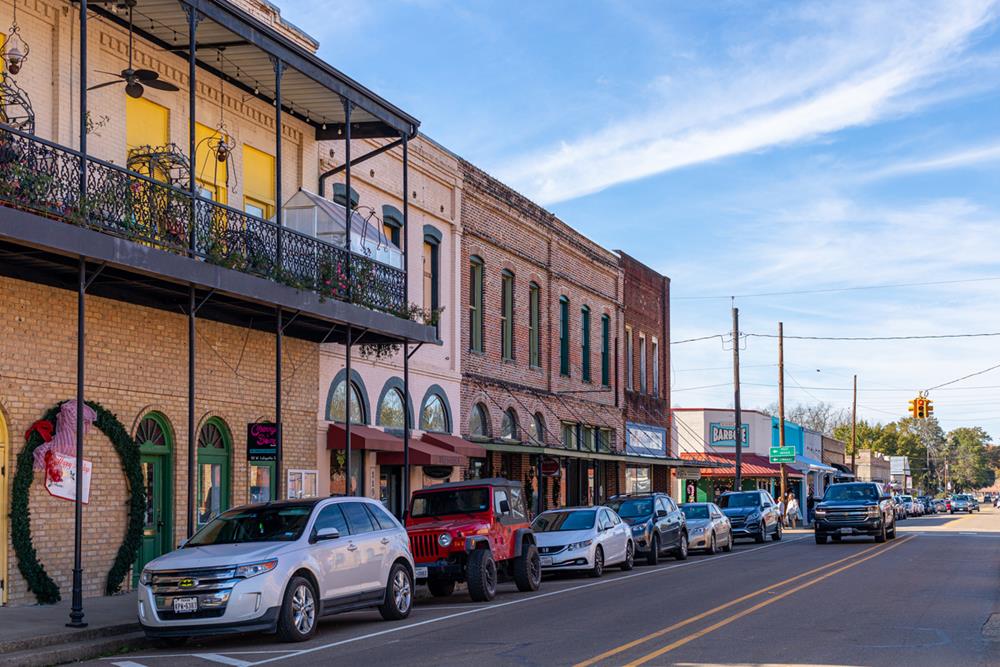
Start your Texas road trip in Jefferson, a town that feels like a step back in time with its beautifully preserved architecture and oak-lined streets. It’s a perfect snapshot of Southern charm and history. While you’re here, don’t miss the chance to explore the serene waters of Big Cypress Bayou. Whether you’re up for a leisurely boat tour or a quiet afternoon fishing, the bayou offers a peaceful escape into nature.
After you’ve had your fill of Jefferson’s historical sights, make your way to Joseph’s Riverport Barbecue for some of the best-smoked meats in East Texas. Grab a plate of their famous brisket, slathered in a rich, homemade BBQ sauce, and you’ll quickly see why it’s a must-visit for anyone passing through Jefferson.
Caddo Lake State Park
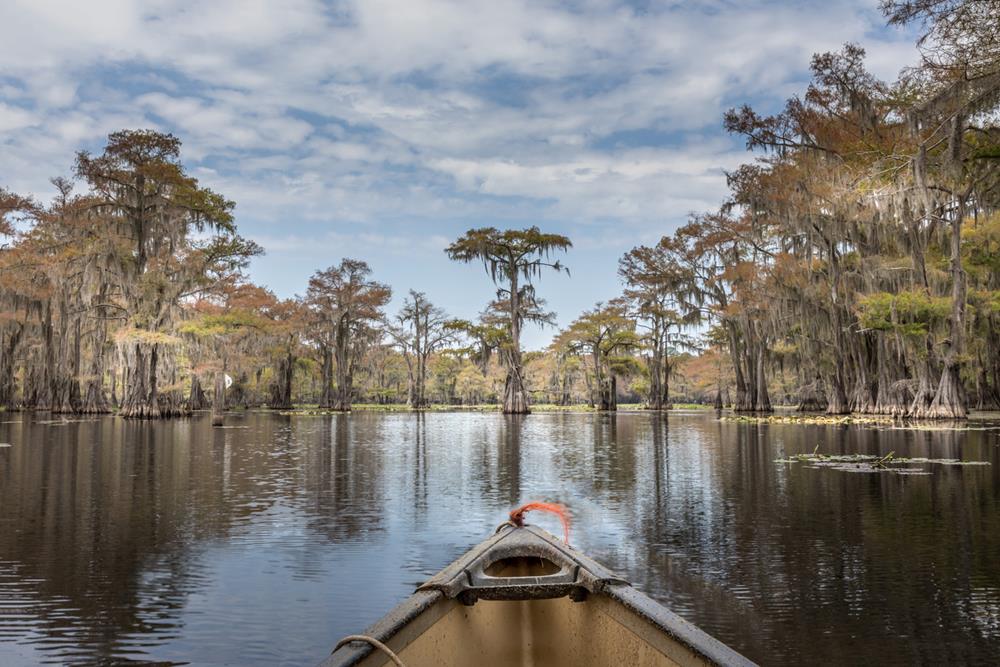
As you continue your journey westward, make sure to stop at Caddo Lake State Park. This unique natural treasure is known for its enchanting cypress swamps draped in Spanish moss, creating a scene straight out of a fairy tale. The tranquil waters are perfect for kayaking or canoeing, offering a peaceful way to connect with nature and maybe even spot some local wildlife.
Paddle quietly, and you might catch glimpses of alligators sunning themselves or hear the distant calls of owls and other birds nestled among the trees.
Nacogdoches
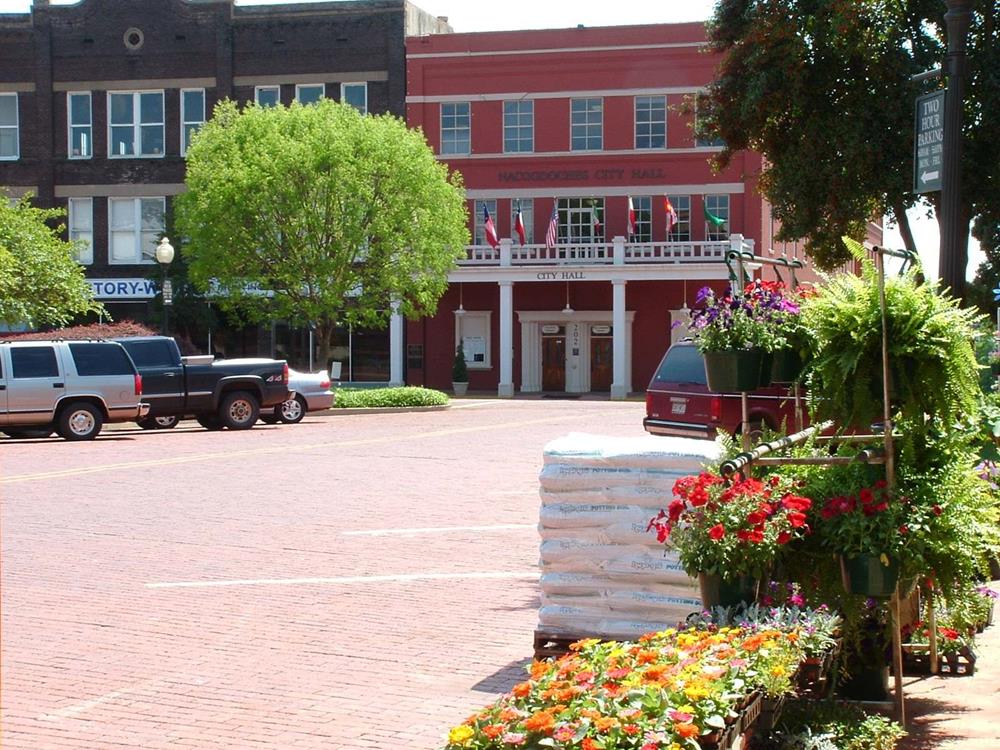
Drive southwest on US-59 S and go to Nacogdoches, proudly known as the oldest town in Texas. This small town is rich in history and charm, with well-preserved buildings and lush public gardens inviting a leisurely stroll. Be sure to visit the Sterne-Hoya House Museum and Library to get a taste of 19th-century life in Texas, and don’t miss the Ruby M. Mize Azalea Garden, where the vibrant flowers bloom colorfully in the spring.
While you’re soaking up the history and charm of Nacogdoches, make sure to swing by Dolli’s Diner for a bite. This cozy spot is the perfect place to fuel up with a hearty American breakfast or lunch.
Drive on to Huntsville, a city with deep roots in Texas history, where you’ll find the towering Sam Houston Statue proudly overlooking I-45. Known as “The Big Sam,” this monument honors the legendary Texan who played a crucial role in the state’s history. After paying your respects to Sam Houston, head to the nearby Sam Houston National Forest for some outdoor adventures. The forest offers miles of trails for hiking and biking, beautiful campgrounds, and serene spots for fishing and picnicking, making it a perfect place to stretch your legs and breathe in the fresh pine-scented air.
When hunger strikes in Huntsville, Mr. Hamburger is the place to go. This iconic burger joint, a staple since the 1950s, dishes out some of the best burgers in Texas.
Space Center Houston
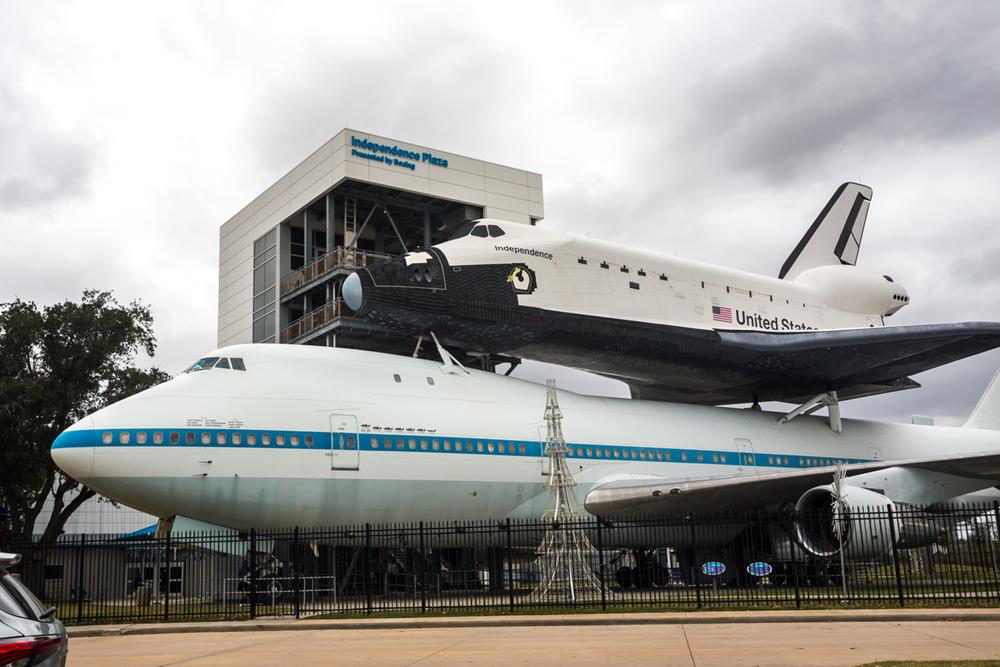
Head south on I-45 to Space Center Houston, where you can dive deep into the history and thrilling future of American space travel. This world-class space museum offers an unparalleled look at the achievements of NASA and its astronauts. Get hands-on with interactive exhibits, see real spacecraft, and even tour the historic Mission Control. Whether you’re a science buff or just curious about the cosmos, Space Center Houston offers an inspiring glimpse into the boundless possibilities of space exploration.
San Antonio
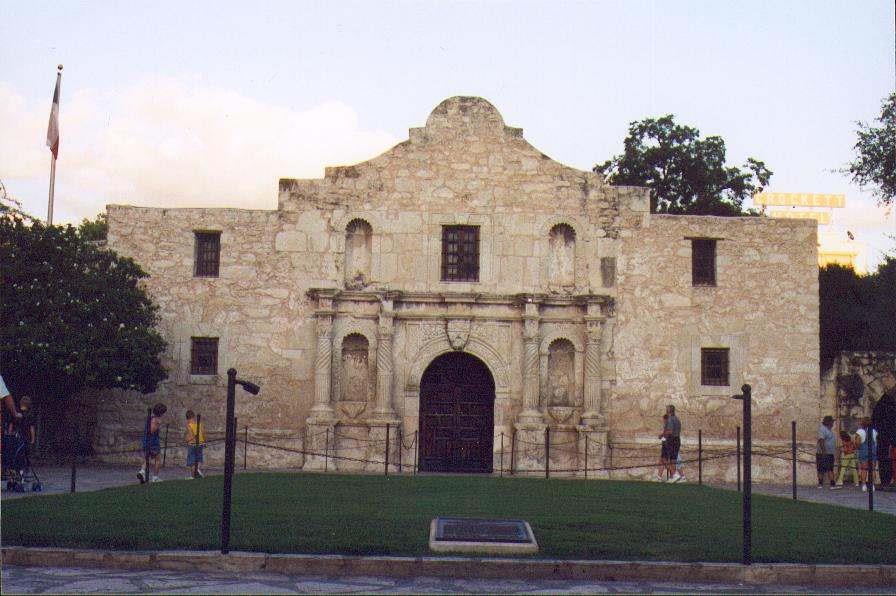
From the Space Center, take I-10 W to San Antonio, a city rich in history and culture. No visit to San Antonio would be complete without exploring the Alamo, the legendary site of the 1836 battle that symbolized Texan resilience and spirit. Take a moment to walk through this historic mission, learn about the heroes of Texas’ fight for independence, and honor their legacy.
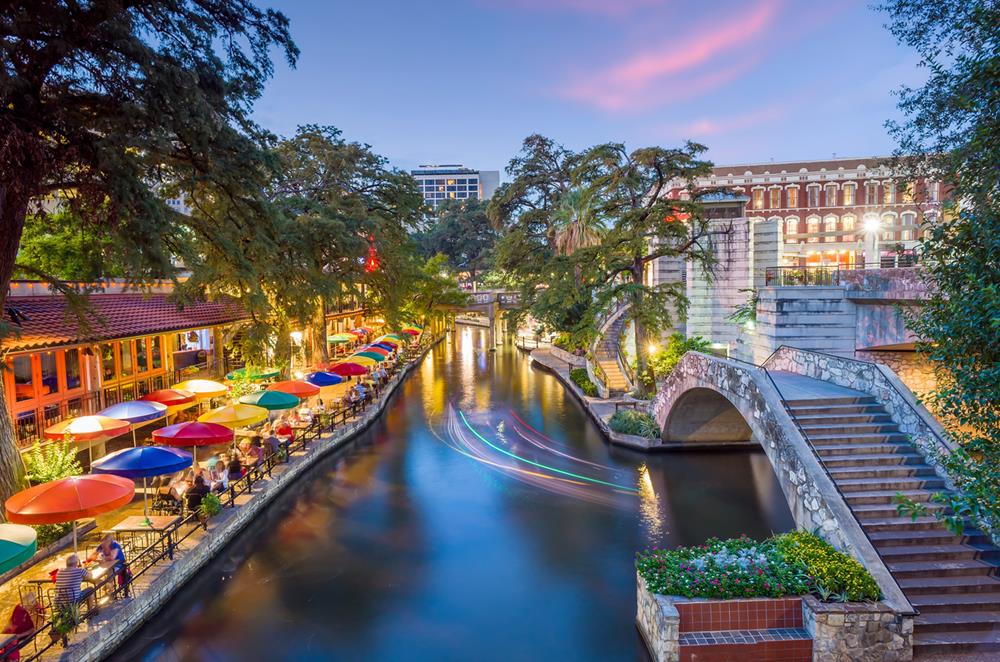
Afterward, stroll along the famous River Walk, a network of pathways along the San Antonio River lined with vibrant restaurants, shops, and lush greenery. It’s a wonderful place to experience the heart of the city, enjoy a meal, or simply relax by the water.
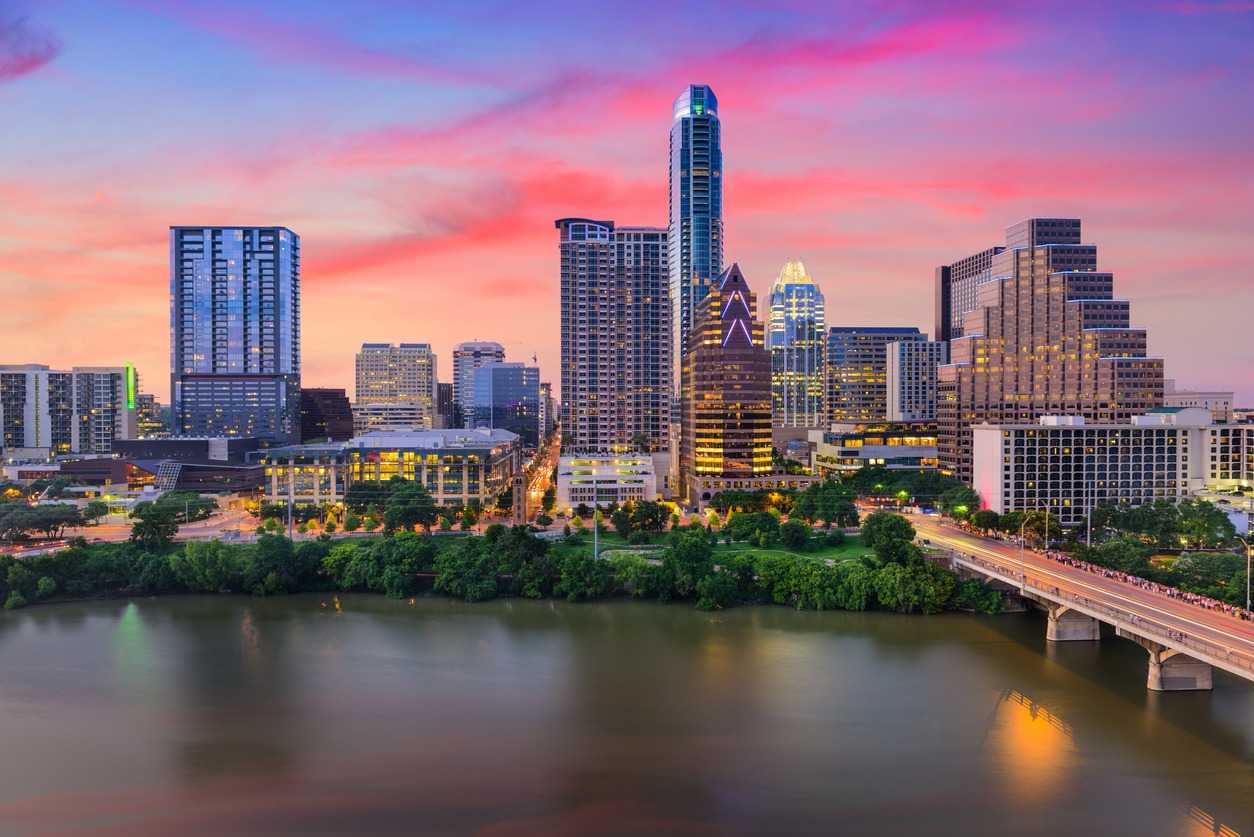
Continue on I-35 N and roll into Austin. Known as the “Live Music Capital of the World,” Austin’s eclectic music scene is pulsing with life at nearly every bar and restaurant downtown, especially along the famed Sixth Street. Be sure to visit Zilker Park, an urban oasis where locals picnic, jog, and paddleboard on the serene Lady Bird Lake.
Just outside the city, the rolling landscapes of the Texas Hill Country offer stunning scenic drives and abundant outdoor activities. Austin’s blend of urban culture and natural beauty always creates something new to discover.
Fredericksburg
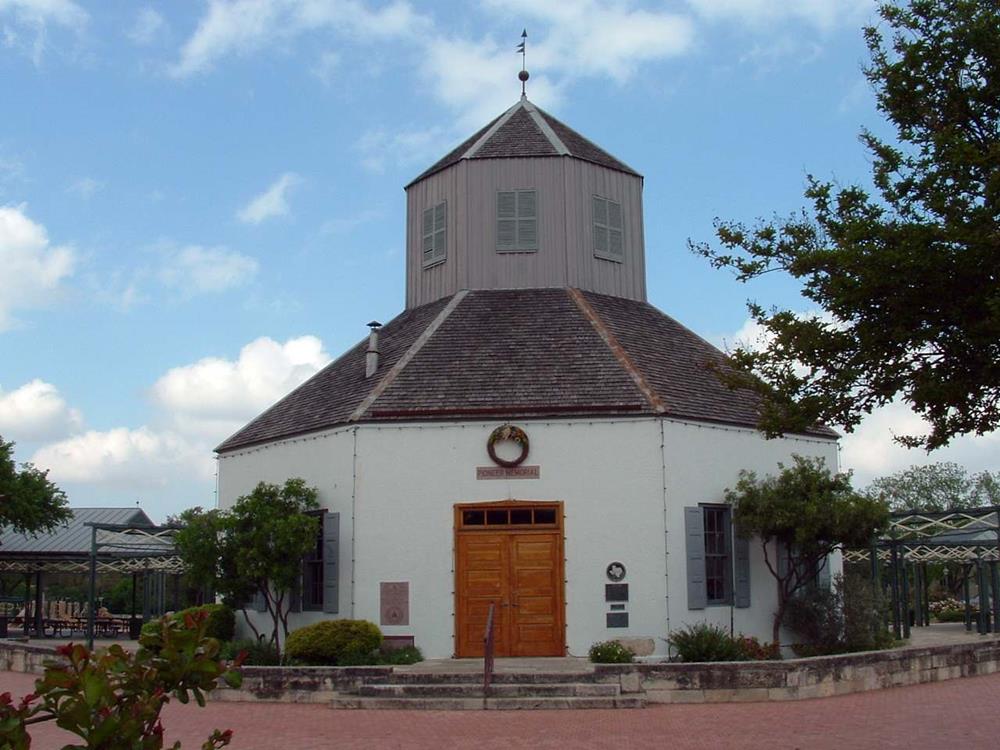
Take US-290 W and enjoy a scenic drive to Fredericksburg. Known for its German heritage and warm hospitality, this charming town is in the heart of Texas Hill Country. Wine enthusiasts will love exploring the area’s numerous vineyards and tasting rooms that dot the landscape—each offering a variety of fine wines that showcase the region’s unique flavors.
Don’t miss a chance to hike up to Enchanted Rock State Natural Area, where you can enjoy panoramic views of the surrounding countryside from atop a massive pink granite dome. Whether you’re sipping local wines or exploring rustic landscapes, Fredericksburg provides a peaceful retreat into country life.
Continue to San Angelo, a city that captures the essence of West Texas. From Fredericksburg, take US-87 N to San Angelo and enjoy Hill Country scenery and the beginnings of West Texas landscapes. When you’re there, take a leisurely walk along the Concho River Walk, a beautifully landscaped waterfront that is perfect for an afternoon stroll or even a bike ride. Be sure to visit historic Fort Concho, one of the best-preserved frontier forts in the country, where you can step back in time and experience military life in the 1800s through well-maintained exhibits and occasional reenactments. San Angelo blends its rich history with a vibrant arts scene, making it a compelling stop on your Texas road trip.
After soaking up some local history, make your way to The Concho Pearl Icehouse for a true Texas BBQ experience. Whether you’re in the mood for smoked brisket that melts in your mouth or spicy pulled pork, the Icehouse has you covered. Pair your meal with one of their craft beers and enjoy the local music scene—it’s the perfect way to unwind and savor the flavors of West Texas.

Continue to drive westward and prepare to be captivated by Marfa, a small town with a big reputation for art and minimalism, making it a cultural oasis in the desert. Marfa’s galleries and installations, like the famous Chinati Foundation, reflect the town’s modern artistic spirit, which contrasts sharply with its rugged surroundings. Make sure to stay until dusk to catch the mysterious Marfa Lights, an unexplained phenomenon that has puzzled residents and visitors alike for generations. Marfa is where the unexpected is the norm, making every visit a unique experience.
For a culinary twist, head to Food Shark, a renowned food truck that has become a must-visit in Marfa. Food Shark serves up Mediterranean-inspired dishes as creative as the town itself. Try their famous “Marfalafel” or a savory lamb kebab!
Big Bend National Park
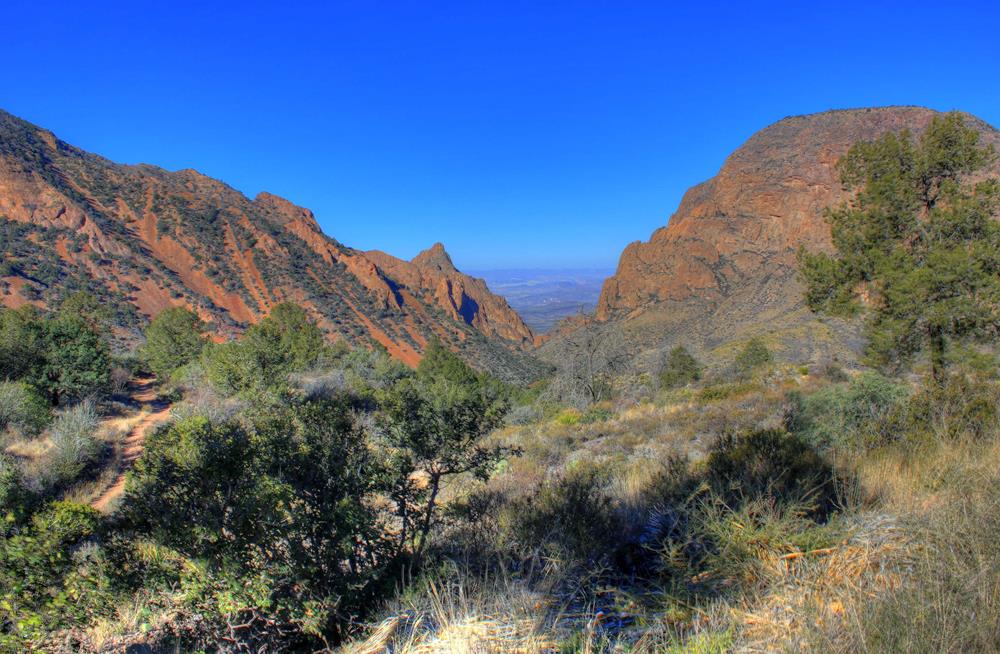
From Marfa, head south on US-67 S to Alpine, then take TX-118 S towards Big Bend. Big Bend National Park is a spectacular sight, showcasing Texas’ natural beauty, and it’s a must-see for anyone curious about the vast landscape of Texas. With its dramatic desert landscapes, diverse wildlife, and breathtaking vistas, Big Bend offers some of the most stunning hikes in the Southwest. Whether you’re trekking through the Chisos Mountains or rafting down the Rio Grande, Big Bend provides endless adventure and solitude. This majestic park is not just a stop—it’s a highlight, promising profound connections with nature and unforgettable panoramic views.
After a day of exploring Big Bend’s rugged beauty, drive to the nearby ghost town of Terlingua for a truly unique dining experience at the Starlight Theatre. This historic venue, originally an opera house in the early 1900s, now serves as a charming restaurant and live music spot where you can enjoy local Texan flavors under the stars.
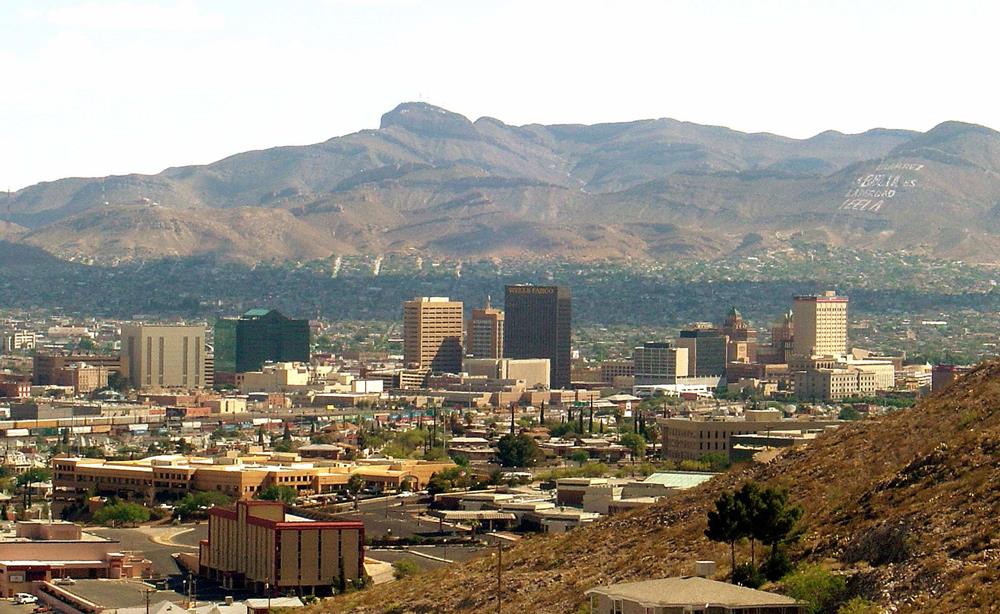
Return to Alpine and drive west on US-90 W to merge onto I-10 W towards El Paso. Your epic Texas road trip concludes here on the western edge of the state. Explore the Franklin Mountains State Park, offering hiking, biking, and rock climbing with spectacular views of the desert landscapes and city skyline. Don’t miss the historic missions of the El Paso Mission Trail, which are among the oldest in the United States. These missions tell the story of the city’s rich history and are a must-visit for anyone interested in the region’s heritage.
Cap off your journey at L & J Cafe, an iconic spot that’s been serving traditional Mexican cuisine since the 1920s. Located close to the Concordia Cemetery, this family-owned restaurant is beloved by locals for its authentic dishes like chile con carne and enchiladas Montadas, all served in a cozy, welcoming setting.
From the historic streets of Jefferson to the vibrant views of El Paso, each stop along this route offers a unique glimpse into the heart and soul of the Lone Star State. You’ve experienced the warmth of its people, tasted the richness of its cuisine, and stepped into the vastness of its landscapes. There’s a whole state waiting to be explored, and the road stretches out invitingly ahead. Safe travels, y’all!
- East to West Texas
- Scenic Drives
- Texas road trip
- Texas travel guide
Guide to Visiting Midland and Odessa Texas
Fun ideas for 3-day weekend getaways in texas, discover the beauty of lake texoma, recent articles, is marfa the ultimate hidden gem of texas, have you explored these lesser-known texan towns yet, el paso’s suburban bliss what to expect when relocating, more like this.

Driving across the Lone Star State? What do you see and feel?
Texas is the second-largest state in the country and if you drive from El Paso to Beaumont, it will take you almost 12 hours!
During the trip, you will see mountains, deserts, rolling hills, grasslands and coastal areas. Therefore Texas has such diverse weather and extremely challenging weather forecasts.
What You Need To Know
Texas is 268,597 square miles second largest state next to alaska which is 663,000 square miles the hottest temperatures ever recorded in texas 120 degrees in monahans, tx in 1994.
However, it is not the only reason; Texas also has eight unique climate zones according to the Köppen Climate Classification .
- Hot Desert (BWh)
- Cold Desert (Bwk)
- Hot semi-arid (BSh)
- Cold Semi-arid (BSk)
- Humid Subtropical (Cfs)
- Temperate Oceanic (Cfb)
- Hot-summer Mediterranean (Csa)
- Warm-summer Mediterranean (Csb)
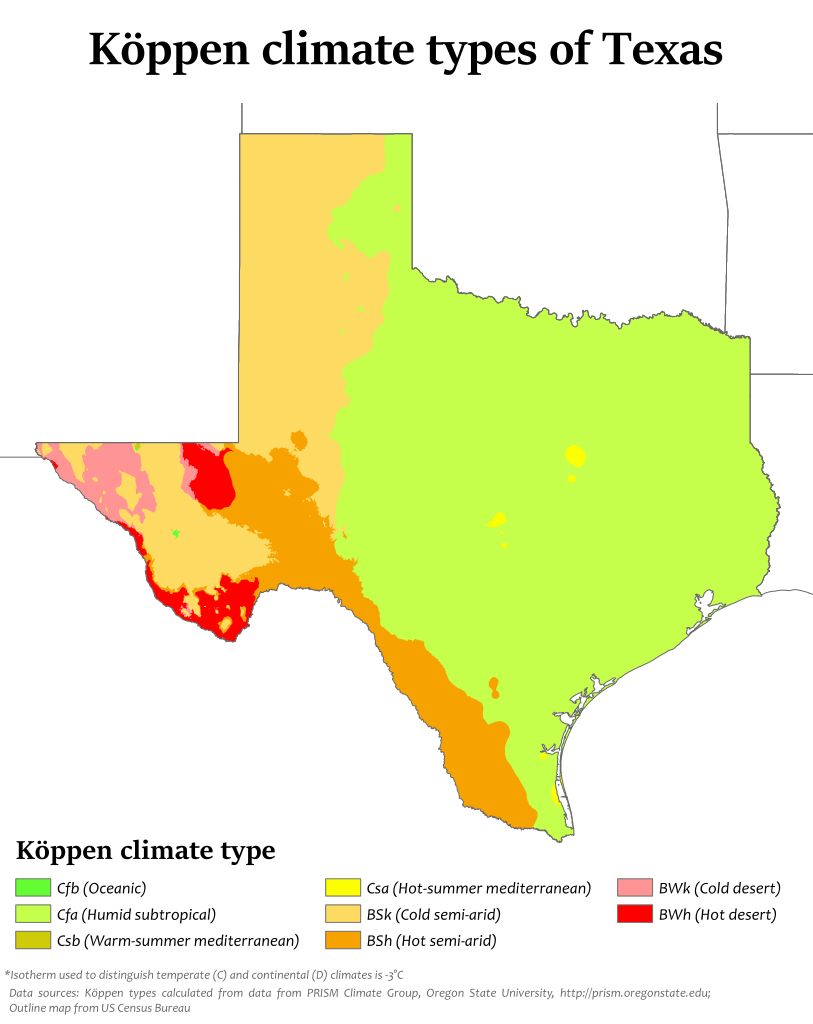
To make it simple, we have an arid climate in West Texas and a subtropical climate in East Texas, the dividing line is Interstate 35.
This makes Texas unique in our weather because we have everything from hurricanes along the coast to tornado outbreaks in the northern part of the state, flash flooding in Central Texas and dust storms out west. That does not mention any type of winter weather across the state.
Coastal Plains
The coastal plains of Texas include the cities of Houston, Corpus Christi and Brownsville. This region receives the most rain with an average of 60 inches a year or higher when there are tropical storms present.
It records the most cloudy days of anywhere else in the state and its comparable “climate country” is Taiwan or the Philippines.
Hill Country
This part of Texas is the dividing line between the semi-arid climate west and the sun-humid climate east. It runs right along the Balcones fault line and includes the cities of Austin, San Antonio, Fredericksburg and Junction.
In this region, the summers are hot and the winters are mild, with a few cold snaps. The wettest months of the year are April and May when we also see the highest threat of severe weather.
On average, this region receives between 20 inches (west) to 35 inches (east) or rain per year. Central Texas is unique in the landscape's structure with its many hills, rivers and lakes and which make it vulnerable to flash flooding . Its comparable “climate country” is Israel or Lebanon.
North Texas
This is Tornado Alley with an average of 139 tornadoes a year. It contains the Prairies and Lakes region, the Piney Woods, and the Panhandle-Plains. This area is defined but Interstate 35 between the semi-arid climate and the sub-tropical climate. Cities such as Amarillo, Lubbock and Wichita Falls are known for droughts, tornadoes, snow and clear summer days. Dallas, Fort Worth and Waco are in the “Prairies and Lakes region” which sees more rain than snow and is in the bullseye for severe weather and flooding. Temperatures in this region can swing widely throughout the year. Average highs in January are in the 50s but in July, they are in the 90s. It is comparable “climate country” is Southern China.
This area is the Trans-Pecos Region or Big Bend Country. It comprises the Chihuahua Desert and mountain ranges. The highest elevation is Guadalupe Peak at 8.751 feet above sea level.
The number of clear days far outweigh the cloudy days and the average amount of rain is just 16 inches per year.
There is low humidity and low dew points. The wind blows constantly out west so our many Texas wind farms are located in this region. Its comparable “climate country” is Iraq or Iran.
South Texas
This region includes the semi-arid ranch country and the wetter Rio Grande Valley. It’s also considered the southernmost tip of the American Great Plains. It’s warm most of the year, with boiling and humid summers. The wettest months of the year are April and May. Its comparable “climate countries” are India, Vietnam or Thailand.
Texas weather is constantly changing! It is the topic of conversation at any gathering but with the knowledge of different climate zones and topography, you can wow your friends and co-workers.
Follow me on Facebook , Twitter and Instagram for some more cool weather tidbits.
LATEST NEWS
7 Undeniable Differences Between The Eastern And Western Parts Of Texas

Katie Lawrence
Katie Lawrence is a Southeast Texas native who graduated 18th in her high school class with a GPA of 4.25. She attended college in the Houston area and began writing for OnlyInYourState in 2015. Today, Katie writes, edits, and performs several other tasks for OnlyInYourState and has never been more passionate about a job before. Outside of work, you can likely find her curled up on with a hot cup of coffee, practicing yoga, baking, or exploring the beautiful Lone Star State (in particular, the vast and mystical West Texas desert).
More by this Author
Texas is so big, it could practically be divided into several states – and you’d almost think it already was, based on the immense differences from one region to the next. From the culture to the landscape and everything in between, going from El Paso to Beaumont will have you feeling like you’re on a whole new planet – much less the same country and the same state. The following are 7 of the biggest differences between East and West Texas.
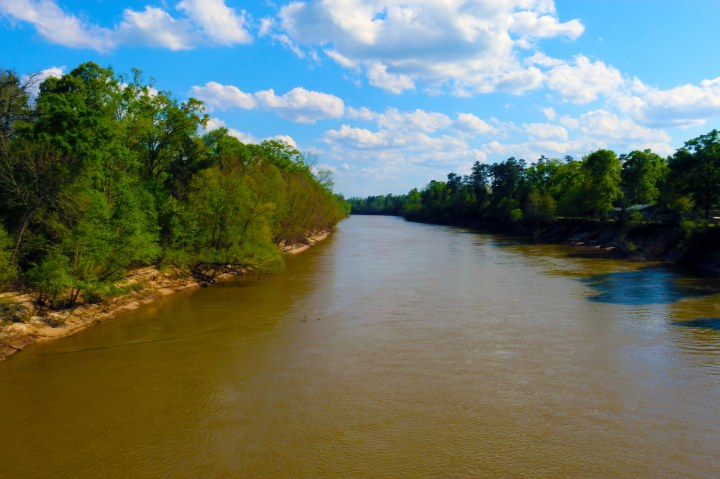
Related Stories
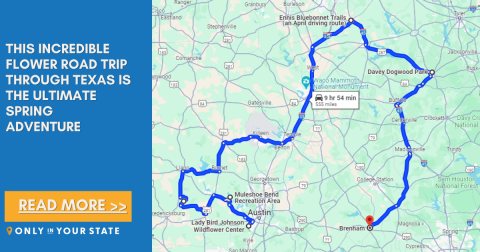
The Incredible Flower Road Trip Through Texas Is The Ultimate Spring Adventure
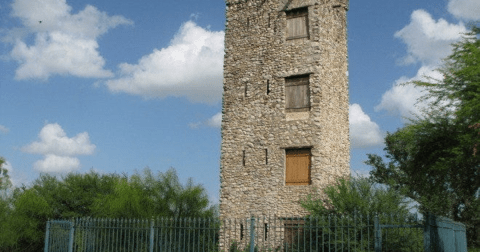
The Incredible Hike In Texas That Leads To A Fascinating Abandoned Castle Tower
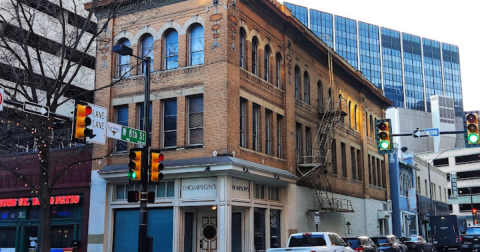
This Speakeasy Hidden In A Former Bookstore In Texas Is Perfect For A Date Night
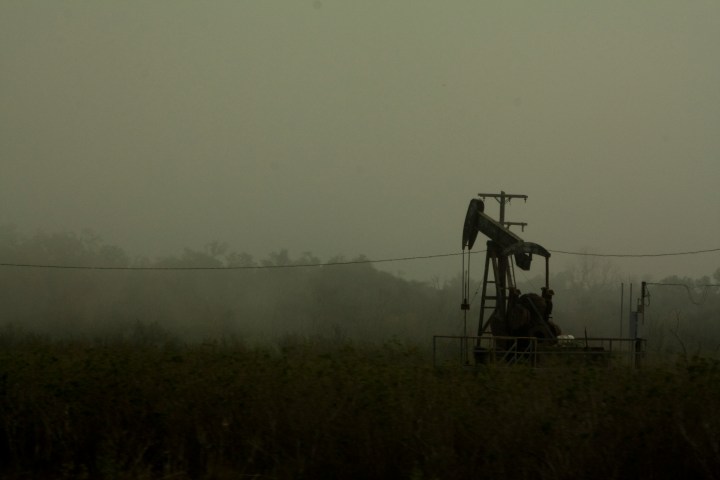
Despite our differences, we’re all united under the Texas flag and share the same amount of unashamed pride for the Lone Star State. If you don’t believe me, check out 12 Reasons Why Texas Is The BEST State.
How many of these differences can you relate to? Are there any others we left off? Let us know!
OnlyInYourState may earn compensation through affiliate links in this article. As an Amazon Associate, we earn from qualifying purchases.
Want more Texas in your inbox?
Get the latest on things to see, do, and eat around Texas!
An error occured.
Related Articles
- 7 Waterfront Retreats In Texas That Are Perfect For Warm Weather Adventures
- Here Are The 20 Absolute Best Places To Stay In Texas
- This Is The Most Texas Sound You'll Ever Hear, And We Can't Stop Listening To It
- This Enchanting Garden Restaurant In Texas Will Transport You To Another World
- Here Are Our 13 Favorite Eco-Friendly Travel Items To Celebrate Earth Day
- Here Are The 14 Most Unique Beaches In The United States
- The 8 U.S. Properties On Vrbo's 2024 Vacation Home Of The Year List Are As Dreamy As Can Be
- 12 Airbnbs That Are Available To Rent For The 2024 Indianapolis 500
National Geographic content straight to your inbox—sign up for our popular newsletters here

The essential guide to visiting Texas
Here’s everything you need to know about exploring the Lone Star State—when to go, where to stay, what to do, and how to get around.

Why you should visit Texas
Big skies and bigger parks. Barbecue and Tex-Mex food (don’t miss the breakfast tacos). A vibrant live music scene in Austin and world-class birding in South Texas. Plus, cowboys .
Best time to visit Texas
Spring: March and April bring colorful wildflowers (indigo-hued bluebonnets , red-and-yellow Indian blankets) to the highways and backroads in Central Texas. In Austin, the Lady Bird Johnson Wildflower Center has 284 acres of native plants inspired by the Texas-born first lady . Outdoor festivals crowd the calendar. Austin’s South by Southwest Festival offers films and concerts each March; San Antonio ’s ebullient Fiesta celebrates the city’s Hispanic heritage with parades, a stuff-your-face food festival , and concerts in April. And midway between Austin and Houston , the March Round Top Antiques Fair fills tents, barns, and hayfields with French furniture, vintage cowboy boots, and more.
Summer: Y’all, it’s hot, with temperatures often soaring above 100 degrees Fahrenheit. Beat the heat at one of the state’s Gulf of Mexico beaches , including South Padre Island , where you can watch hatchling releases of baby Kemp’s Ridley sea turtles . Or do as the locals do and go tubing in the Guadalupe River near New Braunfels or in the Frio River in Garner State Park .
Autumn: Cooler temps lure Texans outdoors to events such as the Austin City Limits Music Festival , with bands in Zilker Park, or the State Fair of Texas in Dallas where you can eat a corn dog and wave to Big Tex , the 55-foot-tall animatronic greeter. Lost Maples State Natural Area , northwest of San Antonio, has the state’s best fall colors. Celebrate New Braunfels ’ German heritage at Wurstfest .
Winter: Mild weather makes outdoor activities pleasant around the holidays. In San Antonio, stroll the Riverwalk, where the bald cypress trees are draped with twinkling lights. Amid the Victorian downtown of Galveston , Dickens on the Strand brings costumed revelers and roving musicians.

Four of America’s largest cities are in Texas.
In the south, San Antonio was once a part of Spain and later Mexico, a history that shows up at the Alamo and the San Antonio Missions . Houston has high culture (art museums, the acclaimed Alley Theatre ) and the NASA Johnson Space Center , where tram tours take in Mission Control and other sites.
Sister cities Dallas and Fort Worth are just 30 miles apart in North Texas. In “Big D,” catch home games from the Dallas Cowboys football team or hear live music in funky Deep Ellum . A good art museum scene and cowboy culture rule in neighboring Fort Worth, where hatted herders lead longhorn cattle through the Stockyards District every day.
The capital city of Austin is known for live music, barbecue, and Barton Springs Pool , a natural, spring-fed watering hole and the soul of the city.
In the Rio Grande Valley, an agricultural region bordering Mexico, there are cities such as McAllen and Brownsville plus the varied wildlife habitats (wetlands, thorn forests) of the World Birding Center .
In West Texas, El Paso offers Tex-Mex bordertown culture amid the stark beauty of the Chihuahuan Desert and the foothills of the Franklin Mountains , best explored via mountain bike or hiking trails.

Parks and smaller cities
The Hill Country
The rolling terrain of the Hill Country in Central Texas is home to Fredericksburg , with its throwback main street full of indie boutiques and German restaurants plus 60-plus wineries in and around town. You’ll also find cowboy culture in Bandera and the beer-drinking enclave made famous in Waylon Jennings’ song “ Luckenbach , Texas .”
The Big Bend
Two of the state’s largest parks— Big Bend National Park and the adjacent Big Bend Ranch State Park —lure hikers, bikers, and campers to the desert and mountain landscapes of West Texas. Stargaze at the University of Texas’ McDonald Observatory in Fort Davis, or check out the Donald Judd art installations in funky Marfa .
Texas Coast
The longest barrier island in the world, Padre Island stretches for 113 miles from the tip of South Texas to Corpus Christi . Farther north, Galveston Island is the birthplace of Juneteenth and home to Victorian mansions.
Panhandle
Palo Duro Canyon , the second largest canyon in the U.S. and a state park, carves through the Panhandle for 120 miles.

Getting in and around Texas
By plane: Dallas-Fort Worth International, George Bush Intercontinental in Houston, and Austin-Bergstrom International offer domestic and international service; San Antonio International serves Mexico and other cities in the U.S.
By bus: Vonlane and RedCoach have luxury bus service between Austin, Dallas/Forth Worth, Houston, and San Antonio. Valley Metro serves the Rio Grande Valley.
By train: Amtrak operates two train routes through Texas—the Texas Eagle and Sunset Limited .
By car: Texas is easily accessible via major interstates including I-10, I-20, I-35, I-45, and I-37. One of the most scenic drives is FM 170, or the River Road, which hugs the Rio Grande and cuts through Big Bend Ranch State Park between Presidio and Lajitas.
In town: Major cities including Dallas, Fort Worth, Houston, San Antonio, Austin, and El Paso have bus service and bike share systems. DART rail in Dallas serves 65 stations. Austin’s CapMetro rail operates a single line from downtown to the northern suburbs. Houston’s three METRORail lines connect tourist destinations. The Streetcar in El Paso loops through uptown and downtown.

Know before you go
Cultural history: Native Americans have occupied Texas for more than 14,000 years. Coastal tribes like the Karankawa were semi-nomadic, the Caddos in East Texas and Jumanos in the West farmed and traded. Comanches and Apaches hunted bison and raided villages in the north and west. Enslaved Africans helped the Spanish settle parts of Texas in the 17th and 18th centuries.
The flags of France, Spain, and Mexico once flew over the state, which declared its independence from Mexico in 1836 and joined the U.S in 1846. Texas seceded from the Union and joined the Confederate States of America in 1861. The end of enslavement was announced in Galveston at the end of the Civil War, leading to the Juneteenth holiday . Immigrants from around the world, including Germany and Czechia, arrived during the 18th and 19th centuries, making their marks on places such as New Braunfels, Fredericksburg, and Kerrville .
LGBTQ+ : Texas ranked 27th in a 2020 24/7 Wall St. report of the most LGBTQ+-friendly states in the U.S. Despite Texas’ conservative politics, cities such as Austin, Dallas, Fort Worth, and San Antonio get high marks on the Human Rights Campaign 2022 Municipal Equality Index scorecard.

How to visit Texas sustainably
Help preserve habitat by sticking to designated trails and roads. Support businesses that promote dark night skies. It’s legal to drive on public beaches, but watch for wildlife, including nesting sea turtles, and use reef-safe sunscreen. The Love Fredericksburg and Port A Way stewardship campaigns encourage visitors to keep an eye out for wildlife and pick up litter. Look for LEED-certified hotels and restaurants committed to selling locally grown food.
What to read
Empire of the Summer Moon , by S.C. Gwynne. This sweeping historic account follows four decades of fighting with the Comanches, Spanish colonialism, the decimation of the American bison and the arrival of railroads.
Forget the Alamo , by Bryan Burrough, Chris Tomlinson and Jason Stanford. The myths surrounding the Texas “cradle of liberty” get debunked and explored in this fascinating look at the evolution of the Lone Star State, its legends, and its prejudices. Valley of Shadows , by Rudy Ruiz. In this novel set in 19th-century West Texas, tensions along the Mexican border bubble up in dramatic, dark style—with a dash of magical realism.
( For more tips on what to do in Texas, see our Explorer’s Guide .)
Related Topics
- NATIONAL PARKS
- STATE PARKS
- DARK-SKY PRESERVES
- CITY GUIDES
You May Also Like

Visiting Texas? Here’s what the locals love.

What’s better than autumn at a historic inn? Here are 10 to visit.
Free bonus issue.

Here are the best ways to get outdoors in all 50 states

The essential guide to visiting San Diego

10 best things to do in Texas


25 essential drives for a U.S. road trip

The essential guide to visiting Scotland
- Perpetual Planet
- Environment
- History & Culture
- Paid Content
History & Culture
- Photography
- Terms of Use
- Privacy Policy
- Your US State Privacy Rights
- Children's Online Privacy Policy
- Interest-Based Ads
- About Nielsen Measurement
- Do Not Sell or Share My Personal Information
- Nat Geo Home
- Attend a Live Event
- Book a Trip
- Inspire Your Kids
- Shop Nat Geo
- Visit the D.C. Museum
- Learn About Our Impact
- Support Our Mission
- Advertise With Us
- Customer Service
- Renew Subscription
- Manage Your Subscription
- Work at Nat Geo
- Sign Up for Our Newsletters
- Contribute to Protect the Planet
Copyright © 1996-2015 National Geographic Society Copyright © 2015-2024 National Geographic Partners, LLC. All rights reserved
10 Best Road Trips You Can Take Through The Scenic State Of Texas
Discover the best road trips in Texas, from Gulf Coast adventures to Hill Country charm. Explore scenic wonders and vibrant culture.
- Texas offers stunning landscapes, vibrant cities, and rich cultural experiences, making it perfect for road trips filled with incredible scenery and activities.
- Some of the best road trips through Texas include exploring the charming small towns and wineries of Hill Country, marveling at the desert and mountain vistas of Big Bend National Park, and relaxing on the serene sandy beaches of the Gulf Coast.
- From following the iconic Route 66 through the Texas Panhandle to discovering lakes, forests, and rivers in the scenic northeastern corner, there are endless options for scenic roads in Texas that show off the state's most stunning vistas, charming towns, and rich culture.
Texas has stunning landscapes, vibrant cities, and rich cultural experiences. From basking on the golden beaches of South Padre Island to hiking the rugged mountains and deserts of Big Bend National Park , the Lone Star State has incredible scenery and activities to enjoy on a road trip.
Whether someone wants to cruise along the legendary Route 66, wine taste their way through Hill Country, or explore ghost towns in west Texas, the options for traveling through what is easily one of the best states for a road trip are practically endless. Here are some of the best road trips in scenic Texas that showcase the state's most stunning vistas, charming towns and cities, and rich culture.
Food-Fueled Road Trip: The Guide To The Best BBQ Restaurants In Texas
10 hill country loop: wander the rolling hills and valleys, a scenic driving loop through the beautiful texas hill country, with charming small towns, wineries, and endless views..
This route is one of the best road trips in Texas ; it's a central Texas loop that takes travelers through the rolling hills and charming small towns of Hill Country. Highlights of this drive include visiting Luckenbach, the "world's smallest honkytonk," with a colorful history and lively music scene. Travelers can also hike and take in the views from Enchanted Rock, a pink granite dome that juts up 425 feet from the surrounding plains.
The loop winds through Fredericksburg, where visitors can taste wine at one of the many wineries and visit unique museums like the National Museum of the Pacific War. End the Hill Country road trip in the lively city of Austin, exploring the music venues, BBQ joints, and hip SoCo neighborhood.
- Road Trip Length: 316.9 miles
- Major Stops: Austin , Fredericksburg , Luckenbach , Johnson City , Wimberley
- Best Time to Visit: Spring for wildflowers
9 Big Bend Country: Marvel At Desert and Mountain Vistas
Adventure through west texas to big bend national park, home to stunning desert scenery and rugged mountains..
Big Bend National Park in southwest Texas offers visitors stunning desert and mountain scenery. One of the most scenic road trips in Texas, travelers traversing this route can hike trails like the Chisos Mountain Loop to earn panoramic views and see unique wildlife like javelinas. Plus, dipping in the Rio Grande River offers a refreshing cool from the desert heat.
Visitors can stargaze at the nearby McDonald Observatory at night and see constellations under dark skies. The trip also includes stops in charming towns like Marfa, famous for the mysterious Marfa Lights, and Alpine, home of the Museum of the Big Bend.
- Road Trip Length: 250 miles
- Major Stops: Big Bend National Park , Marfa , Alpine
8 Gulf Coast Getaway: Relax On Serene Sandy Beaches And In Scenic Seaside Towns
Cruise along the sparkling gulf coastline, soaking up the sun, seafood, and small beach towns..
A road trip along the Texas Gulf Coast offers beautiful beaches, fresh seafood, and fun coastal attractions. Highlights of this route, which is among the most scenic drives in Texas on the coast, include enjoying miles of remote beaches on South Padre Island, perfect for beachcombing, building sandcastles, fishing, and swimming.
In Galveston, travelers can catch a shrimp boat ride and learn about this historic industry. The USS Lexington in Corpus Christi offers the chance to explore a WWII aircraft carrier. And no Texas road trip is complete without spending time in Houston, the state's largest and most cosmopolitan city, to experience the museums, restaurants, and NASA complex.
- Road Trip Length: 1630 miles
- Major Stops: Houston , South Padre Island , USS Lexington
7 Route 66 Road Trip: Follow Iconic Mother Road Through Texas Panhandle
Travel a slice of the legendary route 66 through the wide-open texas panhandle and step back in time..
Cruising along the Texas stretch of historic Route 66 provides a fun blast from the past. Road trippers can enjoy some of the top stops along Route 66 in Texas; they'll discover mid-century motels, vintage diners serving homemade pies and classic sandwiches, and plenty of quirky roadside sights. A highlight is stopping at the Cadillac Ranch, which is one of the best attractions on Route 66 where 10 graffiti-covered Cadillacs stand nose-first in the dirt.
The trip also winds through charming small towns like Shamrock, famous for its water tower decorated as a shamrock, McLean and Phillips 66 station museum, and more museums that showcase the history of Route 66. The starting point in Texas is Glenrio, a ghost town on the border with New Mexico. From there, travelers can continue to California if they wish to extend their adventure.
- Road Trip Length: 2400 miles
- Major Stops: Amarillo , Cadillac Ranch , Midpoint Cafe
10 Things You Probably Didn't Know About Historic Route 66
6 northeast texas getaway: discover lakes, forests, and rivers, meander past pine forests, lakes, and rivers in texas' scenic northeastern corner..
Northeast Texas often gets overlooked, but it makes for a lovely adventure since the region boasts some of the best road trip routes in Texas. Highlights include boating, waterskiing, and fishing on Lake Texoma, one of the largest lakes in Texas. In historic Jefferson, travelers can stroll through antique shops, tour historic homes, and ride on a steam train, while outdoor adventures abound at Cooper Lake State Park, with hiking, biking, camping, and abundant wildlife.
Meanwhile, Caddo Lake provides beautiful scenery for boating and ample opportunities for birdwatching and wildlife spotting of alligators, turtles, and more. End your northeast Texas trip in nearby Dallas to take in museums, pro sports, and a happening restaurant scene, or head to Texarkana and see where Texas meets Arkansas.
- Road Trip Length: 127 miles from Dallas, 77 miles from Texarkana
- Major Stops: Dallas , Cooper Lake , Caddo Lake , Jefferson
5 Texas BBQ Road Trip: Sample Smoked Brisket Across The State
A mouthwatering pilgrimage to texas' legendary barbecue joints, from hole-in-the-wall to world-famous restaurants..
Wondering where to get authentic Texas BBQ ? For the ultimate foodie road trip across central Texas, hit the state's legendary barbecue hotspots. The trip should start in Austin, where favorites like Franklin Barbecue, la Barbecue, and Valentina's Tex Mex BBQ serve up tender brisket, fall-off-the-bone ribs, spicy sausage, and more.
Continue feasting on melt-in-your-mouth smoked meats at small-town spots like Louie Mueller and Snow's BBQ in Taylor, and then go on to Lockhart, the so-called "Barbecue Capital of Texas." Don't miss renowned joints like Black's BBQ, Smitty's Market, and Kreuz Market. End the foodie road trip in Elgin at Southside Market, the oldest barbecue restaurant in Texas, dating back to 1882.
- Road Trip Length: 330 km
- Major Stops: Lockhart , Austin, Lexington
These Are Some Of The Best BBQ Restaurants In The U.S.
4 texas dance hall road trip: twirl and whirl at historic venues, two-step back in time at texas' historic and charming dance halls, steeped in lone star culture..
One of the best Texas road trips for those seeking to Experience Texas' lively western culture and two-stepping music scene should look no further than this country dance hall adventure. Texas dance halls are historic, community-gathering places that host regular live country music and dancing nights.
Stop at Gruene Hall near New Braunfels, billed as the "oldest continually operating dance hall in Texas." Dance the night away or enjoy a meal on their patio overlooking the Guadalupe River. John T. Floore's Country Store in Helotes has drawn crowds since 1945 with its lively atmosphere and wooden dance floor. Kicking up dust at Luckenbach Dancehall, made famous by Waylon Jennings, offers an authentic Texas honky tonk experience. And no country music trip is complete without visiting Billy Bob's.
- Road Trip Length: 400 miles
- Major Stops: Gruene , Luckenbach, Albert , Anhalt
3 Texas Wine Country Road Trip: Sip In the Lone Star State's Vineyards
Taste award-winning wines in texas hill country's vineyards and small-town wineries..
One of the best route trip routes in Texas for wine lovers is the journey through the up-and-coming Texas wine region of Hill Country. Over 50 wineries producing award-winning wines dot the landscape between Austin and Fredericksburg, producing varietals like Tempranillo, Viognier, and Cabernet Sauvignon.
Start the road trip in Fredericksburg, visiting wineries like Pedernales Cellars and taking in the charming Main Street. Head to Hye, where William Chris Vineyards offers tastings against a backdrop of scenic views. Stop at Texas Hills Vineyard in Johnson City for a wine and cheese pairing.
End the wine-tasting tour in Stonewall, home of Becker Vineyards, one of the most famous in Texas. Relax at the wine bars, restaurants, and tasting rooms between wineries. Prime time to visit is during Texas Wine Month each April when special events and live music make it an even more lively experience.
- Road Trip Length: Fredericksburg to Stonewall: 16 miles, Stonewall to Johnson City: 15 miles, Johnson City to Driftwood: 38 miles, Driftwood to Dripping Springs: 14 miles
- Major Stops: Fredericksburg , Johnson City , Hye
2 Crystal Beach: Relax On The "Blue Wave Beach"
Soft white sands and calm blue waters create a peaceful beach escape on the bolivar peninsula..
This journey is a nice short road trip in Texas for those looking for a beachy day trip. Located on the Bolivar Peninsula off the coast of Galveston, Crystal Beach offers 32 miles of sandy coastline and calm, shallow waters perfect for swimming and fishing. It's a beach town with a relaxed pace of life, where visitors can spend days relaxing in the sun, building sandcastles, beachcombing, dolphin watching, or fishing from the long Galveston Jetties.
The Galveston Island Historic Pleasure Pier has carnival rides and midway games for those wanting more action. Travelers can also take a short ferry ride from the peninsula to Galveston to experience its attractions. But the best pastime on Crystal Beach is simple relaxation on this tranquil stretch of the Texas coast.
- Distance : 17 miles from Galveston
- Major Stops : Crystal Beach , Pleasure Pier , Fishing Charters
1 Bluebonnet Trail: Witness Spring Flowers Blanket Hill Country
Each spring, vibrant wildflower blooms paint a sea of blue along texas hill country roads..
This signature drive is one of the best Texas road trip routes in the spring. Vibrant bluebonnets blanket the Texas Hill Country each spring, creating a spectacular floral sight. The ideal way to take in these signature vivid blue state flowers is by driving the Bluebonnet Trail, located an hour west of Austin. This 25-mile loop follows ranch land and winding roads that explode with color in March and April.
From Burnet to Marble Falls, the landscape comes alive with rolling blue carpets of bluebonnets. Be sure to stop frequently for Instagram-worthy photos of the seasonal bloom. Take advantage of the Equestrian Trail Rides during these months, where one can saddle up horses and ride through waves of bluebonnets. It's a quintessential Texas experience and one of the prettiest seasons for a drive.
- Road Trip Length : 16-mile loop
- Major Stops: Equestrian Center , Vista Ridge Ranch , Willow City Loop
- Best Time to Visit: March-April
Andy Rhodes | 30 October 2019
Texas trip planner: 7 wild routes through the lone star state.
From cacti-speckled badlands to the best barbecue joints in town – earn your spurs in the Lone Star State and plot the perfect wild escape with our handy guide...

A Texas Longhorn Steer (Shutterstock)
After nearly 45 minutes of gently ascending the Lost Mine Trail, I turned the corner to be greeted by the topographical glory of Juniper Canyon. This rocky wonder, set deep in Big Bend National Park, soon became one of my favourite views in the whole of Texas.
Layers of mountains – each a slightly different shade of pastel colour – stretched across the landscape as far as the eye could see. Spiky desert cacti punctured the scene to set the mood and, best of all, the rock formation beside me happened to be shaped like a chiselled armchair. I quickly settled into my throne of nature and soaked up the astounding scenery for nearly an hour.
What struck me – beyond the magnificent visual canvas – was the utter lack of any human interference. There were no motor sounds; there weren’t any telephone lines, planes or scraps of paper.

Santa Elena Canyon, Big Bend National Park (Shutterstock)

Cactus Flowers and Indian Blanket Wildflowers, Texas (Shutterstock)
It was highly possible that little had changed here since my spot had been similarly occupied by the region’s indigenous inhabitants thousands of years ago.
For that blissful hour, I let my eyes and thoughts wander and disperse across the colossal untouched Texas landscape.
I spent the next few days exploring Big Bend’s other natural wonders, from traversing the mighty Rio Grande River and relaxing in its hot springs, to marvelling at sheer vertical canyon walls, to savouring the delicacies of West Texas at the park’s dining lodge.
Occasionally, I’d see a Texan basking in Big Bend’s rugged beauty. True to form, they’d politely smile and offer a friendly “Howdy” while acknowledging that we were fortunate to be sharing such an experience. But there was no denying that the glory of Big Bend offers the perfect gateway to explore this wild state, yet it is far from the only wonder to be found here, as visitors soon discover.
Here are the best routes for exploring the US state of Texas...
1. big bend region.

Big Bend National Park, Texas (Shutterstock)
Best for adventure, nature and solace
Duration: Three to seven days
Route: Big Bend National Park • Terlingua Ghost Town • Marfa
Why go? To experience the majesty of Texas’ mountains and deserts, either as an outdoor adventurer or in the comfort of a lodge and vehicle.
Travel considerations: The most convenient airports are Midland and El Paso, which are, respectively, three and five hours’ drive from Big Bend NP. Hire a car at the airport.
The immense appeal of this region’s wide-open spaces draws many people, and its dark skies are quite a sight. Nowhere is this better exemplified than in Big Bend National Park, which lies on the Mexico border.
The park features nearly 250km of trails, from short loops to rugged backcountry treks with major elevation increases. Some of the highlights are the dramatic 450m-high cliff walls of Santa Elena Canyon and the massive Casa Grande formation, a mesmerising beacon of the Chisos Basin area. The Santa Elena Canyon Trail (almost three km) is a manageable starting point, while the South Rim Trail (up to 23km) is a wild epic.

Balanced Rock, Big Bend National Park (Shutterstock)

Terlingua Church, Texas (Shutterstock)
Another great way to see it is by paddling the Rio Grande, with options ranging from quiet canoe rides to whitewater rafting via guided trips at Big Bend River Tours . Camping is also available at three sites: the mountainous Chisos Basin, the lower-level Rio Grande Village and Cottonwood.
Just a short drive away is the dusty-yet-charming Terlingua Ghost Town, a small desert village with surprisingly modern lodging and a historic cemetery.
About 175km north also lies the community of Marfa. Artists and art lovers flock here for the quirky gallery scene, restaurants and historic architecture. Lucky travellers will see the mysterious Marfa Lights – ethereal bouncing orange orbs with no apparent source, aside from theories claiming that they’re UFOs or Native American spirits.
2. Fort Worth

A cowboy steers longhorn bulls into their pens at the Stockyards (Shutterstock)
Best for cowboy culture, museums and architecture
Duration: Three to four days
Route: Fort Worth
Why go? To experience the sights, sounds and smells of Texas’ legendary cowboy era, as well as world-class museums.
Travel considerations: Dallas-Fort Worth International Airport is one of the nation’s largest, offering rental cars and public transportation to the city.

A cowpoke never forgets their boots (Shutterstock)
Fort Worth is the quintessential Texas city. Cowboy history? Yup. Cultural gems? Check. True grit? Hell yeah.
With a nickname like Cowtown, you know what you’re gonna get. In the 1860s, this town was the main destination for cattle drives along legendary routes such as the Chisholm Trail.
Even today, the Stockyards National Historic District now serves a hub for visitors to witness honest-to-goodness cowboy- related activity.
Experience weekly livestock auctions at the Exchange Building as weekend rodeos at the legendary Cowtown Coliseum and the twice-daily clip- clopping of longhorn cattle on the cobblestone streets.
Enjoy history of a different kind just a few kilometres away in the Fort Worth Cultural District. The world-class Kimbell Art Museum contains artwork by Monet, Cézanne, Picasso and Matisse, all bathed in natural light radiating from barrel- vaulted ceilings.
Head next door for another unusual structure, the Modern Art Museum of Fort Worth, which appears to float on a placid pond.
Impressive views await inside, too, including colourful Andy Warhol silk screens.
Finally, explore an oft-forgotten history at the nearby National Cowgirl Museum and Hall of Fame, which highlights the significant role of women in the American West.
3. Spanish Colonial San Antonio

The Alamo, San Antonio (Dreamstime)
Best for UNESCO heritage, architecture and cycling
Duration: Two to three days
Route: San Antonio
Why go? To experience a bygone era of world history, when the Spanish Crown was making its first tentative moves in the New World.
Travel considerations: San Antonio and Austin have major airports; consider renting a car at either location and combining both cities into a one-week visit.
In the US, a site is in contention for being classified as ‘historic’ at 50 years old, according to the National Parks Service. Although this is pretty recent by European standards, it renders San Antonio’s 300-year-old history downright ancient.
One of the most historically significant sites is the iconic Alamo (founded in 1718) and the four other mission churches – recently named a collective UNESCO World Heritage Site. They represent a bygone era of Spanish colonialism, and a visit to San Antonio Missions National Historical Park takes you back to a time when the Spanish Crown was attempting to spread Catholicism to the indigenous Coahuiltecan people.
The best-known mission – San Antonio de Valero, now called The Alamo – later gained fame as a fort that was attacked a century later during Texas’ 1836 War for Independence from Mexico. Its Texan defenders were vastly outnumbered and eventually overrun, but their defiance has become a symbol of resistance.

The San Fernando Cathedral, San Antonio (Shutterstock)

The San Jose Mission, San Antonio (Shutterstock)
The other four missions – Concepcion, Espada, San José and San Juan – highlight different aspects of 18th century life in San Antonio, from harvesting crops to observing religious rituals. Consider exploring them by bike; these are available for rent at each site.
Just a few miles away are other vestiges of New Spain’s influence in the 1700s. The stately Gothic-revival San Fernando Cathedral was founded by a group of 15 families from the Canary Islands in 1731, and the adjacent 1749 Spanish Governor’s Palace features dazzlingly white stucco stone walls and a lush tropical courtyard.
4. The Panhandle

Cadillac Ranch in Amarillo, Texas (Shutterstock)
Best for natural getaways, Americana and Texas culture
Duration: Four to five days
Route: Amarillo • Lubbock
Why go ? To experience an underappreciated region of Texas that’s home to canyons, the ‘Mother Road’ of Route 66 and the state’s official American bison herd.
Travel considerations: Lubbock and Amarillo have major airports; a rental car from either will provide the freedom to explore the entire region.
Vast rock structures. Iconic wildlife. A cool art heritage. The Panhandle region of north-west Texas has everything that’s great about the Lone Star State, but with out the crowds.
First up is the Panhandle’s most fascinating attraction, Palo Duro Canyon State Park, near Amarillo. The main features of the USA’s second-largest canyon consist of impressive rock towers and huge walls of muted yellow, orange and red hues. A number of hiking and biking trails explore its jagged hoodoos, with the eight km round-trip walk to its famed Lighthouse rock found halfway down the park.
Route 66 passed through Amarillo in the mid-1900s and catered to a new demographic: vehicular travellers. Be sure to experience (and graffiti – it’s encouraged) the iconic Cadillac Ranch, ten classic cars from the golden age of American automobiles that have been buried hood-first in a corn field.

Texas' official roaming bison herd (Shutterstock)

Lighthouse Formation Palo Duro Canyon, Texas (Shutterstock)
About 190km south is Lubbock, the Panhandle’s largest city (population circa 250,000). Known locally as the home of the huge Texas Tech University, Lubbock’s also noteworthy for its native son Buddy Holly, who helped revolutionise rock music; memorabilia, including his famous spectacles, are on display at the Buddy Holly Centre and Museum.
About 90 minutes’ drive north- east is Caprock Canyons State Park, home to the official State of Texas Bison Herd. They are the descendants of a herd created in 1878, to prevent these hunted animals’ extinction.
Here they roam freely, resulting in the odd buffalo jam on the park roads. Gaze into their chestnut-brown eyes from the safety of your car while soaking up the red hue of the surrounding canyonlands.

The 65m Texas Star, Dallas (Dreamstime)
Best for history, state fairs and football
Route: Dallas
Why go? To explore a city that could fill more than one chapter in Texas’ history book.
Travel considerations: Dallas is located 32km from Dallas-Fort Worth International, which offers rental cars and public transportation to the city.
Dallas is the stuff of legends. The ‘Big D’, as its affectionately known, is famous for its contributions to popular culture – both through the iconic 1970s Dallas TV show, which American’s still gush over today, and the Dallas Cowboys American football team, whose cheerleaders are among the most celebrated in the NFL.
But Dallas holds a deeper place in the American psyche, as the location of President John F Kennedy’s assassination in 1963, as he was riding in a motorcade through downtown Dallas’ Dealey Plaza.
Investigations concluded the fatal shots were fired from the sixth floor of the nearby Texas School Book Depository, which has been turned into a museum dedicated to Kennedy’s legacy. Its highlight is a glass-encased exhibit preserving the spot by the window where officials found three spent rifle shells, a sniper’s nest and a gun

The Dallas Book Depository (Shutterstock)

The Dallas Cowboys (Shutterstock)
On a happier historical note, Dallas is also home to the annual State Fair of Texas, held every September and October in Fair Park.
Where else can you eat a corndog in the shadow of a 17m ‘Big Tex’ cowboy statue before heading off to the stands to watch an American football game? Add a few fried Twinkies, some fried beer and one of the USA’s tallest ferris wheels (65m), and Dallas’ legacy really starts to loom large.

The Texas State Capitol Building, Austin (Shutterstock)
Best for trendy urbanism, exquisite BBQ and Texas culture
Duration : Three to five days
Route : Austin
Why go? To experience progressive Texas via the city’s traditional museums and its entrepreneurial energy.
Travel destinations: Austin-Bergstrom International Airport does not have access to a public rail service, so you will have to hire a rental car or use a ride-share service.
It’s been referred to as the ‘blueberry in Texas’ vast red sea’ and as ‘the People’s Republic of Austin’. In many ways it’s another planet, and Austinites wouldn’t have it any other way. They’re proud about their progressive city – and for good reason. Austin has an energy and entrepreneurial spirit unmatched in many US cities.
Texas’ capital grows daily by more than 100 residents, drawn to the hip, laid-back vibe and creative atmosphere. Begin with a visit to the University of Texas’ Blanton Museum of Art, with its impressive collection of Latin American, baroque and American paintings.
The adjacent Ransom Center also displays remarkable artefacts, including the earliest known surviving photograph and a 1450 edition of Chaucer’s Canterbury Tales.

An assorted Texas style BBQ pit (Shutterstock)

Austin City Limits Festival (Shutterstock)
A few blocks away is Austin’s crown jewel and its most-visited site, the Texas State Capitol. This pink granite edifice, dating to 1888, presides over bustling downtown Austin atop Texas’ version of Washington’s Capitol Hill. In true Texas style, its majestic dome was designed to be four and a half metres taller than that of the US Capitol.
While in Austin, make it a priority to sample the city’s legendary barbecue, a traditional slow-smoked culinary treasure. Barbecued beef brisket is a speciality of Texas, and the best place to experience it is at Franklin Barbecue (900 East 11th Street) – it’s worth the several hours’ wait.
For savoury pork ribs and sausage, go to La Barbecue (East Cesar Chavez Street) or Micklethwait Craft Meats, a trailer with outdoor tables on Rosewood Avenue.
7. Houston's Unique Museums

Houston, Texas (Shutterstock)
Best for Texas culture, art museums and cosmopolitan cool
Duration: Three to five days
Route: Houston
Why go? To experience Texas’ largest city, the history of the moon landings and a wealth of natural history and art.
Travel considerations: Houston has two airports, but George Bush Intercontinental offers the best flight options and trusty public transportation.
Befitting Texas’ largest city (six million people and growing), Houston is known for its huge skyscrapers, humidity, oil money and, more importantly, its culinary scene.
It also has world-class travel attractions, and its immense international populace carries a cosmopolitan swagger reflecting its status as the new capital of ‘Southern cool’.
Houston’s museums set it apart from other US cities, so be sure to experience NASA’s Mission Control Room, the headquarters for the iconic July 1969 Apollo 11 moon landing. Its recent restoration – including period details like aquamarine- coloured instrument panels and textured wallpaper – offers a look at the room where the words ‘That’s one small step for man...’ were first heard.

Space Shuttle Independence, Lyndon B. Johnson Space Centre, Houston (Shutterstock)

Centennial Gardens, Houston (Shutterstock)
Space Center Houston also provides tram tours of other historic buildings and an out-of-this-world museum that showcases the space program’s many missions and all the celestial stories it has seen.
Across town, the Museum District features 19 different aspects of Houston’s cultural legacy. Spanning several kilometres, and with lush tree-lined canopies, the district covers the spectrum from the dinosaurs of the massive Museum of Natural Science to the unassuming Buffalo Soldiers Museum, dedicated to African-American history.
The nearby Museum of Fine Arts Houston contains artwork from all major continents, representing eras from antiquity to the postmodern. Meanwhile, the stainless-steel-encased contemporary Arts Museum of Houston contains provocative art with an avant-garde vibe.
Read more about Texas:
Discover texas with the wanderlust guide, 8 reasons to visit austin, texas: the live music capital of the world, from honky-tonk to rodeo: why you need to visit fort worth, texas, related articles, looking for inspiration.
Join our newsletter
Get the very best of Wanderlust by signing up to our newsletters, full of travel inspiration, fun quizzes, exciting competitions and exclusive offers.
Texas pulls back some on reopening -- 4 things to know about travel in the Lone Star State

Update: Some offers mentioned below are no longer available. View the current offers here .
Texas was one of the first states to take major steps toward reopening this spring. But now, it's also one of the first to have to pull back due to surging coronavirus cases.
While the state hasn't fully gone back to a prior opening phase, it has made the decision to close bars, reduce restaurant capacity back to 50% (down from 75%), limit outdoor gatherings of more than 100 people and shut down tubing and rafting retailers, which may sound strange, but we'll explain how that impacts travel.
Before we get into the details, know that the Lone Star State is massive at close to 800 miles across, meaning it would take you at least 12 to 13 hours to drive from El Paso in the west to the Louisana state line in the east. Tourism is also big business here, representing about $164 billion in revenue in 2018, which typically supports 1.2 million Texas jobs, according to Travel Texas .
And while those tourism numbers will undoubtedly be smaller for 2020 because of the coronavirus and subsequent pause in nonessential travel, Texas has around 29 million residents, some of whom started traveling again when the state's stay-at-home order expired nearly a month ago.
Here's what to know about travel in and across Texas.
For more TPG news delivered each morning to your inbox, sign up for our daily newsletter .
Texas travel bans
As of May 1, 2020, Texas residents are no longer under a stay-at-home order and the state's borders are open, with some caveats. Until May 21, the state had a 14-day self-quarantine requirement for those entering Texas from places such as New York , New Jersey, Connecticut, California, Washington and a few select cities. That executive order, however, has ended and there are no restrictions on those entering Texas from other states by air. You can view up-to-date orders here .
That said, as case counts in Texas have increased in recent weeks, if you travel from Texas to a state such as New York, New Jersey or Connecticut, you will now face a 14-day quarantine in those locations .
Related: A state-by-state guide to coronavirus reopening
What's open in Texas
Until recently, Texas was pretty much reopened for life and travel. But now, restaurants must go back down to 50% capacity. Retail stores, movie theaters and malls, are still permitted to operate with capacity of up to 50%. You can still even get in a workout at the gym, and get your nails and hair done.
Many Texas state parks , such as Davis Mountains State Park, Garner State Park and Enchanted Rock State Natural Area, are open for day use and camping, though advance reservations are strongly recommended due to limited capacity. Texas state parks require visitors to practice social distancing, and face coverings are strongly encouraged, though not required.
Related: The 7 best state parks to visit

For those ready for some sun and sand, public beaches in Texas remain reopened as well. (Update: Some Texas beaches, such as those in Galveston, are closing for the July 4th weekend, so check local ordinances before assuming the beach is open every single date.)
Several major resorts in Texas have also reopened their doors. For example, the Hyatt Regency Hill Country in San Antonio is now open (you can use 15,000 Hyatt points per night or a Category 1 to 4 award from the World of Hyatt Credit Card to book a stay). Great Wolf Lodge outside Dallas, and La Cantera Resort near San Antonio, have also both reopened.
Beginning June 19, Texas theme parks were able to reopen to 50% capacity. This includes parks such as Six Flags and SeaWorld San Antonio which are reopened, but do require you to reserve your park day online in advance.

What's not open in Texas
Not everything is open in Texas.
The iconic Alamo remains closed. Some hotels and resorts have yet to turn the lights back on. Some city pools and parks are either closed or are open on a very limited basis. If you have your heart set on a particular local hiking trail or pool in Texas, be sure to check if it's open and whether you need to make an advance reservation -- you probably do.
Bars are now again required to close, other than for to-go orders (yes, you can get your margarita to-go in Texas right now). Also, know that retailers that are involved with the tubing and rafting industry in Texas must also again shutdown. This sounds weird, but a popular summer activity in Texas is for large groups of people to link tubes while drinking and floating a river for hours at a time in close proximity. (If you want a taste of the river without the tubing restriction -- here's how we accomplished that socially distanced Texas getaway .)

When it comes to national parks in Texas, Big Bend in West Texas is open, but note that the lodge is closed and camping is available at a reduced capacity. Attractions like the McDonald Observatory also have not yet announced reopening dates.
Related: Event cancellations and postponements will continue into fall — here's a look at the latest

Where to go in Texas
In addition to some of the large resorts, Texas offers outstanding options when it comes to social distancing with a wide variety of outdoor activities, beaches and cabin rentals available.
If you're craving the beach, you can check out the sands around Galveston, South Padre, Corpus Christi or Rockport.
Related: How to choose the best Airbnb
If you're dreaming of a rustic cabin getaway, consider a trip to picturesque Wimberley, Fredericksburg and other destinations across Central Texas. While you are in the Texas Hill Country, you'll also be a stone's throw from rivers such as the Comal, Frio and Colorado. (Just keep in mind that some smaller swimming holes require reservations and tubing outlets are no longer open.)
Related: Our 7 favorite secret swimming holes to visit this summer

You can head far west to Marfa, Fort Davis and Big Bend, should wide-open spaces really be calling your name. My own family took a socially distanced nearcation in the Wimberley area and had a tremendous time playing in the cool river. We also spent a night in a tiny Getaway cabin in the woods of East Texas and managed to stay a safe distance away from others while enjoying nature.
Related: When will the national parks reopen? Everything we know right now
Bottom line
Texas is a vast state with plenty of space for visitors, but it's not 100% open or running at full capacity right now. So, do some research before planning a trip this summer.

Road Trips from Texas to Other States
Though several things make Texas famous, it's mostly known for being a huge state (second largest in the US after Alaska), and for country music and delicious BBQ food. Being such a big state, it borders several other states, which make amazing destinations in their own right from iconic Texan cities.
Our list of 12 best road trips from Texas to other states includes relatively short and longer drives to epic states such as Florida, New York, Washington DC, California, Arizona, Colorado, Georgia, Louisiana and many other incredible destinations.
Keep reading to learn more about the epic road trips you can take from Texas, the highlights of each destination, and the best routes to make the most of your trip!
1. Texas to Louisiana: Road trip from Houston to New Orleans
350 miles from Houston (5 hours 15 minutes)
What sets this one apart: Despite being an under 6-hour drive, this route has so much along the way to explore , like National Forests and reserves, historical sites, and a plethora of restaurants that highlight the best of Cajun cuisine.
A one-of-a-kind place to explore, its architecture and landscapes are bound to transport you to a completely different setting with its bustling culture, cobblestoned streets, and colorful, vibrant neighborhoods.

How to get there: There are two routes you can follow for this road trip, one in-land route and a coastal route. Ideally, the in-land route is recommended because it's shorter and easier to follow, with the drive being primarily on Interstate 10 (I-10) E.
You'll begin on I-69 and Route 59 along Sam Houston National Forest. Then, you'll get on Route 28 to Alexandria and ultimately enter Baton Rouge, the capital of Louisiana. Eventually, you'll drive by the iconic towns of Lake Charles, Lafayette, and Beaumont, to arrive in New Orleans.
Our highlights: In New Orleans, places that are worth exploring include but are not limited to the Garden District & Uptown, Bayou St. John, the French Quarter, Bourbon Street, Saint Bar, and Lounge. If you're a music aficionado, make sure you visit the Music Box Village.
What else is there to see while you're in Louisiana: Besides New Orleans, there are several other places to explore in Louisiana. If you're looking for a short beach escape, the Grand Isle is perfect for a night or two.
Another city that's worth spending time in during this road trip, especially considering that it's on your way to New Orleans, would be Lafayette. The city is known to be a charming home to museums, local businesses and eateries.
Outside the city, you'll also get to explore nature havens like Fontainebleau State Park, Avery Island, Black Bayou Lake National Wildlife Refuge, and more.
Our travel tips: As a tourist-favorite city, finding the right time to visit New Orleans is essential for making it a trip like no other.
Visiting in the fall or spring months is bound to be exciting because that's when the city is most alive – with several festivals and carnivals (but booking in advance is recommended because it's a popular time to visit).
However, if you're looking to make it a budget-friendly trip, visiting in the summer months or the thick of winter could work, although not as many events are happening.
READ MORE - Road trip from Houston to New Orleans
2. Texas to Georgia: Road trip from Houston to Atlanta
790 miles from Houston (11 hours 45 minutes)
What sets this one apart: This road trip from Houston to Atlanta promises a scenic route, taking you through the best of the South, particularly East Texas's natural reserves and forests. With a path along the rolling Tennessee Hills, this half-day-long road journey is a must-do!
If you're a history buff, this is probably the top trip for you because, along the route, you'll get a chance to explore places like the Civil Rights Memorial and the San Jacinto Battleground State Historic Sites.

How to get there: You'll follow I-90, passing by Beaumont and Lake Charles before merging with Interstate 10 towards Lafayette, a perfect pit stop for the night.
You'll continue your journey on I-10, where you'll get an opportunity to detour New Orleans before merging with I-85 North and some local routes through Columbus, which'll eventually get you to Atlanta!
Our highlights: Some spots considered tourist must-dos are the Jimmy Carter Presidential Library and Museum, Atlanta History Center, and MLK Jr. National Historical Park. If you're a sports fan, there are several spots to explore, especially the Centennial Olympic Park.
Some local favorite places are the Sweet Auburn Historic District, Tiny Doors ATL, World of Coca-Cola, and more.
Along this route, you'll also find the Rosa Parks Library and Museum, Jungle Gardens, and Avery Island, where you can stop for a couple of hours each during your drive to make the most of your road journey.
What else is there to see while you're in Georgia: During your stay in Georgia, there are a handful of other places that you should explore outside of Atlanta.
For nature lovers and adventure seekers, trips to Chattanooga (a detour out of state but nearby), Providence Canyon State Park, Ruby Falls, and Lake Lanier are recommended.
Our travel tips: It's a great road trip to take at any point of the year, although the summer months can get hot.
Spring or autumn are the best times to visit because the weather is perfect – particularly in the fall, you'll get to witness the tree's leaves change color though you might encounter the occasional rainfall, so pack accordingly.
READ MORE - Road trip from Houston to Atlanta
3. Texas to Florida: Road trip from Houston to Orlando
960 miles from Houston (13 hours 30 minutes)
What sets this one apart: A perfect road trip to experience the best of the South Coast ; you'll pass through many unique towns that you otherwise may not get a chance to explore while heading to a tropical Oasis, Orlando!
Along this road trip, you'll get a chance to stop by and explore several national forests and reserves, allowing you to immerse yourself in nature, go on a couple of hikes, and spot some wildlife.

How to get there: The drive mainly follows along Interstate 10, taking you by Kisatchie National Forest, Atchafalaya National Wildlife Refuge, Lake Charles, and other such landmarks.
You'll drive past two exits during your journey, each making way for a detour towards New Orleans and Baton Rouge, two Louisiana cities worth exploring.
Our highlights: Along the route, you'll drive through New Orleans, which is the pinnacle of Southern culture in the US and is worth spending a night in, especially if you're visiting during Mardi Gras.
In the city, spots you must tick off your list are Walt Disney World Resort, Universal Orlando Resort, Islands of Adventure & all the other theme parks.
Besides these top adventure parks that draw in most of the crowds, the art museums, and waterparks, mainly The Wheel at ICON Park, are also great places to see.
Among the locals, the top favorite places are the SoDo area (South Downtown) – home to several lakes, and forested regions, one of which is Loch Haven Park. Be sure to also make time for a night at The Abbey, home to live music, cabaret and dance shows, stand-up nights and more.
What else is there to see while you're in Florida: Besides Orlando, there are so many places to explore in Florida, located a short drive from the city.
Some top areas include — Wekiva Springs State Park, which is located less than half an hour away from the city with several water sports opportunities and hiking trails, Blue Spring State Park, home to beautiful springs, and manatees, making it a perfect getaway on a warm spring day.
St Augustine, known for being the oldest occupied European region in the US, is a charming city with cobblestoned streets, and locally owned and run businesses.
Our travel tips: You can make this trip during any season, although the warmer months are bound to guarantee a better experience. Remember that the peak summer months can get extremely hot and see massive crowds.
READ MORE - Road trip from Houston to Orlando
4. Texas to DC: Road trip from Houston to Washington DC
1,400 miles from Houston (20 hours 30 minutes)
What sets this one apart: One of the most extended road trips on the list, this is genuinely the perfect Southern hike up to the capital city from Houston !
With historical monuments and a plethora of national and state parks and forests, such as the Blue Ridge Mountains, this mega road trip truly has something for everyone to enjoy.
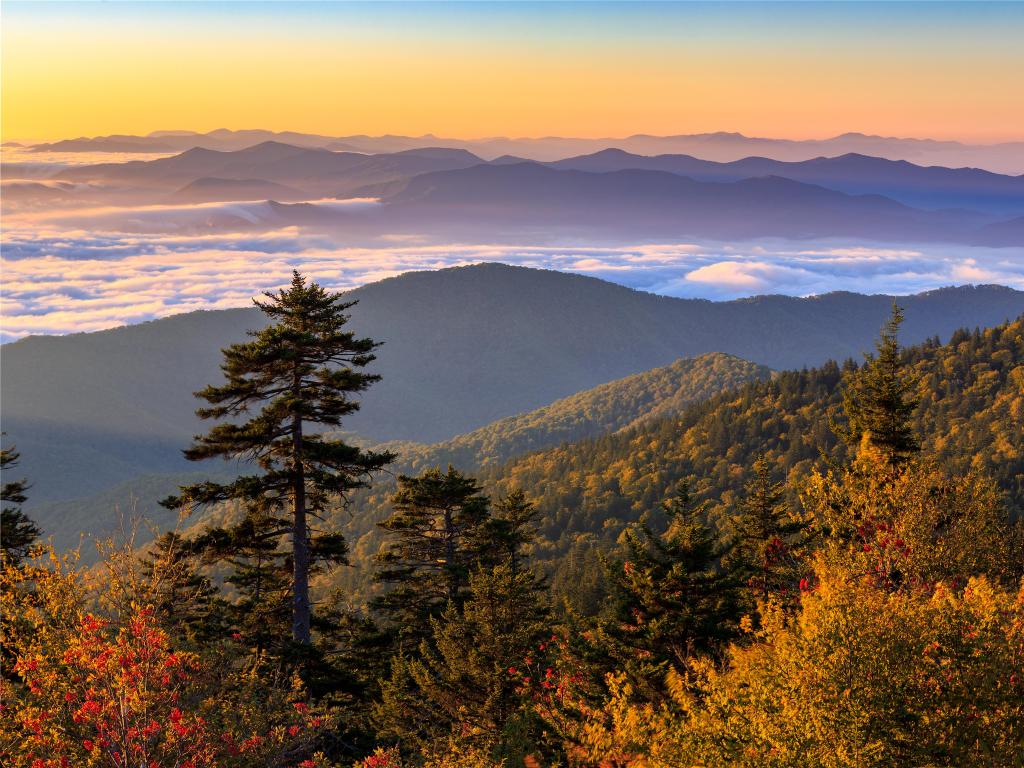
How to get there: Since it's such a long-haul drive, it'd be ideal to spread it across a week or two. The quickest and primarily very scenic route you can follow would begin by getting on I-10 East directly to Baton Rouge.
You'll switch to I-12 and follow it until Pearl River Wildlife Management Area. Then, you'll switch to I-59 North into Mississippi, passing by Bienville National Forest before you arrive in Alabama.
Here, you'll get to explore the national forests and other highlights like Little River Canyon National Preserve & De Soto State Park (and even a well-worth it detour to the famous Great Smoky Mountains National Park) as you witness the stunning Blue Ridge Mountain views as you'll get onto I-66 into Washington.
Our highlights: Washington DC has so much to see and do, starting with the Smithsonian Museums, encompassing nineteen free-access museums.
As the country's capital, Washington DC is also home to some iconic national monuments like the Lincoln Memorial, Washington Monument, the US Capitol, and more. Here you'll also find spacious parks and trails, the most popular of which are the Capital Crescent Trail and Rock Creek Park Trail.
What else is there to see while you're in Washington DC: Other nearby places to explore are Georgetown (here you'll encounter the Old Stone House and a plethora of local boutiques and eateries) and Mount Vernon (the historic estate of George Washington).
Other spots worth making time for, particularly popular with the locals, are Legendary U Street, Dumbarton Oaks, the beautiful Key Bridge Boathouse, and the US National Arboretum.
Our travel tips: You can make the road trip during any part of the year, although some months may be more fun. The winters can get harsh in DC, making it not an ideal time to make the trip, especially since it's such a long drive.
The spring and fall months are a favorite amongst tourists- the fall brings autumnal leaves and a magical atmosphere, while the spring climate is perfect for exploring the best of the city!
READ MORE - Road trip from Houston to Washington DC
5. Texas to New York: Road trip from Dallas to New York City
1,550 miles from Dallas (24 hours)
What sets this one apart: This extensive road trip from Texas to New York is dotted with stunning sights and buzzing cities, as well as must-visit destinations such as Nashville, Knoxville and the Shenandoah National Park.
This iconic route takes you from Dallas to New York, which is genuinely bound to shift for the better because of the hustle, bustle, and color of the town, and that too through several natural reserves, forests, and parks making the ultimate getaway.

How to get there: To get to New York City from Dallas, you'll begin on Interstate 30 towards Mt. Pleasant, crossing Little Rock (in Arkansas), Ouachita National Forest, and Nashville as you merge with I-40, arriving at Knoxville.
Then, you'll exit onto I-81 North, get a chance to explore Shenandoah National Park, and ultimately get onto I-78 East to arrive in NYC.
Our highlights: There's so much to do along the way and in New York City that any list would always be missing something. But to encapsulate a bit of everything, some bucket list items for a first-time NYC tourist would be Central Park, MET, the Statue of Liberty, and The Morgan Library & Museum.
Other spots that you can't miss are the Grand Central Terminal, Brooklyn Bridge, Washington Square Park, and more.
Since New York City is a city held together by its people, the locals have a different list of places they'd recommend, including Chinatown, The Cloisters Museum & Gardens, the High Line and the New York Public Library.
What else is there to see while you're in New York: Contrary to popular belief, there are so many more things to do and places to explore in New York besides NYC.
After your tour around the city, make time to explore the Hamptons, the Finger Lakes – a set of wineries, trails, and valleys in Upstate New York, Roosevelt Island, Ellis Island, The Hudson River Valley, and the Great Swamp National Wildlife Refuge.
If you'd like to learn more about other amazing things you can see in New York City, as well as where to stay, please check our detailed guide below:
READ MORE - Our Area-by-Area Guide to NYC
Our travel tips: The summer months are pretty warm and pretty popular with tourists – although you'll have to book the room well in advance, so it would be recommended to go during the spring or fall.
READ MORE - Road trip from Dallas to New York
6. Texas to New Mexico: Road trip from Austin to Santa Fe
700 miles from Austin (11 hours and 15 minutes)
What sets this one apart: This road trip will be unforgettable because you'll get to encounter various cultures – Spanish, Mexican, and the South, along with paying homage to the historic Native American culture via museums, galleries, and memorials.
This is a one-of-a-kind road route to follow because you'll get to explore the one-of-a-kind Marfa Lights in West Texas, which are these mysterious orb-like lights that appear in the sky in a variety of different colors.

How to get there: While you could follow a couple of routes to reach Santa Fe, the most straightforward path would be via US-84 West. You'll begin by taking Texas 1 Loop North onto US 183 N and driving through the heart of Texas before merging with I-20 W.
You'll enter New Mexico via US Route 285 North and ultimately via the unique Old Pecos Trail to get to Santa Fe.
Our highlights: There's so much to see and do in Santa Fe, starting with some must-do places like Santa Fe Plaza and Canyon Road, where you'll find endless art galleries, the Georgia O'Keeffe Museum, and more.
Try and make some time to watch a show at the Santa Fe Opera and tour the Palace of the Governors. Meow World (an immersive art experience), Santa Fe Railyard Park, and the Santa Fe Farmers Market are popular among the locals.
It'd be a shame to go to Santa Fe and not enjoy the Hot Springs, especially at a luxurious resort like the Ojo Caliente Mineral Resorts & Spa for a night!
What else is there to see while you're in New Mexico: While you're in New Mexico, there are several other places to visit, like the Bandelier National Monument – a renowned historical monument home to several Native American dwellings and petroglyphs.
You can also visit Taos Pueblo (a UNESCO World Heritage Site), and the Taos Ski Valley for a little adventure getaway. You can also take time to visit the Tent Rocks National Monument.
Our travel tips: Though possible to do year-round, the summer months might be too hot to explore the best of the wilderness along the route, and the hikes won't be as enjoyable when you're stopping to drink some water every five minutes.
In the winter, however, you may not be able to experience all parts of the national parks along the way, and some roads may also be subject to closure due to harsh weather conditions. The fall time is ideal, though you should make your travel bookings in advance!
READ MORE - Road trip from Austin to Santa Fe
7. Texas to Arizona: Road trip from Austin to Phoenix
1,310 miles from Austin (21 hours 30 minutes)
What sets this one apart: The road trip from Austin to Phoenix is bound to take you through some of the unique terrains the US offers – dry, golden deserts, rolling hills, lush green forests, snow-covered peaks, and even a white sand desert!
Phoenix is known for its immaculate weather, promising sunshine nearly all year round & offers several natural activities for you to immerse yourself in, so what better way to experience it than an exciting road trip leading you to it?
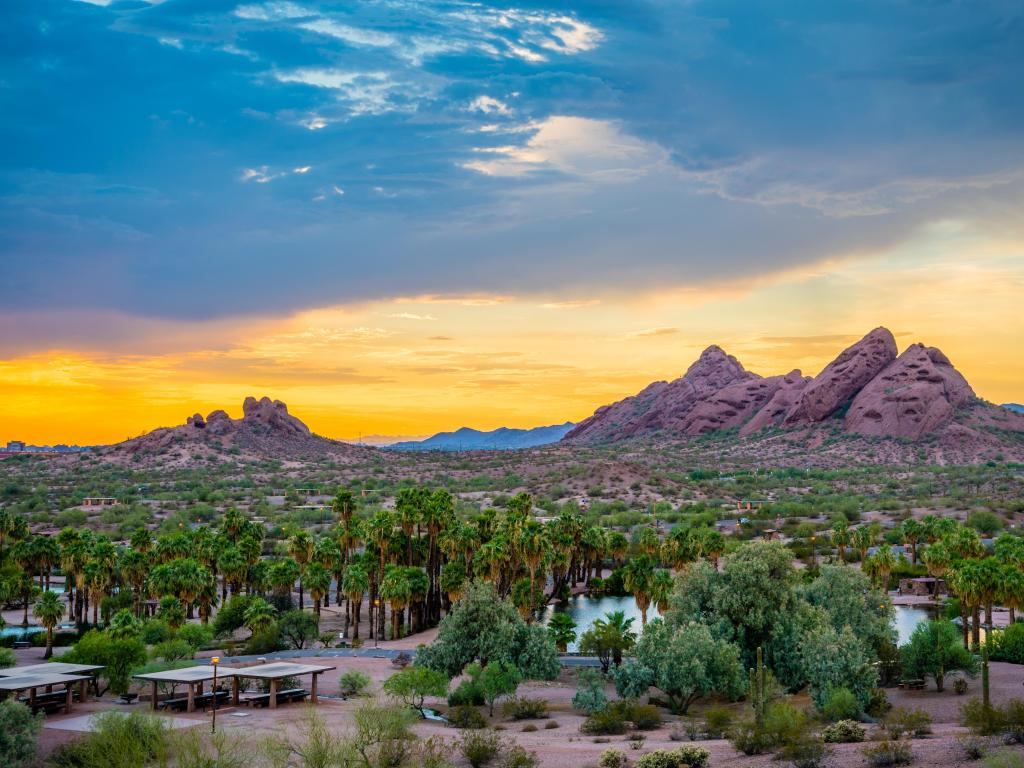
How to get there: While there are two routes you can follow to get to Phoenix, this route is the most convenient. You'll begin by calling on I-35 South towards San Antonio.
As you merge with US-90 West, you'll reach the Mexico-US border, where you can choose to detour to Big Bend National Park for a bit of an afternoon of sightseeing before you get on US-385.
Ultimately, you'll get back onto US-90 West and I-10 West, where you'll get to catch a glimpse of White Sands National Park before arriving at your destination.
Our highlights: Phoenix is full of excursions and activities to immerse yourself in. Some tourist favorites include Camelback Mountain, an excellent hiking spot, Taliesin West, Papago Park, Chase Field (especially for sports fans), and Old Town Scottsdale.
There are also a handful of funky museums to visit in Phoenix, namely The Heard Museum and The Musical Instrument Museum. Try and make time to tour the Desert Botanical Garden and spend a couple of hours among the galleries and boutiques at Roosevelt Row.
What else is there to see while you're in Arizona: Besides Phoenix, other cities you can explore during your time in Arizona are Prescott, Scottsdale, and Sedona, each located a short drive from the city.
If you're looking for a nature getaway, you can also spend time at the Organ Pipe Cactus National Park, Montezuma Castle National Monument, and Tonto Natural Bridge State Park.
While in Arizona, a visit to the Grand Canyon National Park is also a must.
Our travel tips: Much like most of these road trips, you can make this trip during any part of the year. However, spring is famous because the weather is pleasant, and most national park attractions open after a slow winter.
Additionally, the fall months bring a unique experience because the natural reserves and forests would be at their most colorful.
Do keep in mind that Phoenix is at its most popular during the end of February because of the Scottsdale Arabian Horse Show, so if that's something you're interested in, you know when's the best time to plan your road trip.
READ MORE - Road trip from Austin to Phoenix
8. Texas to Colorado: Road trip from Dallas to Denver
795 miles from Dallas (12 hours)
What sets this one apart: This half-day road trip is bound to be one of the most scenic drives you'll experience with the drive across Santa Fe Trail and the Million Dollar Highway while making your way to Dallas.
There are several national parks and outdoor activities along the way (Great Sand Dunes National Park, Mesa Verde National Park, Rocky Mountains National Park, etc.), which will be enjoyable to explore and adventure around while you drive along this 12-hour route.
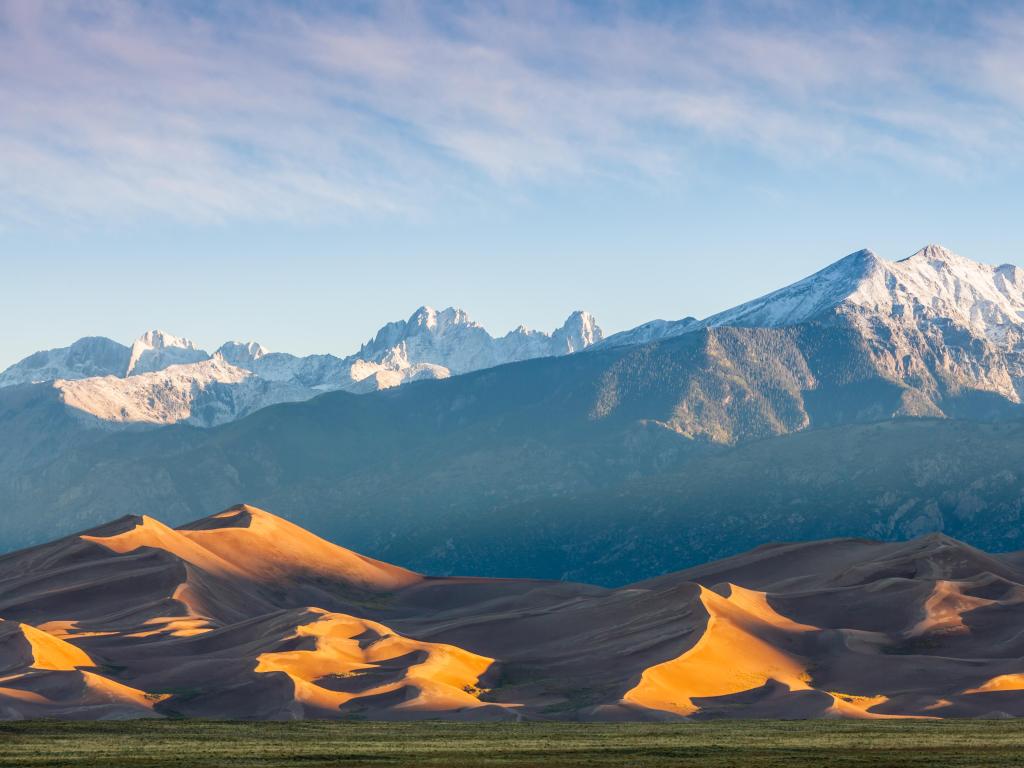
How to get there: There are two routes between Dallas and Denver; one through New Mexico and the other through Oklahoma and Kansas. The first route takes you through the Texas plains in the northwest via Texas 121 TEXpress. Then you'll exit onto US-287 North while Sonic Drive-In.
You'll then merge onto US-87 North passing by Rita Blanca National Grasslands to enter New Mexico for over a hundred miles. Ultimately, you'll merge onto I-25 North to join Colorado, where you'll encounter Gunnison National Forest, San Isabel National Forests, and more.
Our highlights: Denver has much to do and see; you will always have something planned. You must visit the Denver Art Museum, Denver Botanic Gardens and Larimer Square.
You can also take out time to venture around the Molly Brown House Museum, take a Brewery Tour, and watch the sunset at the Red Rocks State Park and Amphitheatre. Locals recommend visiting the Cherry Creek Trail, Coors Field, Union Station, and Colorado State Capitol.
What else is there to see while you're in Colorado: While in Colorado, you can take time to visit Rocky Mountain National Park, believed to be one of the best national parks in the country, and it is home to over 500 miles of hiking trails.
You can also book a weekend at Vail, a world-renowned ski resort, and visit Estes Park, Colorado Springs, Breckenridge, and Mt. Evans.
Our travel tips: The best time to go on a road trip from Dallas to Denver is ideally the spring and fall months since the temperature is perfect & you'll also get to go to some music festivals, live music events & Oktoberfest too.
Denver has a lot to offer during the winter, especially if you're looking to ski or spend time on other snow-related activities.
READ MORE - Road trip from Dallas to Denver
9. Texas to Nevada: Road trip from San Antonio to Las Vegas
1,280 miles from San Antonio (19 hours)
What sets this one apart: This route from San Antonio to Las Vegas has several National (and state) Parks that are only a slight detour away (Grand Canyon National Park, Joshua Tree National Park, Zion National Park), making it a great road trip for outdoor enthusiasts and hikers.
Las Vegas is truly one of the best entertainment cities to be in, so if you're looking for an adventurous trip that culminates in a relaxing but nightlife-filled destination – this is the trip to go on!
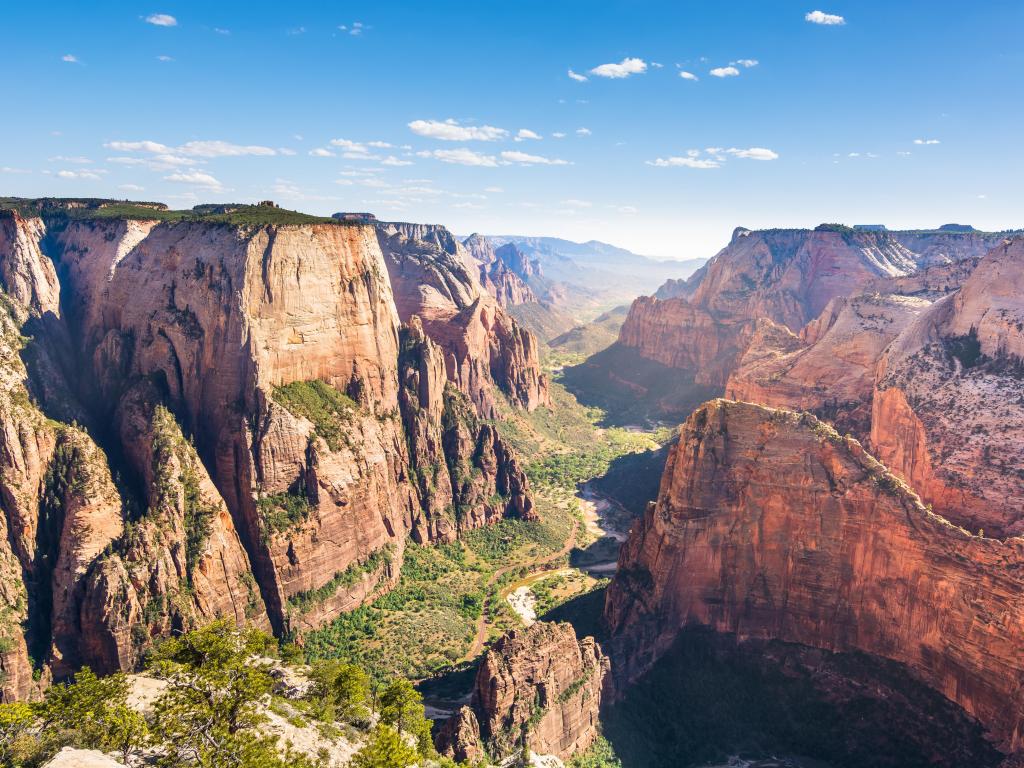
How to get there: You'll begin your journey via El Paso on I-10. After your visit to El Paso, where you'll have the chance to explore this one-of-a-kind melting-pot city. You'll head North towards Phoenix, getting an opportunity to explore Hoover Dam before arriving in Las Vegas.
Our highlights: A power-packed city, there's something to do at every corner in the city of sin! Bucket-list spots include the Strip, the four-mile-long road Vegas is known for, The High Roller (Ferris Wheel), Fremont Street Experience, and the Red Rock Canyon National Conservation Area.
Locals love the Springs preserve, a vast oasis home to trails, gardens, exhibits, a Container Park, and wacky museums like the Mob Museum and Pinball Hall of Fame.
What else is there to see while you're in Nevada: While in Nevada, there are many other places you can see, such as Valley of Fire State Park, Lake Mead National Recreation Area, and Great Basin National Park.
You can also make time for Lake Tahoe for a short nature escape or visit Reno, known famously as “The Biggest Little City in the World.” Another exciting spot to visit during this road trip would be the Extraterrestrial Highway , a remote highway in Southern Nevada known for its countless UFO sightings.
Our travel tips: Las Vegas is not ideal to visit in the summer because it gets hot and is perpetually packed with tourists. Making this trip during the winter months could be a good experience as the city wouldn't be too packed, and the weather remains lovely.
Plus, the National Finals Rodeo takes place in December if you're into that sort of thing! The springtime months are also a good option, and the scenery would be lovely along the way.
READ MORE - Road trip from San Antonio to Las Vegas
10. Texas to California: Road trip from Austin to San Francisco
1,940 miles from Austin (31 hours)
What sets this one apart: This is the second longest road trip on the list taking well over a whole day of non-stop driving, which you should ideally spread across a week or two to make the most of this across-the-country journey.
Since this is a cross-country road trip , you'll get to visit top US attractions like the Hoover Dam, Golden Gate Bridge, and the Grand Canyon.
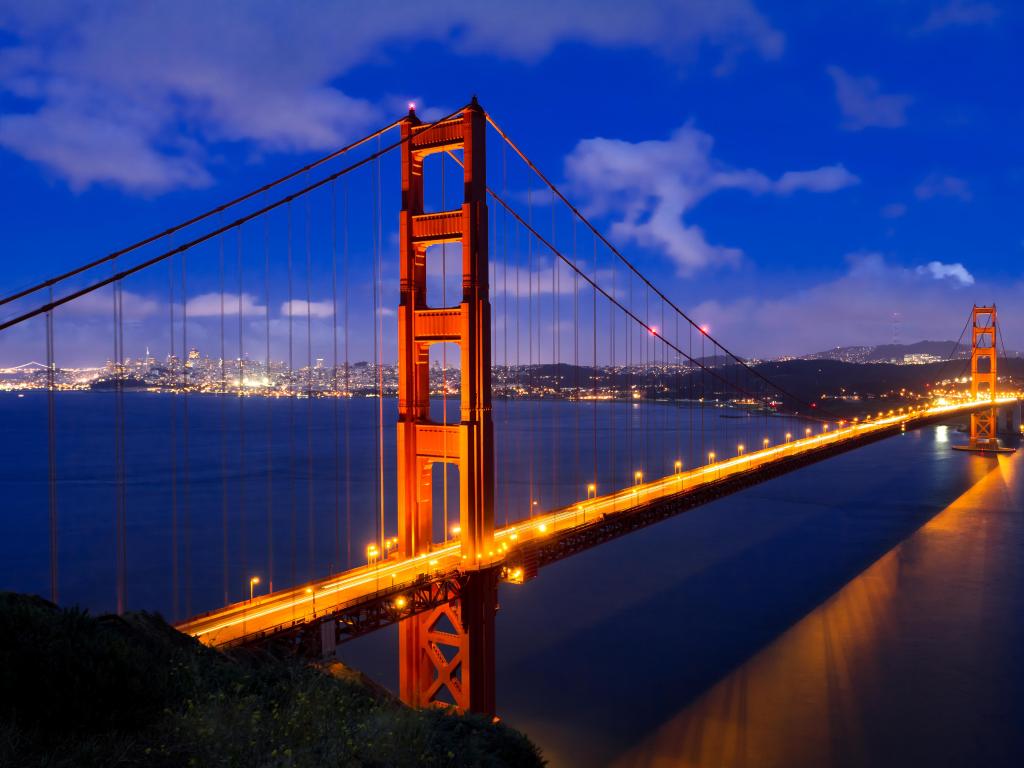
How to get there: Two routes can be followed between Austin and San Francisco, one that's primarily direct and the other that's bound to be more scenic but also adds six more hours on an already lengthy journey.
You'll begin by getting on US-290 and merge with I-10 West through Texas and, ultimately, New Mexico and into Arizona. You can explore the rugged terrains of Phoenix and stop over at the national and state parks if you're feeling adventurous and the weather permits.
You'll continue the same road to enter California and drive along the California mountains until exiting onto US-101 till Speckles, where you can detour onto Big Sur for a drive with a view and ultimately follow the west coast of the Bay to arrive in San Francisco.
Our highlights: When visiting San Francisco, places that you cannot miss out on are the Golden Gate Bridge, Alcatraz Island, Fisherman's Wharf, and San Francisco Cable Cars.
Some spots that locals swear by are Lands' End – known to have unobstructed views of the Golden Gate Bridge, The Mission District, The Ferry Building Marketplace, and the tranquil Japanese Tea Garden.
You can also spend some time in Haigh-Ashbury, a historic neighborhood near the city center.
What else is there to see while you're in California: There's no dearth of places to wander around in California, but some top hits include the Napa Valley, perfect for a weekend of relaxation and wine-tasting, Point Reyes National Seashore, promising stunning Pacific Ocean views with a lighthouse, trails.
You can also try taking out time for Lake Tahoe, Muir Woods National Monument, Monterey, and a short getaway to Santa Cruz.
Our travel tips: San Francisco can be a little dicey regarding weather, though mostly pleasant. The summer months are lovely, perfect for hiking and beach activities, but not too hot so you can't enjoy your time outdoors.
The spring and fall months are also great for this road trip because they're a little more budget-friendly, and you'll get a chance to participate in events like the Chinese New Year parade (early spring), Outside Lands Music Festival, and more.
READ MORE - Road trip from Austin to San Francisco
11. Texas to Washington: Road trip from Austin to Seattle
2,145 miles from Austin (33 hours)
What sets this one apart: The most extended trip on this list , you're bound to feel like a mega adventurer after you complete this feat. Taking you through national parks, historical monuments, and diverse landscapes, this road trip is bucket-list worthy!
Along the route, you'll encounter a plethora of national parks in these diverse settings – the deserts of the Southwest, the Rocky Mountains, red rocks, coastal beaches, and flowering valleys; honestly, what else could you want from a cross-country road trip?
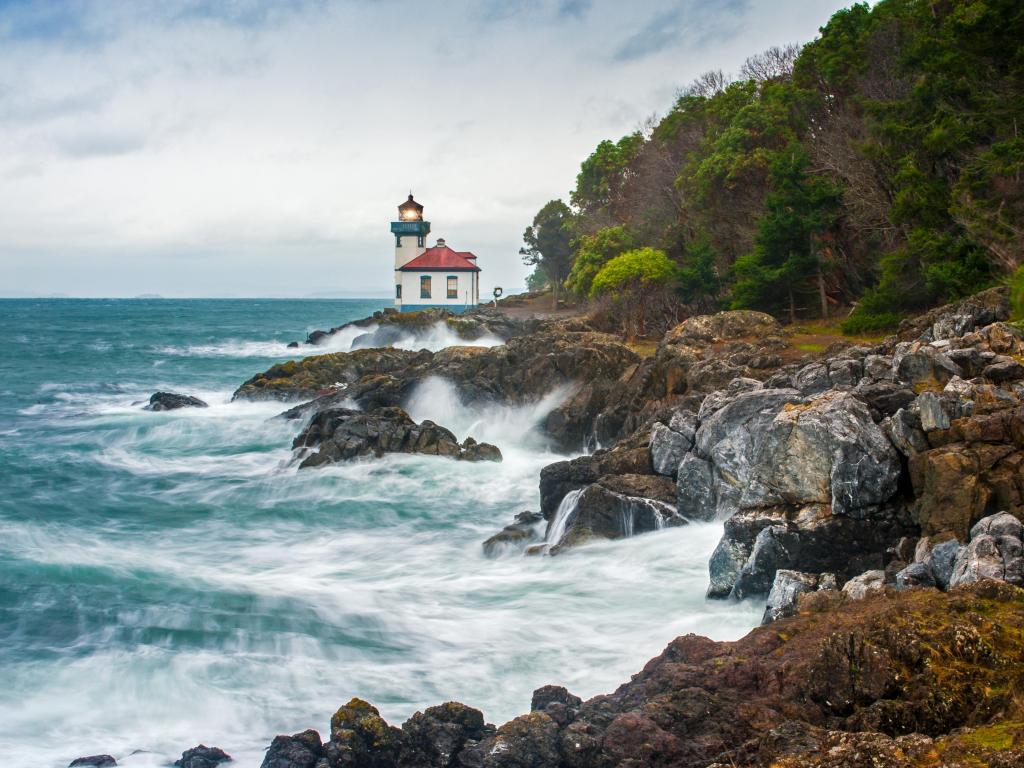
How to get there: While there are a handful of routes to get to Seattle from Austin, the shortest route will take you through the Utah Desert. You'll begin your trip by heading on Highway 71 and I-40 towards Albuquerque in New Mexico, after which you'll get on I-70 West towards Salt Lake City.
Ultimately, you'll get on Interstate 15 North in Spanish Fork, leading you through a handful of state and local routes into Seattle.
Our highlights: The places you cannot miss in Seattle include (but aren't limited to) Space Needle, Pike Place Market (a Seattle staple market, home to local artisans, vendors, etc.), Chihuly Garden and Glass Museum, and Museum of Pop Culture.
Some local gems you must take time for are Fremont Brewing, Discovery Park (promising views of Puget Sound and Beaches), Gas Works Park, and Elliot Bay Book Company.
What else is there to see while you're in Washington: Other places to explore around Seattle are Tacoma, a historically rich city with several museums, San Juan Islands and Mount Rainer National Park, home to a now-defunct volcano but with solid views nonetheless.
Our other favorite places to visit while in Washington are North Cascades National Park, and Snoqualmie Falls — a 270 feet tall waterfall with endless viewpoints and trails.
Our travel tips: Since the trip does involve taking the Pacific Coast Highway, making the trip in spring and fall would be ideal. The summer is a viable option, although the desert might be too hot to explore.
The Seattle International Film Festival happens in the summer, which might be worth visiting – especially if you're a film buff.
READ MORE - Road trip from Austin to Seattle
12. Texas to Illinois: Road trip from Dallas to Chicago
990 miles from Chicago (16 hours)
What sets this one apart: Though it's not the longest nor the most scenic drive, this route has many unique attractions along the way, like the Precious Moments Chapel and the World's Largest Catsup Bottle.
Along with these wacky attractions, you'll also get to experience some of the best food this part of the US has to offer, from scrumptious BBQ in Texas, specialty fried chicken in Missouri to deep-dish pizza in Chicago, making this road trip from Dallas to Chicago perfect for the foodie in you!
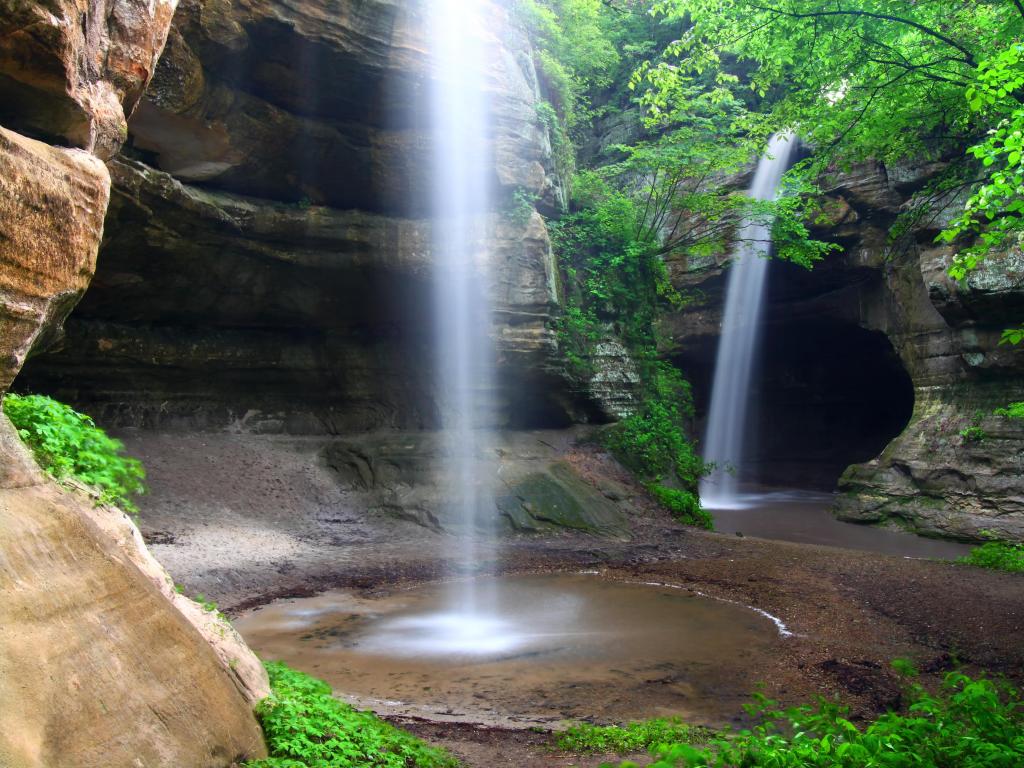
How to get there: There's a direct route through Memphis and a scenic route that'll add around two hours to your driving time. You'll begin your scenic drive on I-30 E, towards Arkansas, where you'll get to detour to state parks and the Hot Springs in the area.
You'll continue along I-30 until you arrive at Little Rock, taking US Route 167 and heading Northeast. Then, after passing by Pocahontas in Arkansas, you'll take US-115 and merge with US-21 towards St. Louis. Ultimately, you'll continue onto I-55 N heading straight to the windy city of Chicago.
Our highlights: Exploring Chicago is bound to be an enjoyable experience packed with vibrant culture and attractions around every corner.
Some popular tourist spots are The Art Institute of Chicago, Navy Pier, Willis Tower (famous for being the tallest building in the Western hemisphere), and Millennium Park, the infamous Bean of Chicago site.
What else is there to see while you're in Illinois: Other places to visit during your visit to Chicago are Starved Rock State Park, Galena (A beautiful historic town known for its 19th-century architecture), and The Great River Road.
Our travel tips: Much like most of the other trips on this list, this road trip, though possible during any time of year because of the overall pleasant weather, is likely to be the most exciting in the spring or fall – when the weather isn't too extreme.
Since there are several outdoor attractions to see along the way, making the trip when the trees are turning red and orange, especially when you take the hikes in Rocky Mountains National Park, is bound to be lovely – so book it in the fall if you can!
READ MORE - Road trip from Dallas to Chicago
Join our email list!
By joining our email list, you give LazyTrips permission to use your email for sending you newsletters, emails and updates including for marketing purposes. Your email will not be provided to third parties.
Related posts
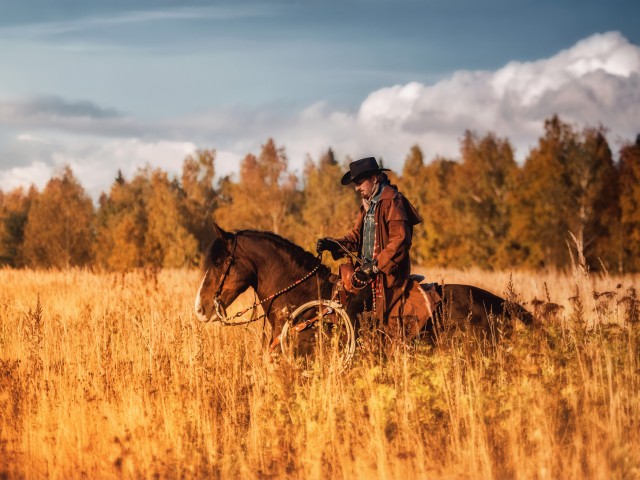
What happens to the elevation of Texas if you travel from Southeast to west Texas?
West Texas starts with high elevation in the mountains and basins region and slowly degrades to flat rolling plains in the North Central Region of East Texas.
The more west you go the drier the place will be the more east you go the more rainfall you get.
- Hope this helps if not ask me more and i will see what I can do!
Southeast Texas is at sea level, along the Gulf Coast. As you travel north and west, you are increasing in elevation to an average of around 1200 feet MSL.
How much should I feed my dog
28Garcia Joseph ∙
Anonymous ∙
The precipitation decreases, the elevation increases.
east has lower elevation
The elevation increases .
Add your answer:
What is the rule of the thumb and where does it come from?
The Texas Rule of Thumb is: The further you travel Northwest, the higher the elevation and lower the precipitation, the further you travel Southeast, the lower the elevation, and higher the precipitation.
What is Texas' elevation?
the texas elevation in the great plains is? help answer unknown
In which direction would you have to travel in Texas to go from a low elevation to a high elevation?
Guadalupe Peak at 8749 ft. Gulf of Mexico 0 ft.
When was Southeast Texas Mavericks created?
Southeast Texas Mavericks was created in 2006.
Name the gulf that Texas borders to the southeast?
name the gulf that texas borders in the southeast
How low was the elevation in the Texas?
The lowest elevation in Texas is sea level along the Gulf Coast.
Was Bristol Texas highest elevation?
Bristol, Texas' elevation is 505 feet (154 meters).
What is the elevation of magnolia Texas?
what is the elevation of magnolia, texas
What is the web address of the Art Museum Of Southeast Texas in Beaumont Texas?
The web address of the Art Museum Of Southeast Texas is: www.amset.org
Does Florida or Texas have higher land elevation?
Where in texas did the comanche live.
Southeast of Texas
What has higher elevation Davenport Iowa or Midland Texas?
Midland, Texas has higher elevation than Davenport, Iowa. The elevation in Davenport, Iowa is 580 feet above sea level. The elevation in Midland, Texas is 2782 feet above sea level.
Top Categories


A Complete Guide To The Best Hikes In West Texas
West Texas is often misunderstood in terms of what it offers to hikers. There is a misconception out there that Texas is all flat and boring, but a trip to hike any of these top west Texas trails will quickly prove that to be wrong!
West Texas is a diverse and harmonious blend of canyons, mountains, forests, rivers and even sand dunes! All these different environments create a fascinating landscape in which to experience some of the best hikes in west Texas!
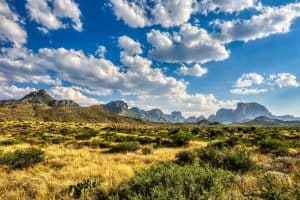
Disclaimer: Some links in this article are affiliate links, which means that if you purchase through them I receive a small commission, at no extra cost to you. This helps cover the cost of running this blog. Thanks for your support!
West Texas Hiking Trails
1. the guadalupe peak trail, guadalupe mountains np.
- Length: 8.4 miles roundtrip
- Elevation: 8,751 feet
- Elevation Gain: 2,952 feet
- Rating: Difficult
- Estimated Time to Complete: 6-7 hours
- Best Time of Year to Hike: Late Fall – Early Spring
- Fees: $10 per person to enter Guadalupe Mountains National Park
- Parking: there is plenty of parking at the trailhead for the Guadalupe Peak Trail
- Facilities: there are bathroom and water refill stations located at the trailhead
- Pets: pets are not allowed on the Guadalupe Peak Trail
The king of all west Texas trails is the one that is literally top of the list, the Guadalupe Peak Trail. Guadalupe Peak is the state high point of Texas, and the most popular trail in Guadalupe Mountains National Park!
Guadalupe Mountains is one of the best National Parks of the southwest. Click here to discover the rest!
Not only can hiking this trail make you the tallest thing in Texas for a day, but it also will expose you to the fascinating ecosystems that exist in this park! As you traverse the switchbacks up from the desert floor to the mountain peak on this trail, expect to see high desert shrubbery, tall Ponderosa pine forests, and craggy rock summits.
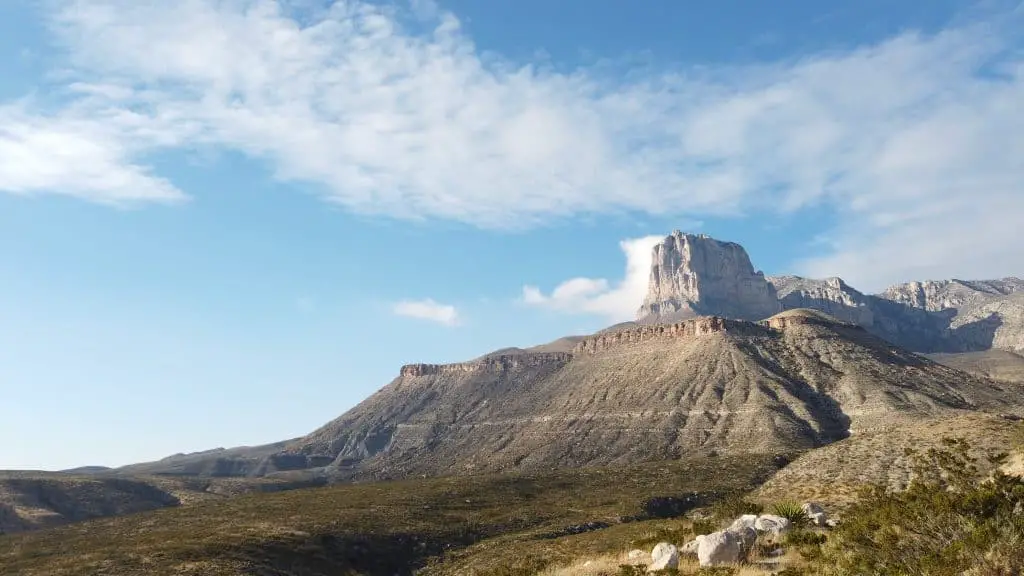
2. The Lighthouse Trail, Palo Duro SP
- Length: 6 miles roundtrip
- Elevation Gain: 521 feet
- Rating: Moderate
- Estimated Time to Complete: 2.5 hours
- Fees: $8 per person (13 and under free)
- Parking: there is plenty of parking at the trailhead
- Facilities: there are no bathrooms at the trailhead
- Pets: leashed pets are allowed on the trail
The Lighthouse Trail is the most cherished and beloved hike in Palo Duro Canyon State Park, and for good reason. The hike up to this fascinating natural landmark provides visitors a chance to hike in the 2nd largest canyon in the United States, second only to the Grand Canyon in Arizona!
The expansive red rock plateau at the base of the Lighthouse makes for a perfect photo stop and a break to soak in the striking panoramic views!
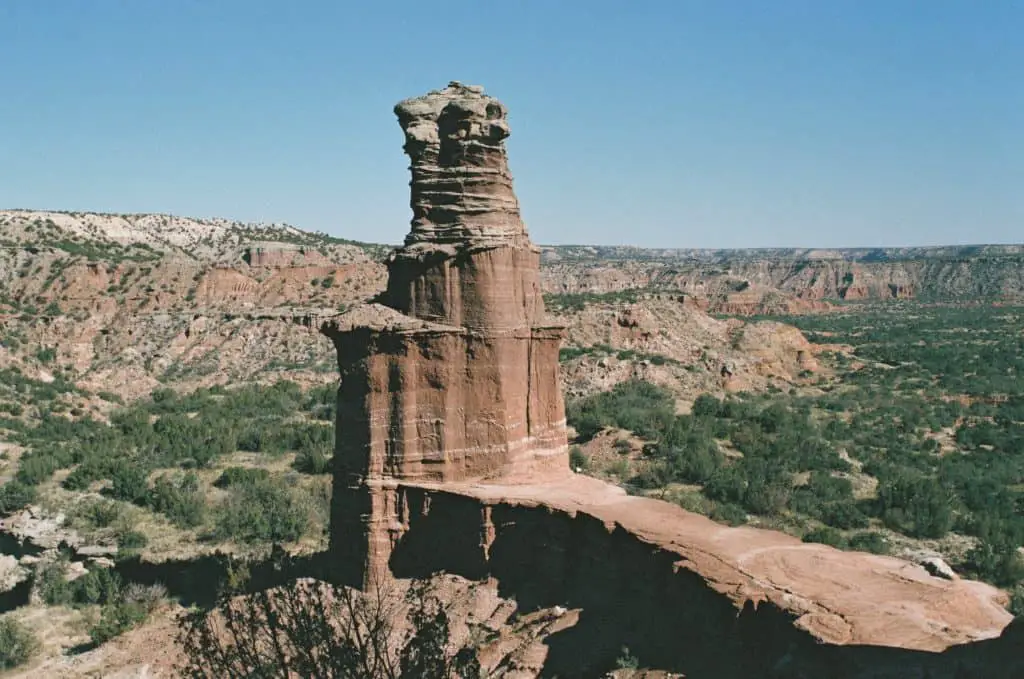
3. The El Paso Tin Mines Trail, Franklin Mountains SP
- Length: 6.6 miles roundtrip
- Elevation Gain: 1,023 feet
- Best Time of Year to Visit: Late Fall – Early Spring
- Fees: there are no fees to hike the El Paso Tin Mines Trail
- Parking: there is parking at the trailhead
- Facilities: there are bathrooms located near the trailhead
- Pets: leashed pets are allowed on the El Paso Tin Mines Trail
If you are looking for a classic hike in some of the best mountains in Texas, with a twist of quirkiness and mystique, then the El Paso Tin Mines Trail definitely belongs on your must hike list!
Located in the rugged Franklin Mountains range in Franklin Mountains State Park, this trail’s biggest claim to fame is that it is a hike to an abandoned tin mine, straight out of an old western film! In fact, it is the only tin mine of its kind in the United States, literally making this a one of a kind hike not only in west Texas, but in the entire country.
To top it off, you can actually go into the abandoned mine to explore, so bring along a flashlight for this hike so you can properly witness the interior walls of this old mine, glittering with specks of minerals!
- The Best 14 day Southwest Road Trip
- The Most Beautiful National Parks on the West Coast
- Top Rated Scenic Drives in the US
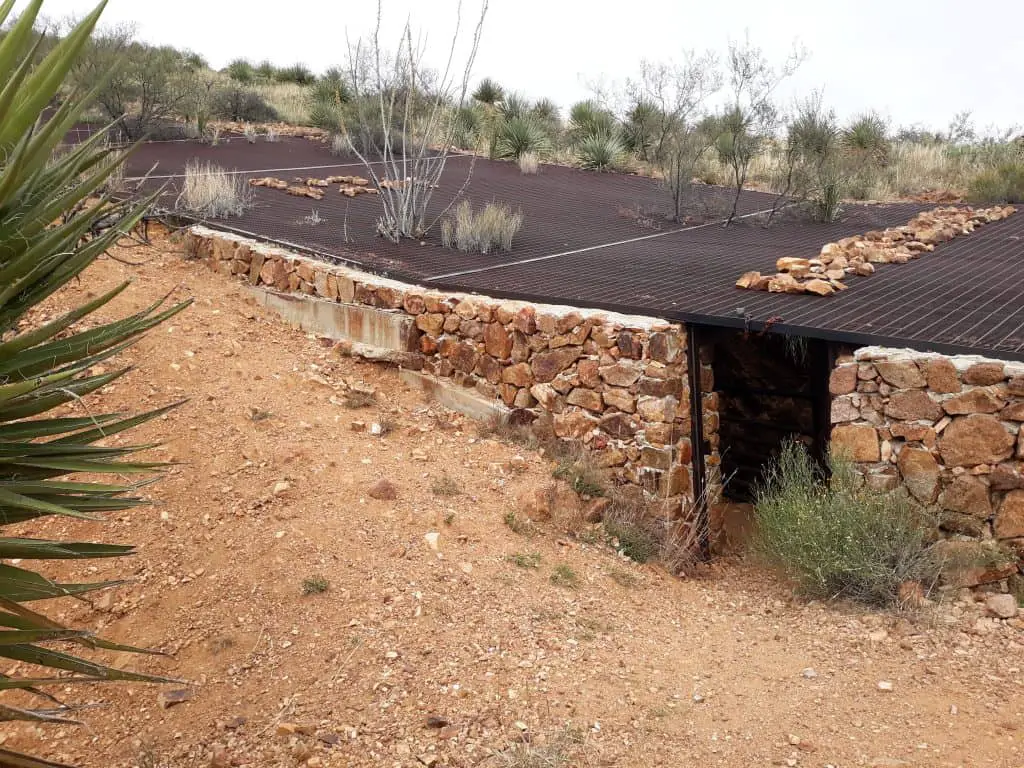
4. The Santa Elena Canyon Trail, Big Bend NP
- Length: 1.7 miles roundtrip
- Elevation Gain: 610 feet
- Estimated Time to Complete: 45 minutes
- Fees: $30 per vehicle to enter Big Bend National Park
- Facilities: there are bathroom facilities at the trailhead
- Pets: pets are not allowed on the Santa Elena Canyon Trail
Big Bend National Park is home to several epic hikes on this list, starting with one of the most recognisable canyons in the southwest.
The Santa Elena Canyon Trail combines impressive canyon panoramas with majestic river views! This short, easy, and family friendly trail allows visitors a chance to see one of the major shapers of west Texas geology, the mighty Rio Grande River, from both above and below!
From the parking lot, it is a short jaunt to the shoreline of the Rio Grande River, where you can can soak in the towering canyon mouth engulfing this waterway, or choose to continue on and up the trail as it crosses the Terlingua Creek, gains in elevation, and reaches a viewpoint higher up on the canyon wall.
From this vantage point, you can look down on the Rio Grande River, and maybe even spot some kayakers below, venturing into Santa Elena Canyon for a boating excursion!
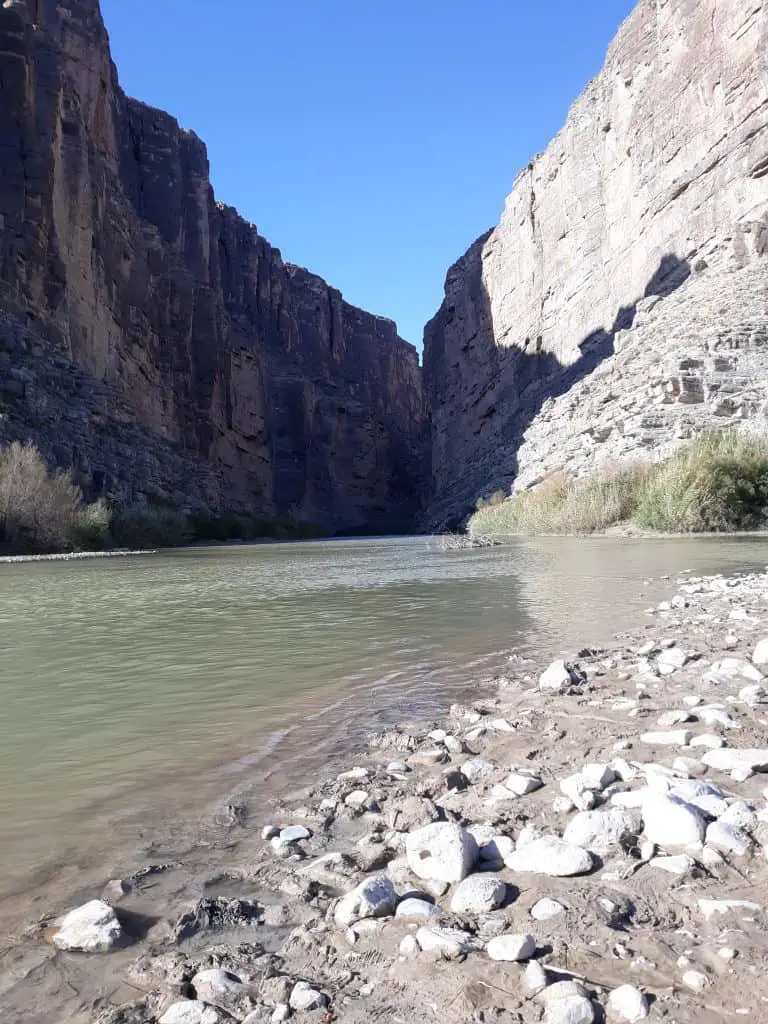
5. The Lost Mine Trail, Big Bend NP
- Length: 4.8 miles roundtrip
- Elevation Gain: 1,131 feet
- Rating: Hard
- Estimated Time to Complete: 2 hours
- Parking: there is limited parking at the trailhead, so arrive early!
- Pets: pets are not allowed on the Lost Mine Trail
In stark contrast to the previous canyon hike, the Lost Mine Trail in Big Bend National Park takes hikers to some of the loftiest heights of this park! It is the perfect trio of short day hikes, just enough challenge, and breathtaking summit views!
From the Lost Mine summit, you can see miles over the horizon, taking in views of Big Bend National Park from every angle, including the Casa Grande formation nearby!
Like many hikes in west Texas, this hike is best enjoyed away from the hot summer months. The cooler temperatures of the region during Fall make Big Bend a great National Park to visit in October .
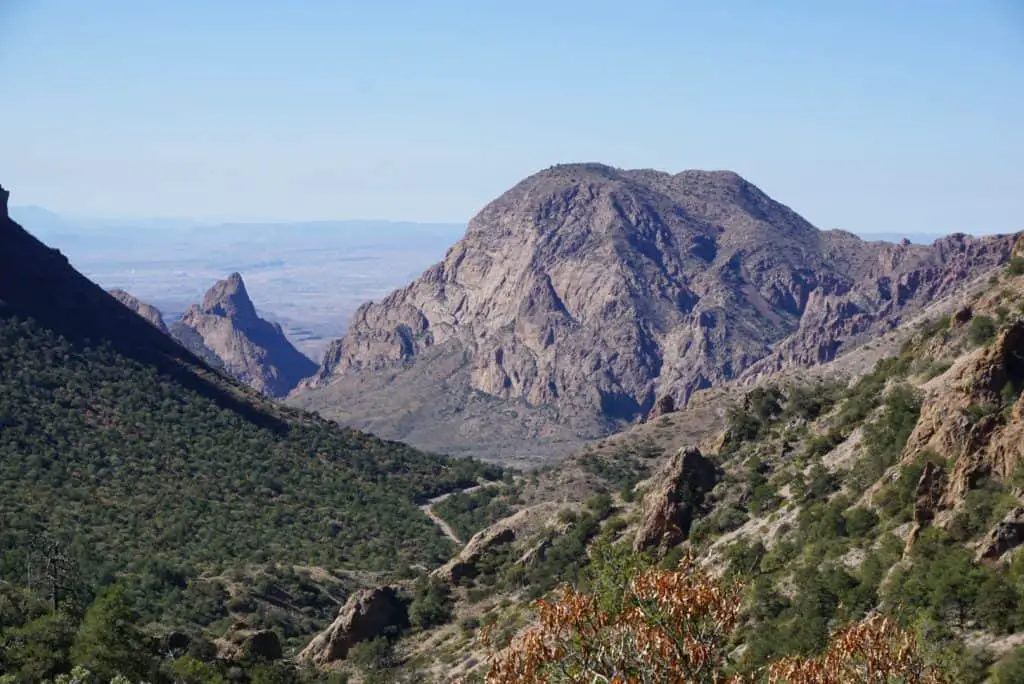
6. The Window Trail, Big Bend NP
- Length: 5.2 miles roundtrip
- Elevation Gain: 948 feet
- Parking: there is parking available at the trailhead
- Pets: pets are not allowed on the Window Trail
The Window Trail in Big Bend National Park gets its name from its namesake, a naturally carved window formation at the termination of its slot canyon hike.
This hike is unique as it starts out in the high desert shrubbery amidst the jagged Chisos Mountains, follows Oak Creek as the trail descends further into the canyon, and finally terminates as the canyon walls above close in to create natural rock staircases, pools, and the Window.
From this natural opening in the canyon wall, visitors can witness the sheer drop-off overlooking the vastness of Big Bend National Park in the distance!
You might also like : Discover the best national parks to visit during winter in this handy guide!
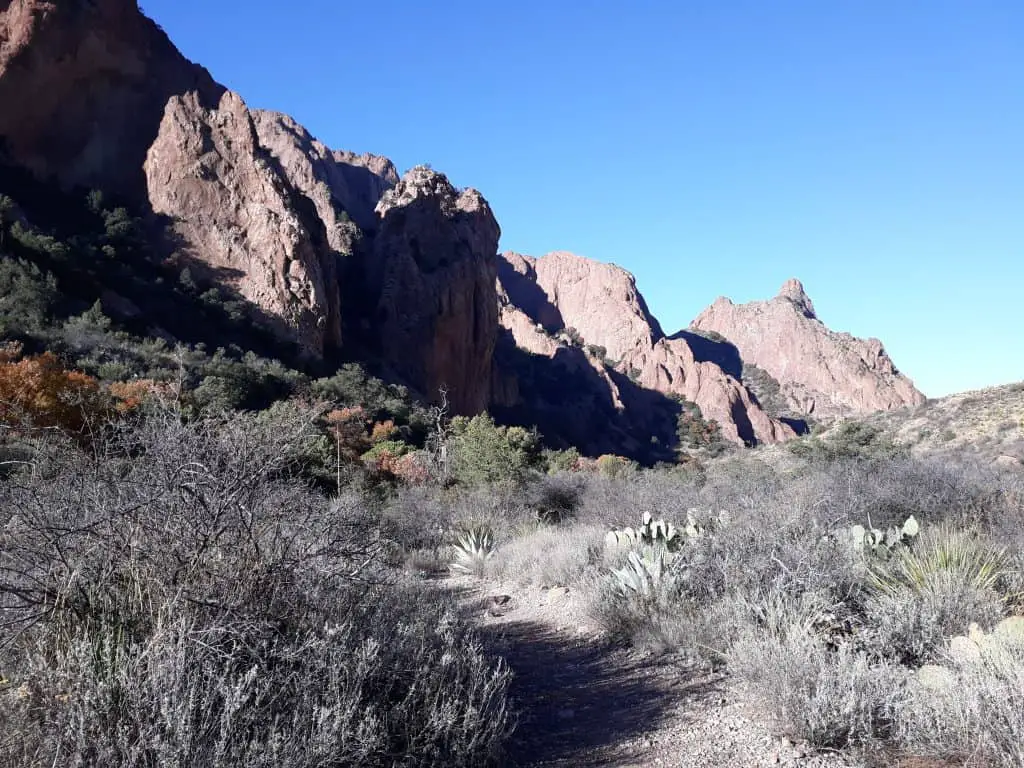
7. The Rio Grande Trail, Seminole Canyon SP
- Length: 7.6 miles roundtrip
- Elevation Gain: 301 feet
- Fees: $4 a person (13 and under free)
- Parking: there is plenty of parking located at the trailhead
- Pets: leashed pets are allowed on the Rio Grande Trail
While Santa Elena Canyon in Big Bend National Park gets most of the attention for its eye-catching views of the Rio Grande River, there is actually another hike in another park that offers just as impressive views.
In a secluded nook of west Texas, t he Rio Grande Trail is located in Seminole Canyon State Park and Historic Site.
This trail starts off traversing the surrounding desert initially, before opening up to a surprisingly dizzying view of the Rio Grande River below, as it parallels along the top of the rim of this canyon. Not only can you hike along the top of this deep river chasm, but there are other surprises in store here! Prehistoric rock art can also be explored while hiking here, in locations such as Panther Cave.
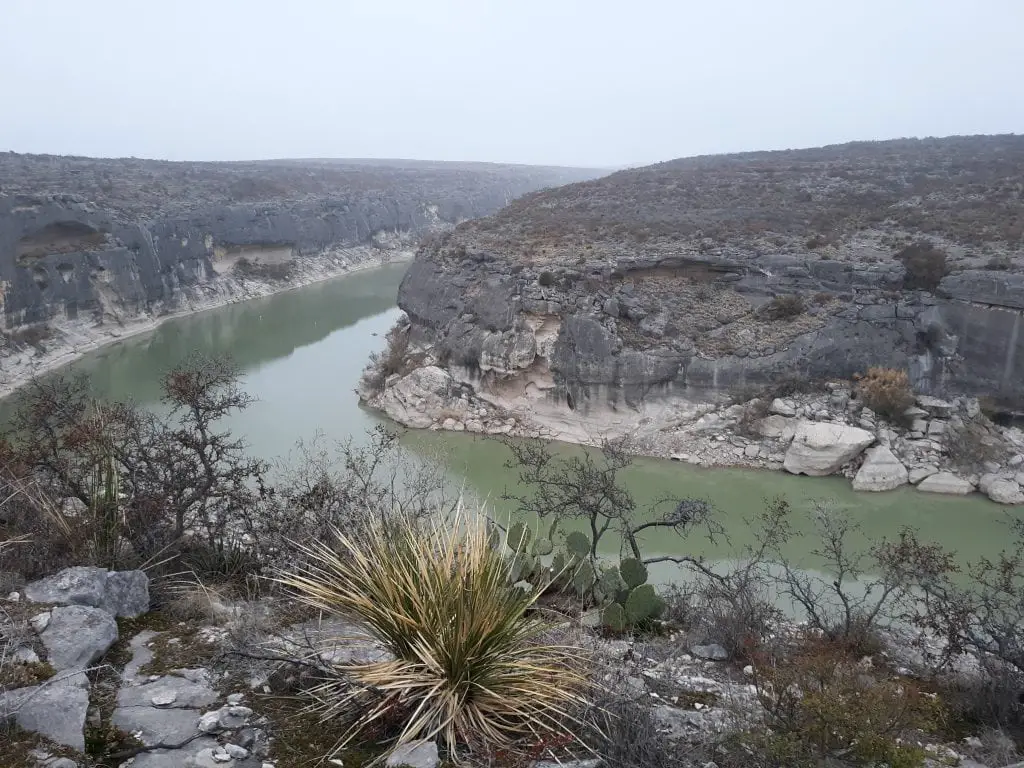
8. Eagle Point Trail, Caprock Canyon SP
- Length: 4.3 miles roundtrip
- Elevation Gain: 449 feet
- Rating: Easy
- Estimated Time to Complete: 1.5 hours
- Fees: $5 per person (13 and under free)
- Parking: there is limited parking at the trailhead
- Pets: leashed pets are allowed on the Eagle Point Trail
While Big Bend National Park and Palo Duro Canyon may get most of the attention for their canyons in west Texas, there is another underdog that is a favourite among locals and out-of-towners alike! The humble Caprock Canyon State Park is home to an intriguing hike through its own resident canyon, the Eagle Point Trail.
A few of the reasons that this trail is beloved by visitors is that you can explore fascinating geology along its path. From shimmering gypsum deposits that dot the trail, to the natural “bridge”, to the underground cave you can meander through and explore! Top all this off with epic red rock views of canyon walls, cliffs, and valleys, and even the chance to possibly spot a resident bison on your trek!
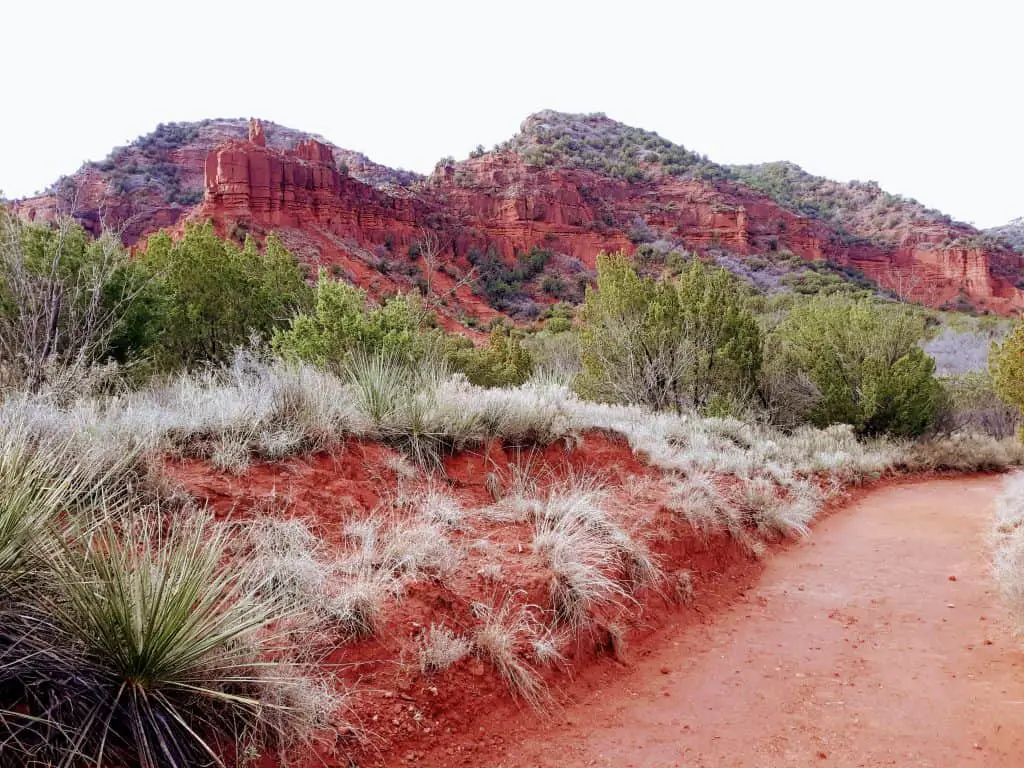
Kristen Czudak is the author and adventurer behind Yonderlust Ramblings . If you are looking for a different kind of vacation, active travel is the answer! Discover just how far your own two feet can take you!
Louise is a Mountain Leader and Snowboard Instructor from South Wales. As a former Adventure Tour Leader she has spent the last 15 years travelling Asia, Africa and the Americas. Louise is a published photographer and is currently based in the UK.
Recent Posts
The Best eFoiling Destinations For Beginners
Imagine gliding effortlessly over the water, powered by the wind and waves, but with a futuristic twist. Welcome to the world of eFoiling - a dynamic blend of traditional water sports and...
A Guide To Visiting Rhossili Bay
Rhossili Bay and Worm's Head are two of the most popular and beautiful natural attractions in South Wales. These stunning destinations offer breathtaking views of the Welsh coastline and are a...
Watch CBS News
Solar eclipse maps show 2024 totality path, peak times and how much of the eclipse people could see across the U.S.
By Aliza Chasan
Updated on: April 9, 2024 / 5:00 AM EDT / CBS News
A total solar eclipse crossed North America Monday with parts of 15 U.S. states within the path of totality. Maps show where and when astronomy fans could see the big event as skies darkened in the middle of the day Monday, April 8.
The total eclipse first appeared along Mexico's Pacific Coast at around 11:07 a.m. PDT, then traveled across a swath of the U.S., from Texas to Maine, and into Canada.
About 31.6 million people live in the path of totality , the area where the moon fully blocked out the sun , according to NASA. The path ranged between 108 and 122 miles wide. An additional 150 million people live within 200 miles of the path of totality.
Solar eclipse path of totality map for 2024

The total solar eclipse started over the Pacific Ocean, and the first location in continental North America that experienced totality was Mexico's Pacific Coast, around 11:07 a.m. PDT, according to NASA. From there, the path continued into Texas, crossing more than a dozen states before the eclipse enters Canada in southern Ontario. The eclipse exited continental North America at around 5:16 p.m. NDT from Newfoundland, Canada.
The path of totality included portions of the following states:
- Pennsylvania
- New Hampshire
Small parts of Tennessee and Michigan also experienced the total solar eclipse.
Several major cities across the U.S. were included in the eclipse's path of totality, while many others saw a partial eclipse. These were some of the best major cities for eclipse viewing — though the weather was a factor :
- San Antonio, Texas (partially under the path)
- Austin, Texas
- Waco, Texas
- Dallas, Texas
- Little Rock, Arkansas
- Indianapolis, Indiana
- Dayton, Ohio
- Cleveland, Ohio
- Buffalo, New York
- Rochester, New York
- Syracuse, New York
- Burlington, Vermont
Map of when the solar eclipse reached totality across its path
The eclipse began in the U.S. as a partial eclipse beginning at 12:06 p.m. CDT near Eagle Pass, Texas, before progressing to totality by about 1:27 p.m. CDT and then moving along its path to the northeast over the following few hours.
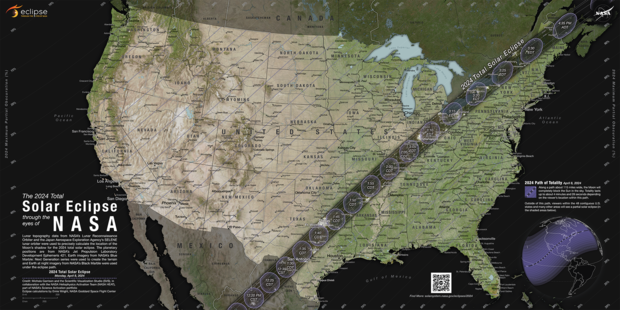
NASA shared times for several cities in the path of totality across the U.S. People could have also checked their ZIP code on NASA's map to see when the eclipse was to reach them if they were on, or near, the path of totality — or if they saw a partial eclipse instead.
How much of the eclipse did people see if they live outside the totality path?
While the April 8 eclipse covered a wide swath of the U.S., outside the path of totality observers may have spotted a partial eclipse, where the moon covers some, but not all, of the sun, according to NASA. The closer they were to the path of totality, the larger the portion of the sun that was hidden.
NASA allowed viewers to input a ZIP code and see how much of the sun was to be covered in their locations.
Could there be cloud cover be during the solar eclipse?
Some areas along the path of totality had a higher likelihood of cloud cover that could interfere with viewing the eclipse. Here is a map showing the historical trends in cloud cover this time of year.
You could have checked the latest forecast for your location with our partners at The Weather Channel .

Where did the solar eclipse reach totality for the longest?
Eclipse viewers near Torreón, Mexico, got to experience totality for the longest. Totality there lasted 4 minutes, 28 seconds, according to NASA.
Most places along the centerline of the path of totality saw a totality duration of between 3.5 and 4 minutes, according to NASA. Some places in the U.S. came close to the maximum; Kerrville, Texas, had a totality duration of 4 minutes, 24 seconds.
What is the path of totality for the 2044 solar eclipse?
The next total solar eclipse that will be visible from the contiguous U.S. will be on Aug. 23, 2044.
Astronomy fans in the U.S. will have far fewer opportunities to see the 2044 eclipse they had on April 8. NASA has not yet made maps available for the 2044 eclipse but, according to The Planetary Society , the path of totality will only touch three states.
The 2024 eclipse will start in Greenland, pass over Canada and end as the sun sets in Montana, North Dakota and South Dakota, according to the Planetary Society.

Aliza Chasan is a digital producer at 60 Minutes and CBSNews.com. She has previously written for outlets including PIX11 News, The New York Daily News, Inside Edition and DNAinfo. Aliza covers trending news, often focusing on crime and politics.
More from CBS News

Object that crashed through Florida home's roof was from space station

911 outages reported in 4 states overnight

Governors decry UAW push to unionize car factories in Southern states
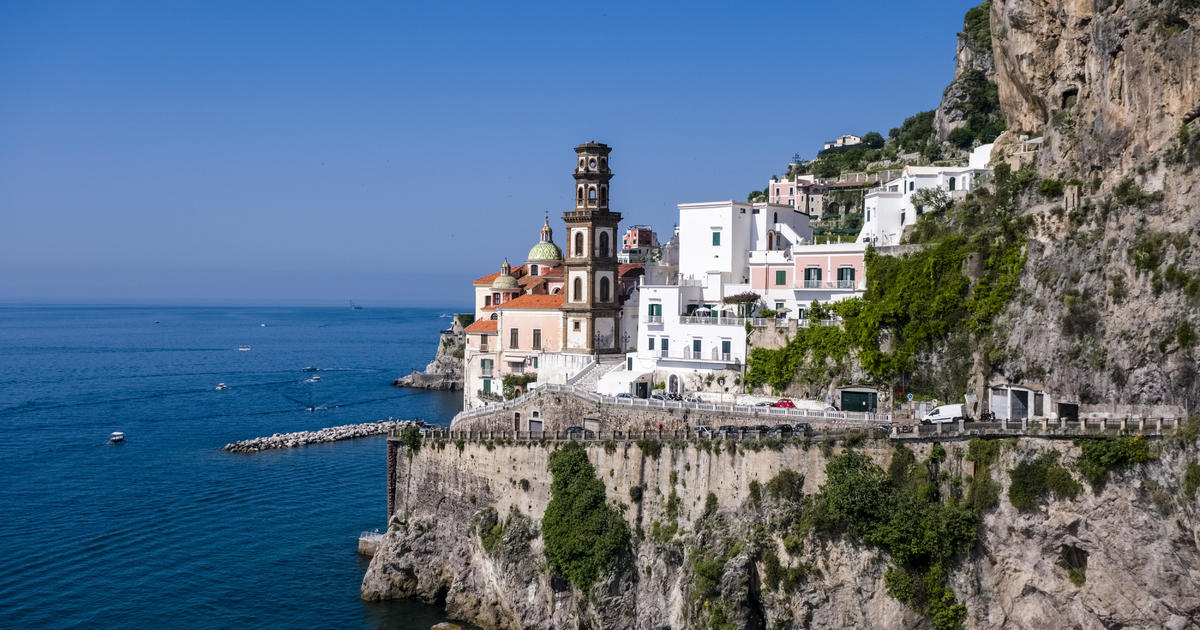
Netflix's "Ripley" spurs surge in bookings to Atrani area in Italy, Airbnb says
Today's total solar eclipse: When it will be visible in Texas and when the next one is

Texans are preparing for the total solar eclipse that will be visible across the Lone Star State on Monday, April 8.
Dallas and San Antonio will plunge into darkness midday for the full total solar eclipse experience. However, parts of West Texas outside the path of totality can still use eclipse glasses to see the moon pass in front of the sun.
The path of totality is the predicted path of the eclipse.
El Paso is not in the path of totality , but viewers here will be able to see a partial eclipse starting at 11:09 a.m. and peaking at 12:25 p.m.
Here are the top things to know about the 2024 total solar eclipse.
What kind of eclipse is on April 8?
On Monday, April 8, parts of Mexico, the United States and Canada will witness a total solar eclipse, which means the moon will completely cover the sun, making it go dark.
Here's what to know about the three types of solar eclipses .
What time is the solar eclipse on Monday?
That depends on where you are. In Texas, viewers will be able to see the eclipse beginning at 11:09 a.m. MT and watch the peak at 12:25 p.m. MT The eclipse ends at 1:44 p.m. MT.
Here's more about what time the eclipse will happen.
More: What time is the solar eclipse in West Texas? Find out with ZIP code
Where to find solar eclipse glasses
El Paso Community College Northwest Campus will have free eclipse glasses while supplies last.
Eclipse glasses will be provided to attendees of the La Perla at The Plaza Hotel Pioneer Park eclipse viewing party from 11 a.m. to 2 p.m. MT Monday.
You can get free glasses while they last at Sonic Drive-In.
More: Here's the total solar eclipse weather forecast in El Paso
How dark does it get in a total solar eclipse?
During a total solar eclipse, the sky can darken significantly, resembling twilight or even dusk, depending on factors such as atmospheric conditions, the duration of totality and the observer's location. In the path of totality, where the moon completely obscures the sun, the sky can become quite dark, revealing stars and planets that are normally hidden by the sun's glare.
What is the path of totality?
The 2024 total solar eclipse will traverse a path northeast across parts of Mexico, the United States and Canada.
In Mexico, the path of totality includes Sinaloa, Durango, Chihuahua, Coahuila and Nayarit.
In the United States, states such as Texas, Oklahoma, Arkansas, Missouri, Tennessee, Kentucky, Illinois, Indiana, Ohio, Pennsylvania, New York, Vermont, New Hampshire, Michigan, and Maine will experience totality.
In Canada, the eclipse path includes Ontario, Quebec, New Brunswick, Nova Scotia, Prince Edward Island, and Cape Breton.
For the full list check out where will the solar eclipse be visible and how to watch in El Paso.
When is the next solar eclipse?
North America won't experience totality again until 2033, with only Alaska getting the view. Then, in 2044, the totality will be confined to Western Canada, Montana, and North Dakota.
After the 2024 eclipse, there won't be another in the Texas region until 2317, according to the National Weather Service.
When was the last solar eclipse?
The last total solar eclipse the United States experienced was in 2017. It was dubbed "The Great American Eclipse" because the last time the United States experienced a path of totality before that was in 1918.
The most recent total solar eclipse within North or Central Texas was in 1878.
The Arizona Republic contributed to this report.
Morning Rundown: Iranian media downplays impact of Israel's apparent strike, multi-state 911 outage raises alarm, and Taylor Swift drops a secret double album
Your last-minute guide to Monday's total solar eclipse

A total solar eclipse will cross North America on Monday , offering millions a rare opportunity to see afternoon skies temporarily darken as the moon blocks the face of the sun.
Tune into NBC News NOW as Lester Holt hosts a two-hour special at 2 p.m. ET Monday from Indianapolis Motor Speedway.
The eclipse's path fortuitously cuts across Mexico, 15 U.S. states and a small part of eastern Canada. In all other states in the continental U.S., viewers will be treated to a partial solar eclipse, with the moon appearing to take a bite out of the sun and obscuring part of its light.
Here’s everything you need to know about the rare celestial event.
What is a solar eclipse?
Solar eclipses occur when the sun, moon and Earth align. The moon passes between Earth and sun, temporarily blocking the sun’s light and casting a shadow on Earth.
A total solar eclipse is when the moon fully obscures the sun, whereas a partial solar eclipse means it blocks just a portion of the sun’s face.
Solar eclipses occur only with the new moon. Because the moon’s orbit around Earth is tilted, the three bodies don’t always line up in a way that creates an eclipse.
“Imagine if the moon’s orbit were in the plane of Earth’s orbit around the sun — if that were the case, then every new moon, you’d have a total solar eclipse and every full moon, you’d have a lunar eclipse,” Neil DeGrasse Tyson, director of the Hayden Planetarium at the American Museum of Natural History, told NBC News. “So, because things don’t always align, it lends to the rarity of the event and the specialness of the event.”
Where and when will the eclipse be visible?
This year’s eclipse will follow a slightly wider path over more populated areas of the continental U.S. than other total solar eclipses have in the recent past.
NASA estimates that 31.6 million people live within what’s known as the path of totality, where the total solar eclipse will be visible. An additional 150 million people live within 200 miles of the path, according to the agency.
The path travels through Texas, Oklahoma, Arkansas, Missouri, Illinois, Kentucky, Indiana, Ohio, Pennsylvania, New York, Vermont, New Hampshire and Maine. Tiny parts of Michigan and Tennessee will also be able to witness totality if conditions are clear.
After the eclipse crosses into Canada, it will pass over southern Ontario, Quebec, New Brunswick, Prince Edward Island and Cape Breton, at the eastern end of Nova Scotia.
Those outside the path of totality can still take part in the astronomical event by viewing a partial solar eclipse — visible throughout all 48 states of the contiguous U.S. — or a NASA livestream.
The timing, including how long totality lasts, depends on the location, but some spots will see the moon fully cover the sun for up to 4 minutes and 28 seconds.
Below is a list of timings for some cities along the path of totality, as provided by NASA . A number of other resources, including NationalEclipse.com and TimeandDate.com , can also help people plan.
- Dallas: Partial eclipse begins at 12:23 p.m. CT and totality at 1:40 p.m.
- Little Rock, Arkansas: Partial eclipse begins at 12:33 p.m. CT and totality at 1:51 p.m.
- Cleveland: Partial eclipse begins at 1:59 p.m. ET and totality at 3:13 p.m.
- Buffalo, New York: Partial eclipse begins at 2:04 p.m. ET and totality at 3:18 p.m.
- Lancaster, New Hampshire: Partial eclipse begins at 2:16 p.m. ET and totality at 3:27 p.m.

How to safely view a solar eclipse
It is never safe to gaze directly at the sun, even when it is partly or mostly covered by the moon. Special eclipse glasses or pinhole projectors are required to safely view solar eclipses and prevent eye damage. Failing to take the proper precautions can result in severe eye injury, according to NASA .
Eclipse glasses are thousands of times darker than normal sunglasses and specially made to enable wearers to look at the sun during these kinds of celestial events.
Sky-watchers should also never view any part of the sun through binoculars, telescopes or camera lenses unless they have specific solar filters attached. Eclipse glasses should not be used with these devices, as they will not provide adequate protection.
However, during the few minutes of totality, when the moon is fully blocking the sun, it is safe to look with the naked eye.

Beware of fake eclipse glasses. On legitimate pairs, the lenses should have a silver appearance on the front and be black on the inside. The manufacturer’s name and address should be clearly labeled, and they should not be torn or punctured. Check, as well, for the ISO logo and the code “IS 12312-2” printed on the inside.
If you don’t have eclipse glasses, you can make a homemade pinhole projector, which lets sunlight in through a small hole, focuses it and projects it onto a piece of paper, wall or other surface to create an image of the sun that is safe to look at.
All you need is two pieces of white cardboard or plain white paper, aluminum foil and a pin or thumbtack. Cut a 1- to 2-inch square or rectangle out of the center of a piece of white paper or cardboard. Tape aluminum foil over that cut-out shape, then use a pin or thumbtack to poke a tiny hole in the foil.
During the eclipse, place a second piece of white paper or cardboard on the ground as a screen and hold the projector with the foil facing up and your back to the sun. Adjusting how far you hold the projector from the second piece of paper will alter the size of the image on the makeshift screen.
What to look for while viewing the total solar eclipse
For people along the path of totality, there are some fun milestones to keep track of as the total solar eclipse unfolds.
As the eclipse progresses and the sun gets thinner in the sky, it will start to get eerily dark, according to Tyson.

When the last beams of sunlight are about to become obscured, look out for the “diamond ring effect”: The sun’s atmosphere will appear as an illuminated halo, and the last light still visible will look like the diamond of a giant ring.
As the sunlight decreases even further, an effect known as Baily’s beads will be created by the moon’s rugged terrain. Tiny “beads” of light will be visible for only a few seconds around the dark moon, as the last bits of sunlight peer through the moon’s mountains and valleys.
When the moon is fully blocking the sun, it is safe to remove eclipse glasses and look at the total solar eclipse with the naked eye.

Some lucky sky-watchers may even catch a glimpse of a comet .
Comet 12P/Pons-Brooks — nicknamed the “ devil comet ” because an eruption last year left it with two distinct trails of gas and ice in the shape of devil horns — is currently visible from the Northern Hemisphere as it swings through the inner solar system.
The comet can be seen in the early evenings by gazing toward the west-northwest horizon. During the eclipse, when skies darken during totality, it may be possible to see the comet near Jupiter, but its visibility will depend on whether it’s in the middle of an outburst and thus brighter than normal.
Most likely, all eyes will be on the alignment of the moon and sun.
“Most people won’t even notice,” Tyson said. “But if you know to look, it’s there.”
When is the next solar eclipse?
The next total solar eclipse will be in 2026, but it will mostly pass over the Arctic Ocean, with some visibility in Greenland, Iceland, Portugal and northern Spain. In 2027, a total solar eclipse will be visible in Spain and a swath of northern Africa.
The next total solar eclipse visible from North America will be in 2033, but only over Alaska. Then in 2044, a total solar eclipse will cross Montana, North Dakota, South Dakota, parts of Canada and Greenland.
The next total solar eclipse to cross the continental U.S. coast-to-coast in will occur in 2045. The path of totality for that eclipse will cut through California, Nevada, Utah, Colorado, New Mexico, Oklahoma, Kansas, Texas, Arkansas, Missouri, Mississippi, Louisiana, Alabama, Georgia and Florida.
Denise Chow is a reporter for NBC News Science focused on general science and climate change.
Lucas Thompson is a content producer for the NBC News Climate Unit.

IMAGES
VIDEO
COMMENTS
It's also the southernmost east-west interstate. It enters Texas in Orange (near Beaumont) in the east and in Anthony (near El Paso) in the west. Along the way, it passes through Houston, San Antonio, and El Paso. The distance across Texas on I-10 is roughly 870 miles (to get to its westernmost point) and takes 12 ½ hours to drive.
With minimal stops, the longest routes from east to west or north to south across Texas will typically take you between 12 and 14 hours but if you hit traffic driving through major metropolitan areas or take long breaks, the drive could be closer to 15 hours. Even if you take short breaks and push the speed limit, driving across Texas is ...
It takes approximately 12 hours to drive across Texas between Louisiana and New Mexico along the I-10 with normal traffic. With stops for food and fuel, it will take 14 hours. Driving across north Texas along the I-40 takes 8 hours 30 minutes. To help you figure out how long it will take you to drive across Texas, we've put together a handy ...
One of the most striking things about traveling through Texas is the speed. Just outside of Austin, Highway 130 has a posted speed limit of 85 mph, which is the highest in the country. Aptly ...
Del Rio. Del Rio is located on the northern banks of the Rio Grande in southwestern Texas. It is the county seat of Val Verde County. The city was founded in 1850s, and named after the nearby Rio Grande. It is one of the most underrated places to visit West Texas. Del Rio is home to the Laughlin Air Force Base museum.
The Starlight Theater, 631 Ivey Road, Terlingua, TX 79852 (432) 371-3400. Driving in West Texas sometimes requires patience — you just never know when the next beautiful scene will pop up. Lisa ...
If you drive straight through, it will probably take you about 9 to 10 hours. However, we recommend setting aside more time for this route. It's crucial to remember that Texas is not only about getting from point A to point B. It's about the experiences and adventures you encounter along the way.
Complete West Texas Travel Guide. December 27, 2023. If you're looking for wide open spaces, stunning vistas, and true Texas hospitality - look no further than West Texas. While often overlooked for the glitz and glamor of destinations like Austin or San Antonio, West Texas has its own unique charm, history and adventures to offer every explorer.
Stop in the Castolon Historic Compound to get a glimpse into the history of the area, and take in the views at the Santa Elena Canyon. For a great hike, check out the Window Trail. The eastern area, which is the farthest, is home to the Langford Hot Springs, where you can go for a soak. Hike the Boquillas Canyon Trail and explore the Rio Grande ...
You can expect to be driving for up to 12 hours from the border of Louisiana to the edge of New Mexico, but to avoid feeling any pressure and to make sure you can see the many delights Texas has to offer, we recommend you allow yourself a minimum of a few days. Read on to discover the different routes for traveling across the state.
The Texas Almanac says the total miles from east to west across Texas is 773 miles. However, there's not a straight line of roadways, so you'll end up driving a longer distance. ... To travel more in the middle of the state, you'll drive along Interstate 10 from New Mexico to where it intersects with Interstate 20 in Reeves County.
El Paso. Return to Alpine and drive west on US-90 W to merge onto I-10 W towards El Paso. Your epic Texas road trip concludes here on the western edge of the state. Explore the Franklin Mountains State Park, offering hiking, biking, and rock climbing with spectacular views of the desert landscapes and city skyline.
PUBLISHED 7:00 AM CT Jun. 11, 2021. Texas is the second-largest state in the country and if you drive from El Paso to Beaumont, it will take you almost 12 hours! During the trip, you will see mountains, deserts, rolling hills, grasslands and coastal areas. Therefore Texas has such diverse weather and extremely challenging weather forecasts.
Ranger Peak, Franklin Mountains State Park. 915-566-6441 tpwd.texas.gov. Summit 5,632 feet. Elevation Gain 940 feet from the Wyler Aerial Tramway parking lot. Distance Round Trip 1.8 miles. North Franklin Peak, Franklin Mountains State Park. Summit 7,192 feet. Elevation Gain 2,142 feet from the Cottonwood Trail System trailhead. Distance Round ...
The following are 7 of the biggest differences between East and West Texas. 1. The landscape. Flickr/gosdin. Flickr/mattybravo. East Texas is full of wildflowers, evergreen trees, and sprawling plains as far as the eye can see. West Texas, however, has towering mountains reaching up to the heavens and miles upon miles of uncharted desert land.
Best time to visit Texas. Spring: March and April bring colorful wildflowers (indigo-hued bluebonnets, red-and-yellow Indian blankets) to the highways and backroads in Central Texas. In Austin ...
Some of the best road trips through Texas include exploring the charming small towns and wineries of Hill Country, marveling at the desert and mountain vistas of Big Bend National Park, and relaxing on the serene sandy beaches of the Gulf Coast. From following the iconic Route 66 through the Texas Panhandle to discovering lakes, forests, and ...
By TH Staff. May 10, 2021. The 2021 Texas State Travel Guide and Official Travel Map. From the remote mountains of Big Bend to the dense forests of the Piney Woods, and the warm waters of the Gulf Coast to the refreshing rivers of the Hill Country, Texas boasts an enticing array of landscapes to explore. As any longtime Texan will tell you ...
A few blocks away is Austin's crown jewel and its most-visited site, the Texas State Capitol. This pink granite edifice, dating to 1888, presides over bustling downtown Austin atop Texas' version of Washington's Capitol Hill. In true Texas style, its majestic dome was designed to be four and a half metres taller than that of the US Capitol.
Texas travel bans. As of May 1, 2020, Texas residents are no longer under a stay-at-home order and the state's borders are open, with some caveats. Until May 21, the state had a 14-day self-quarantine requirement for those entering Texas from places such as New York, New Jersey, Connecticut, California, Washington and a few select cities.
5. Texas to New York: Road trip from Dallas to New York City. 1,550 miles from Dallas (24 hours) What sets this one apart: This extensive road trip from Texas to New York is dotted with stunning sights and buzzing cities, as well as must-visit destinations such as Nashville, Knoxville and the Shenandoah National Park.
Southeast Texas is at sea level, along the Gulf Coast. As you travel north and west, you are increasing in elevation to an average of around 1200 feet MSL. How much should I feed my dog. Yea ...
Like many hikes in west Texas, this hike is best enjoyed away from the hot summer months. The cooler temperatures of the region during Fall make Big Bend a great National Park to visit in October. 6. The Window Trail, Big Bend NP. Length: 5.2 miles roundtrip. Elevation Gain: 948 feet. Rating: Moderate.
According to the Texas Realtors 2024 Texas Relocation Report, more than half a million people (668,000) moved to the state in 2022, the last year the organization has data. The state saw a net ...
Anticipating snarled traffic and spotty student attendance, schools in Canton, Texas, pop. 4,229, were among the districts in East Texas that closed on Monday for the solar eclipse.
Texas had the most California residents, 102,000, arrive than any other state in 2022, according to a 2024 Texas Real Estate Relocation report. At the same time, 42,000 Texans moved out of the ...
The total eclipse first appeared along Mexico's Pacific Coast at around 11:07 a.m. PDT, then traveled across a swath of the U.S., from Texas to Maine, and into Canada.
The eclipse's path of totality will travel over a portion of northern Mexico before entering the U.S. It then it will cross 13 states from Texas to Maine, where the spectacle is expected to ...
That depends on where you are. In Texas, viewers will be able to see the eclipse beginning at 11:09 a.m. MT and watch the peak at 12:25 p.m. MT The eclipse ends at 1:44 p.m. MT. Here's more about ...
The eclipse's path fortuitously cuts across Mexico, 15 U.S. states and a small part of eastern Canada. In all other states in the continental U.S., viewers will be treated to a partial solar ...